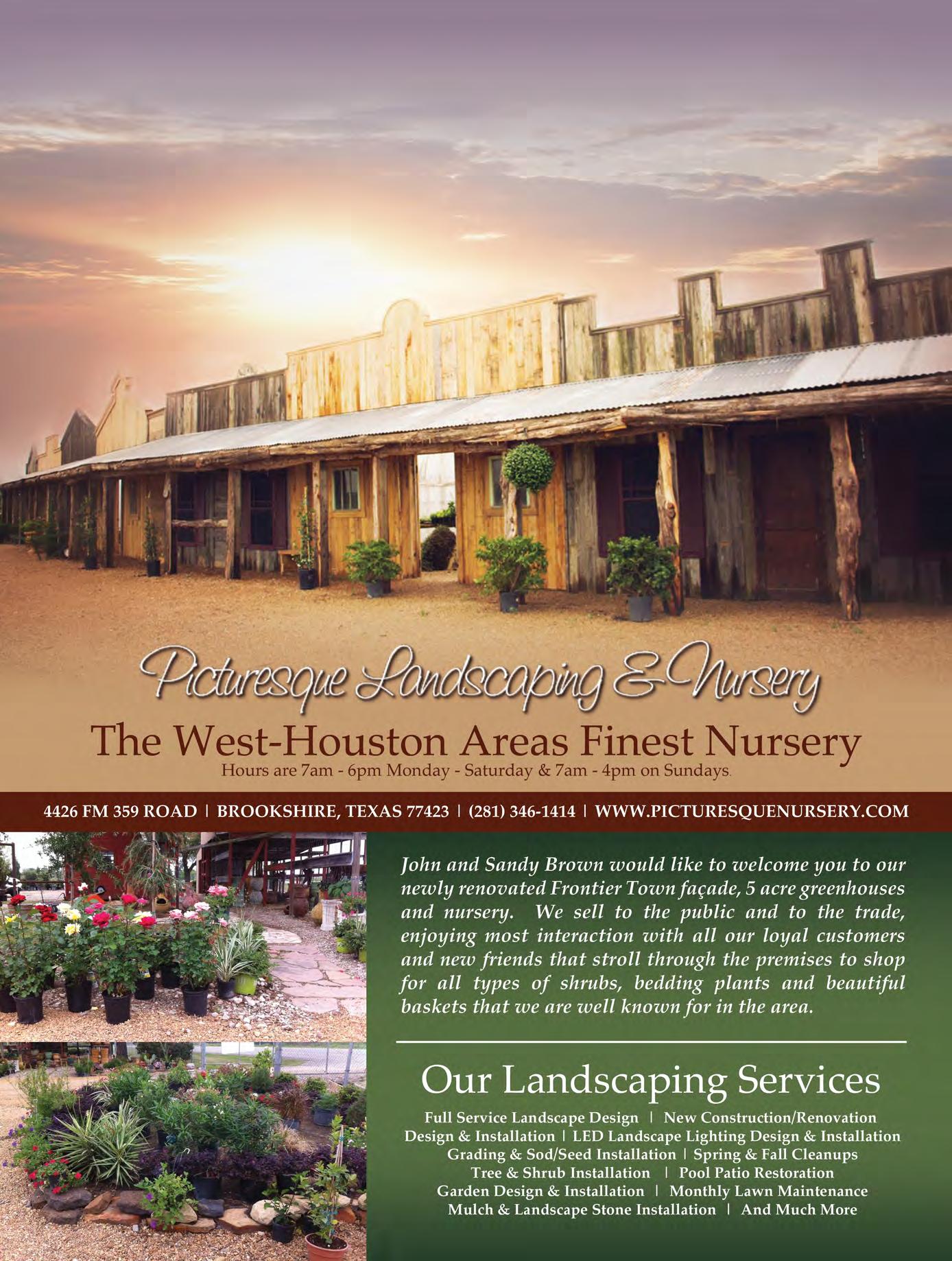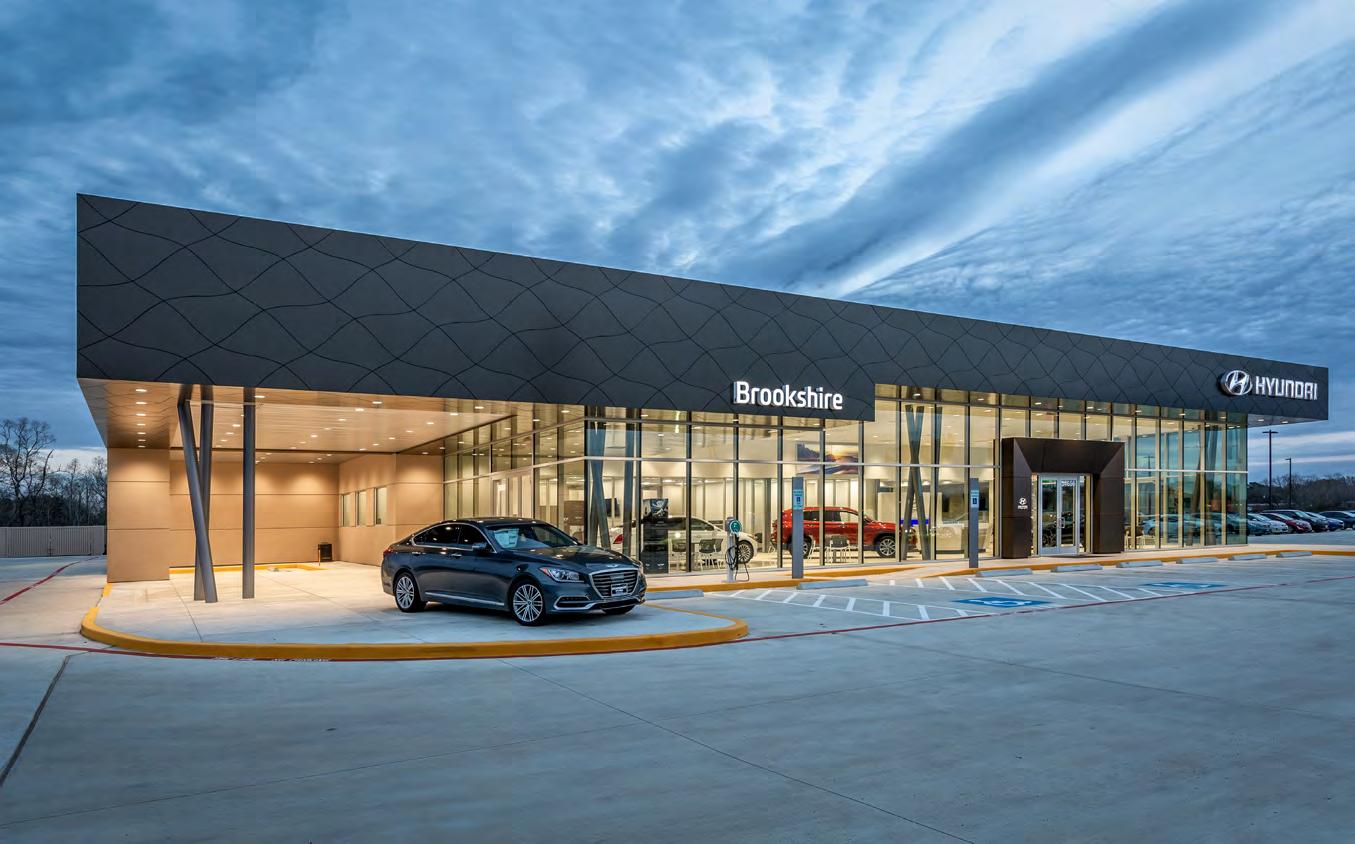
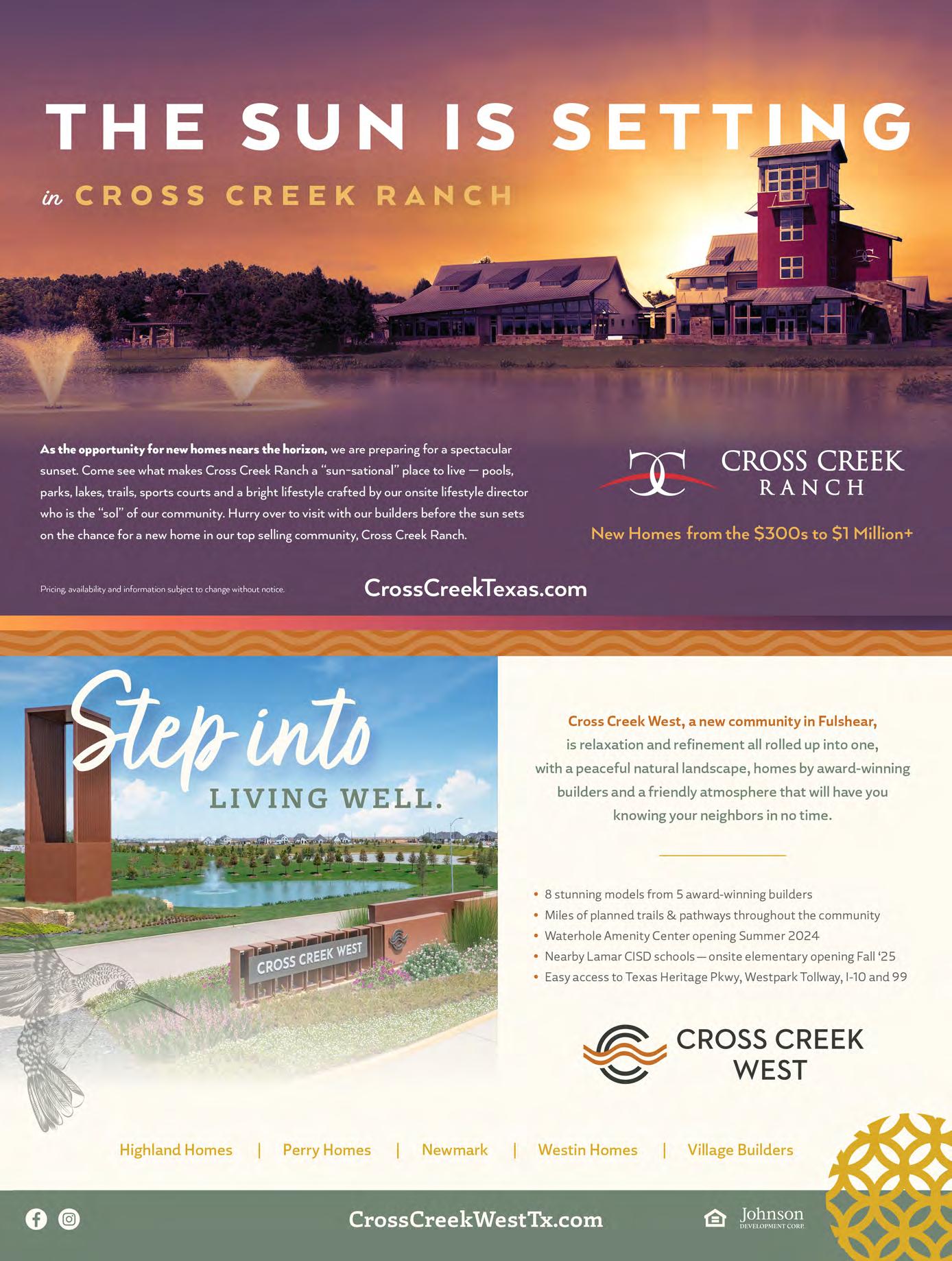
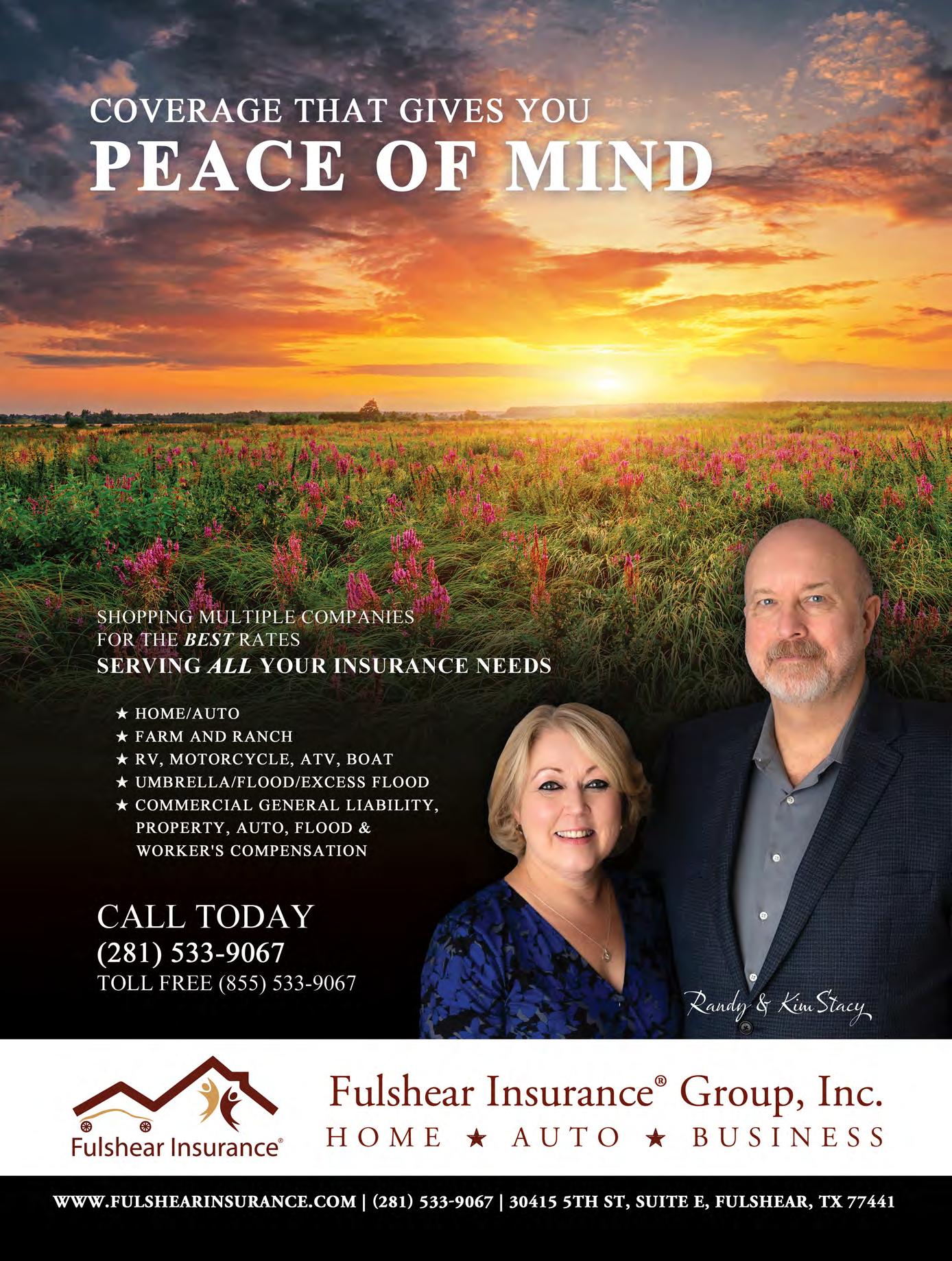









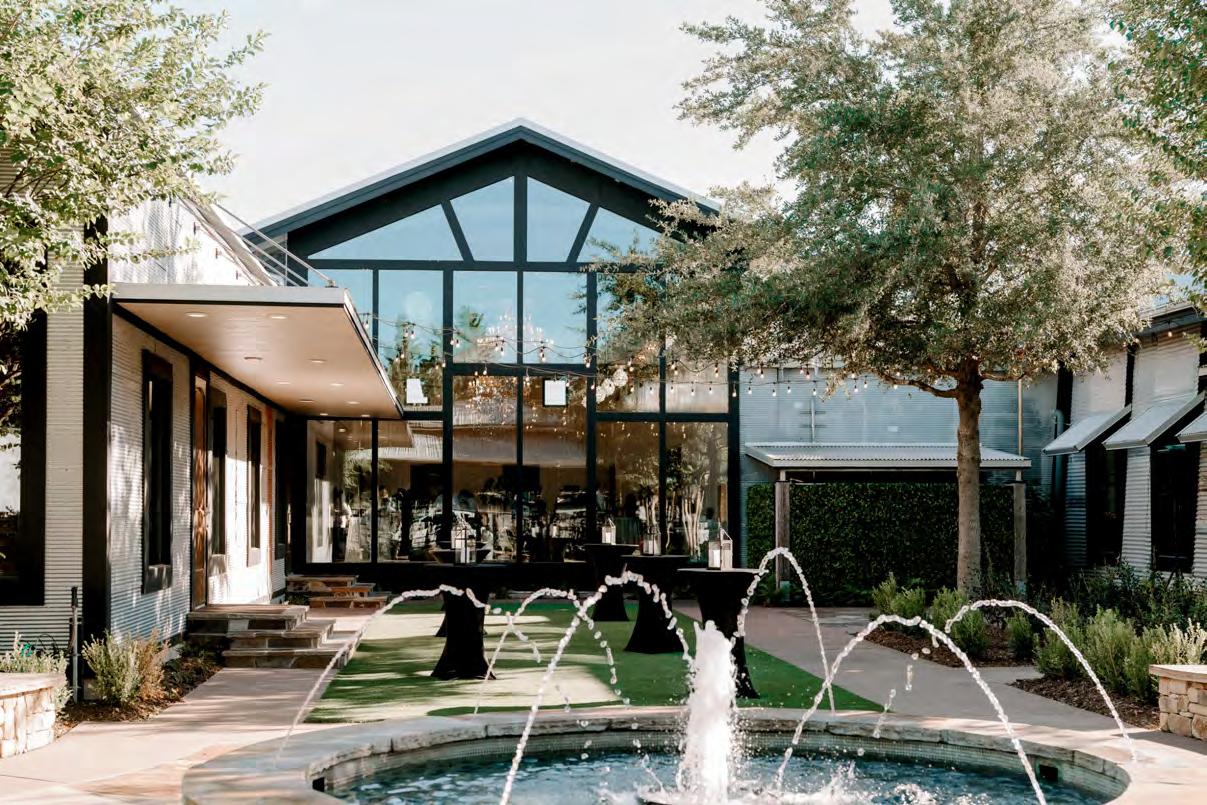







































Convenient, easy-to-access locations for primary, specialty and emergency care in Katy and West Houston
We offer a full spectrum of care, including:
• Primary care physicians for you and your family, providing personal care and service
• Specialists with innovative treatments and customized programs
• Collaborative teams of experts using the newest technologies and latest research
To find care near you, visit houstonmethodist.org/katy-west or call 713.790.3333
MAGAZINE STAFF
WILLIAM PRIOR
Publisher
KATIE MECHAM Art Director
RHONDA KUYKENDALL Staff Photographer
DANIEL MCJUNKIN
Publisher Emeritas & Co-Founder
CONTRIBUTING WRITERS
APRIL
CJ MCDANIEL
DANIEL MCJUNKIN
DOUG PIKE
JACLYN RITTER
SUSAN LOWE-STRICKLAND MAT YELVINGTON
CONTRIBUTING PHOTOGRAPHERS
TRISHIA DOWNING
RHONDA KUYKENDALL
BRUNO MARTINS
RIC MATKOWSKI
GLENN CARSTENS PETERS
MICHAEL TREGUBOV
EXPLORE AMERICA, LLC
GEORGE LANE Chariman & CEO EXPLORE MAGAZINE 281-973-0633
© Copyright 2024 - Explore America, LLC All rights reserved. No part of this publication may be reproduced without written permission from the publisher.
Cover Photo:
Fulshear: sevector - stock.adobe.com
Katy: dfikar - stock.adobe.com
Contents Photo: leekris - stock.adobe.com



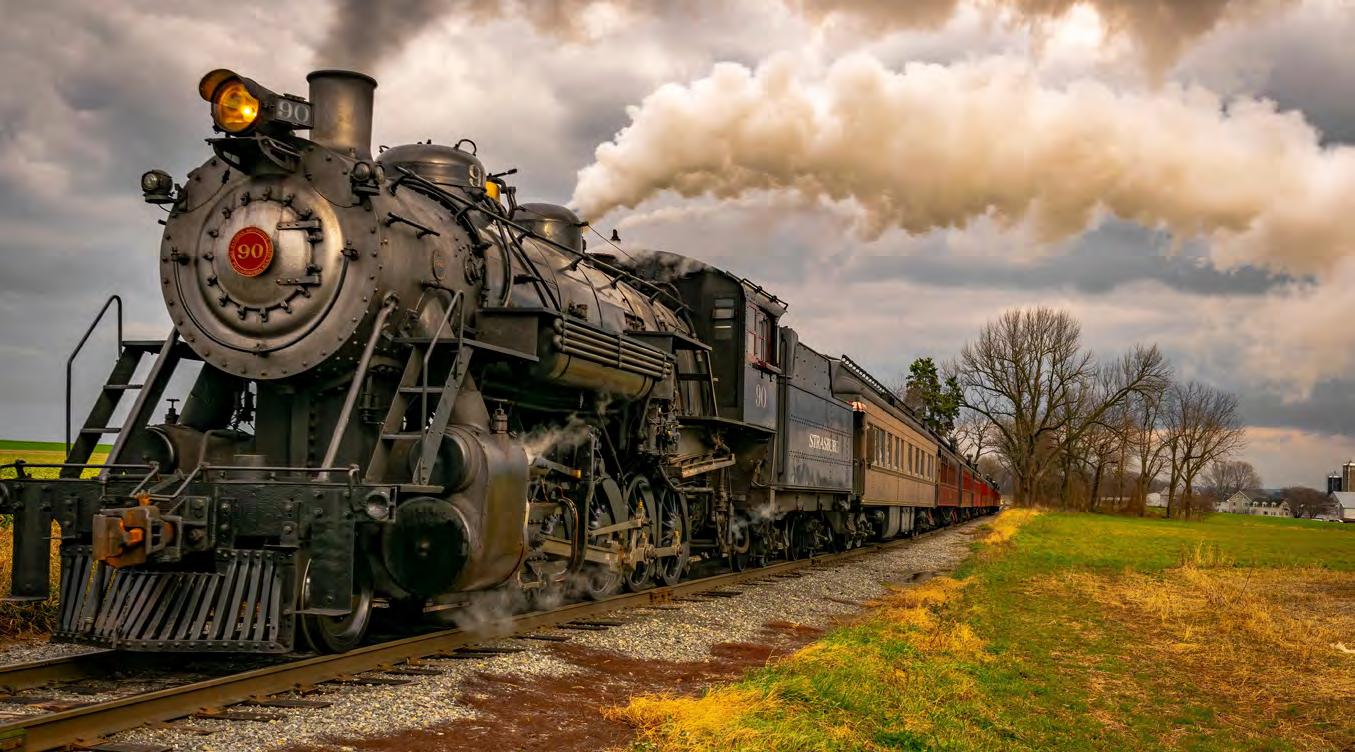
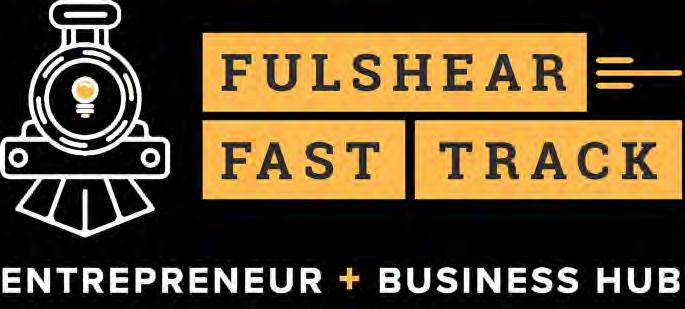

WRITTEN BY MAT YELVINGTON MANAGING DIRECTOR - FULSHEAR FAST TRACK
INthe annals of Fulshear’s history lies a narrative of boldness and foresight—a tale that begins with the thundering arrival of the railroad in the late 1800s. While neighboring towns hesitated, Fulshear seized the opportunity with a pioneering spirit that set it on a trajectory of growth and prosperity. This pivotal decision marked the birth of a community defined by its willingness to embrace change and innovation.
Fast forward to the present day, where that same spirit of innovation continues to thrive in Fulshear, now embodied in the new Fulshear Fast Track | Entrepreneur and Business Hub—an initiative funded by Fulshear Economic Development Corporation, in partnership with The Cannon Community. This collaboration further solidifies Fulshear’s commitment to fostering innovation and entrepreneurship within the community.
Fulshear Fast Track is a manifestation of Fulshear’s commitment to fostering
entrepreneurship and driving economic growth. It’s a testament to the town’s belief in the power of collaboration and collective action to shape a brighter future for all.
At Fulshear Fast Track, we believe in the potential of every individual to make a difference. Whether you’re a budding entrepreneur with a game-changing idea or a seasoned business owner looking to expand your horizons, our hub offers a wealth of resources and support to help you succeed. From mentorship programs to networking events, we’re dedicated to providing the guidance and opportunities you need to thrive.
Within our ecosystem, you’ll discover a dynamic community of trailblazers, each driven by a relentless pursuit of excellence. From tech startups to mom-and-pop shops, our community spans the spectrum of industry, united by a common goal: to push the boundaries of what’s possible.
Our online platform connects you with a diverse array of stakeholders, from fellow entrepreneurs to seasoned investors, all united by a shared passion for innovation. Whether you’re seeking mentorship, collaboration, or investment opportunities, you’ll find a wealth of resources at your fingertips.
Join us at Fulshear Fast Track | Entrepreneur and Business Hub, and together, let’s unlock the boundless potential of Fulshear’s business community. Together, we’ll write the next chapter in Fulshear’s legacy of innovation, one success story at a time.
Take the first step on this journey with us today at fulshearfasttrack.com, and let’s embark on this exciting adventure together.






Stewart Title Fulshear is conveniently located at Fulshear Town Center in historic downtown Fulshear. We are right off Main street behind the restaurants and shops. The community, established in 1890, is a special place where small town charm and pageantry meets magnificent 21st century customer service from our team of skilled escrow professionals serving this booming area of Fort Bend County. No matter if you are buying or selling properties, we stand ready to bring over 100 years of Stewart experience to help you protect your finest investments. Stop by our office today and experience the Stewart Title difference.
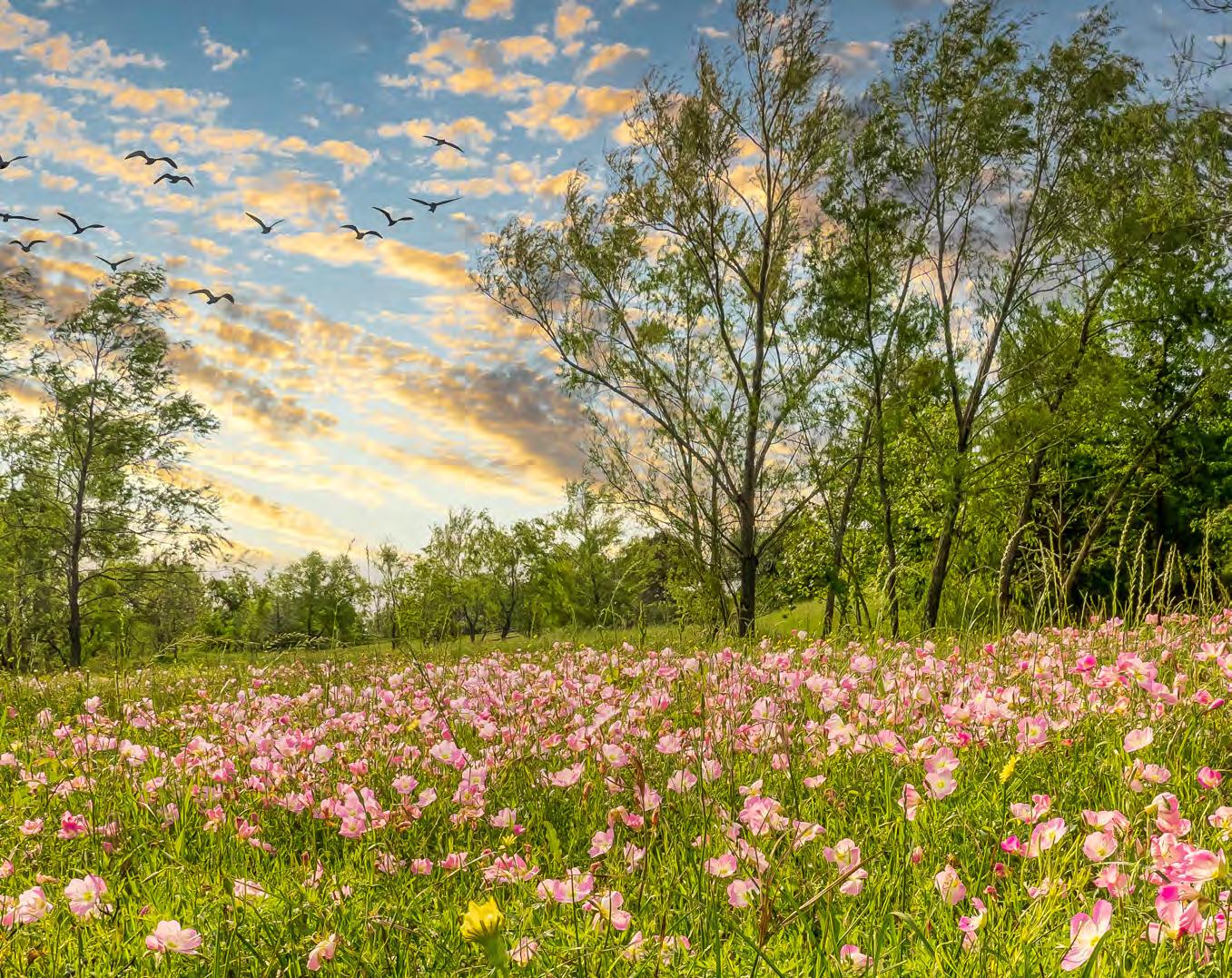

The City of Fulshear has long been viewed as a place of opportunity by its residents. The vision that began in 1824 with Churchill Fulshear Sr. remains alive today as residents from diverse backgrounds and cultures continue to be attracted to Fulshear.
IN THE LAST DECADE, FULSHEAR GREW FROM JUST BARELY 1,000 RESIDENTS IN 2010 TO AN ESTIMATED 33,000 IN 2023 AND THERE ARE NO SIGNS OF SLOWING DOWN.
Our newest residents are drawn to the highly ranked Lamar CISD and Katy ISD as well as the beautiful masterplanned communities that offer a range of housing
options, amenities, and services for all ages. Fulshear is the fastest-growing city in the Houston metropolitan area and is anticipated to be one of the largest cities in Fort Bend County.
It continues to be a top destination for talent and businesses in the greater Houston region with a highly educated, affluent population. With more than 40% of the population having attained a Bachelor’s Degree. Situated within the strong microeconomies west of Fort Bend County, Fulshear offers easy access to major highways, airports, ports, and railroads making it an ideal location for various businesses.
Zach Goodlander, Assistant City Manager of Fulshear shared his personal experience about what factors motivated him to make Fulshear his home.
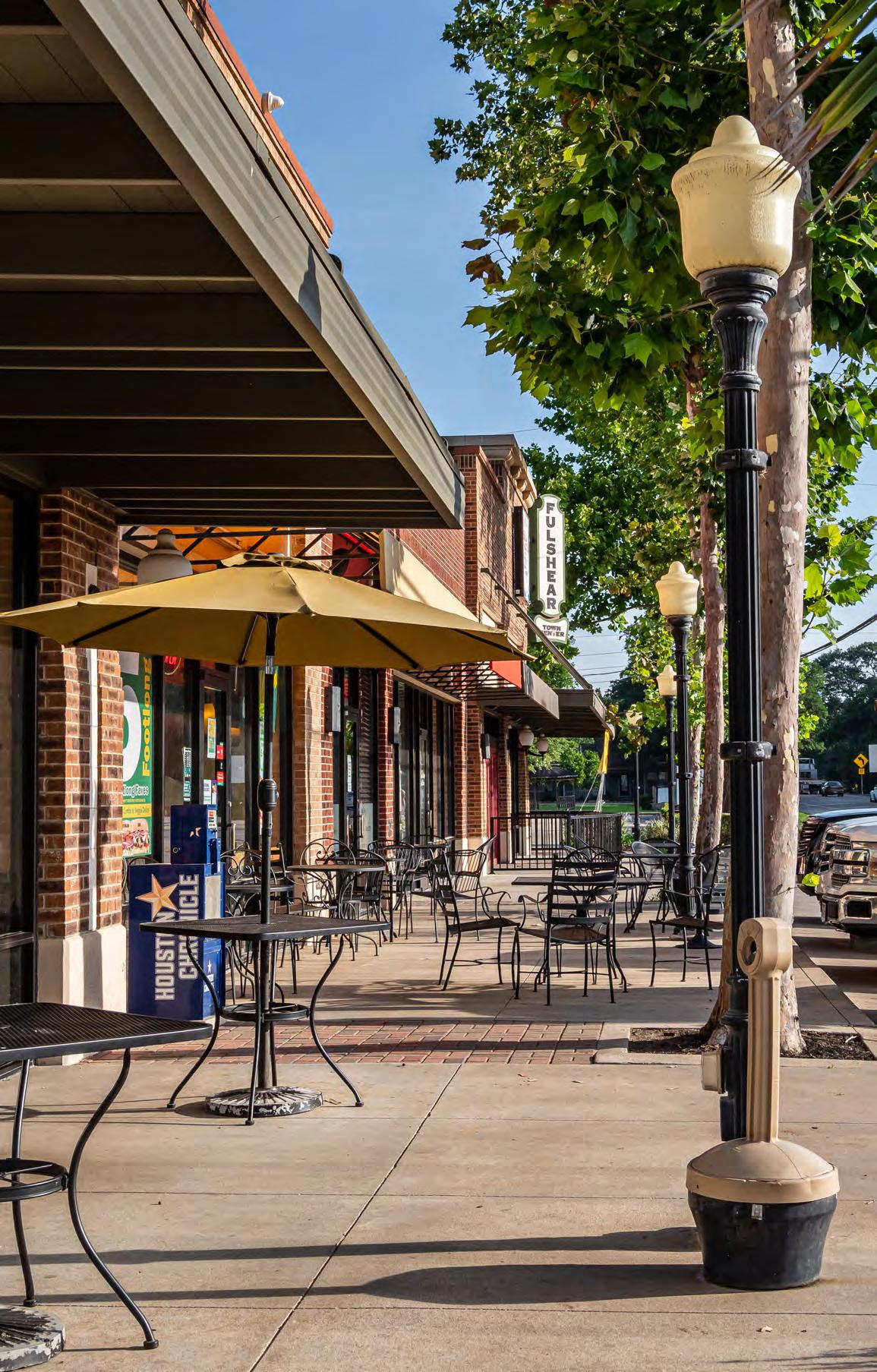
“LIKE MANY OTHERS, I’VE CHOSEN TO LIVE IN FULSHEAR BECAUSE I BELIEVE IT COMBINES GREAT MASTER-PLANNED DEVELOPMENTS, WITH CLOSE ENOUGH AMENITIES, ALL WHILE PRESERVING A UNIQUE SENSE OF COMMUNITY. AS MUCH AS WE CAN IT WILL BE IMPORTANT TO PROTECT THE CHARACTER OF FULSHEAR WHILE ALSO CONTINUING TO ATTRACT NEW RESIDENTS AND BUSINESSES THAT ENRICH OUR COMMUNITY.”
As the growth continues the community is quickly adapting to ensure a continued high quality of life desired by the residents. Andrew Van Chau, President of the City of Fulshear Economic Development Corporation said that the goals of the Economic Development board are to meet the retails needs, attract larger employers, and offer residents career options closer to home. Ultimately, diversifying the revenue base of the city to sustain infrastructure and services needed by the community.
“Our City experienced tremendous growth over the last 20 years in great part due to significant investments in infrastructure and prime residential developments, paired with great schools that attracted families from across the Houston Region and beyond. Although it’s been challenging to maintain elements of small-town charm and close connection between neighbors, our residents and organizations like the Fulshear-Katy Area Chamber, Rotary Club, Scouting and many others make Fulshear continue to feel like the special place that it is by hosting community events, pursuing opportunities to help one another and so much more.”
The City recognizes that with growth comes a great responsibility to improve infrastructure in order to ensure the best services and goods for our community. Currently there are various ongoing efforts to make improvements to downtown on Harris Street and Wallis Street. A focus has been placed on detention and drainage improvements to support smaller properties and development in the area. Fulshear is working towards ordinances that bring buildings to the street in order to create a more traditional, walkable downtown.
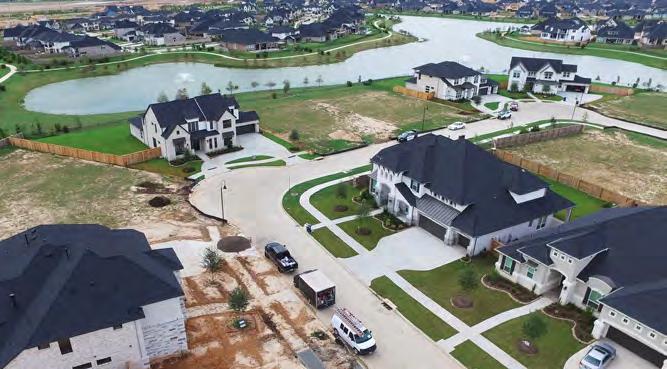
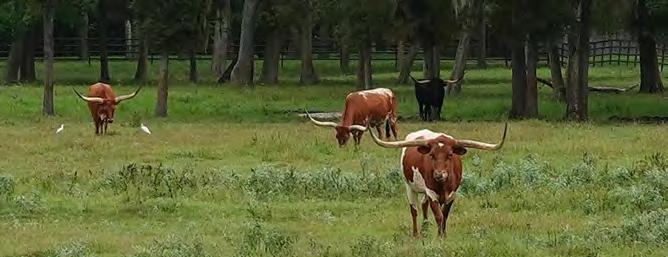
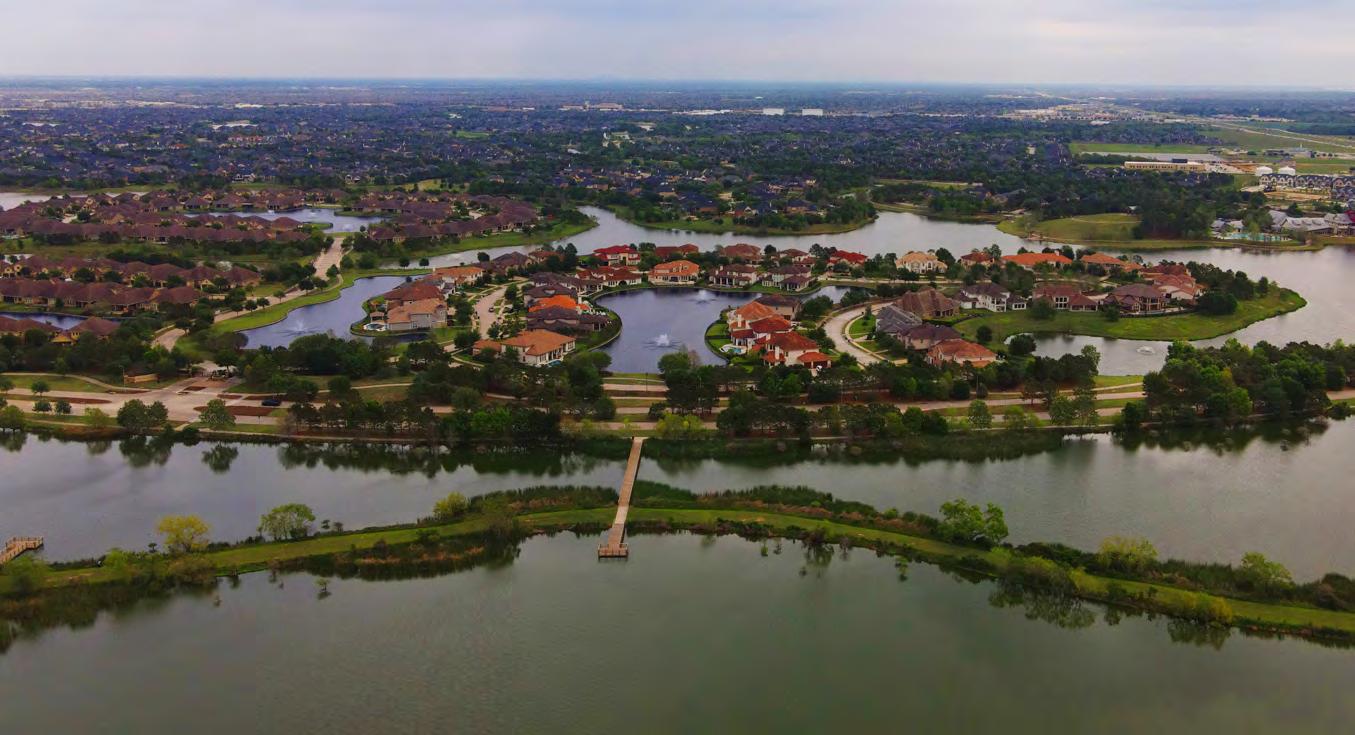
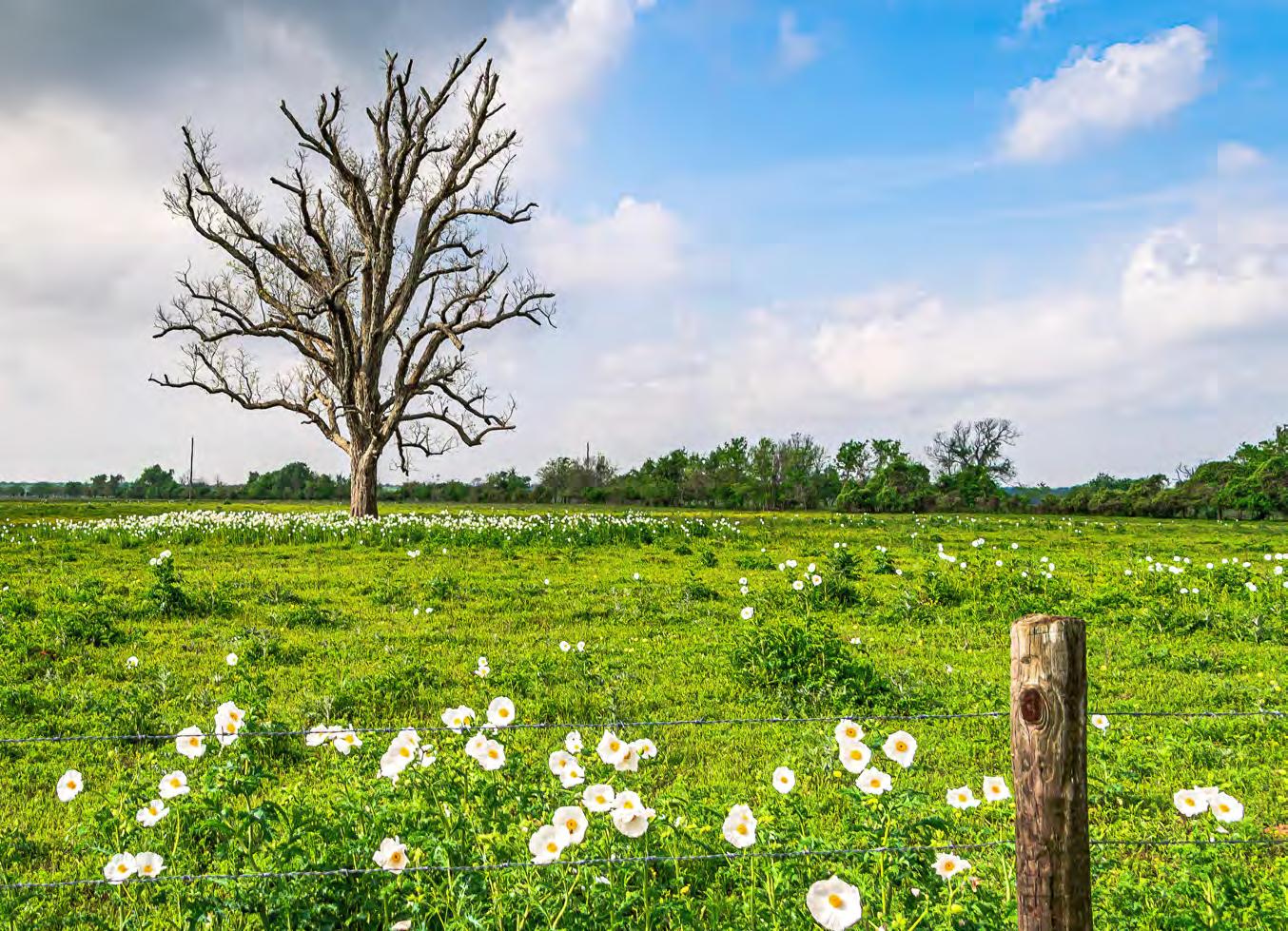
Former Mayor and Fulshear Development Corporation President Tommy Kuykendall says, “Fulshear began when Churchill Fulshear received a land grant from Stephen F. Austin in 1824 as part of the Old 300 who settled Texas. Fulshear embraced the San Antonio and Aransas Pass Railroad to firmly establish our place as a City along the route. With our explosive growth it is important to remember the history of Fulshear and our early town leaders’ contributions while striving to transform the sea of rooftops into a sustainable mix of parks, trails, retail and commercial centers, and all the support services a community needs to thrive. We have taken great strides to develop plans for the foundation of a great downtown and the time is now to implement those. Local businesses are the backbone of Fulshear’s success. I want to renew our focus on downtown Fulshear and create additional ways we can bring the community together helping build a true sense of place. Fulshear is not just a City, but our home and we all can play a part on telling Fulshear’s story and helping build our sense of place and community.”
FULSHEAR IS A CITY THAT WELCOMES YOU TO JOIN ITS GROWING AND PROSPEROUS COMMUNITY, WHETHER YOU ARE LOOKING FOR A PLACE TO LIVE, WORK, PLAY, OR INVEST, FULSHEAR HAS SOMETHING FOR YOU.
to learn more about the opportunities and benefits of doing business in Fulshear. Email us at ecodev@fulsheartexas.gov or call (281) 346-1796.




WEDDING & SMALL EVENTS VENUE




The ultimate open/enclosed wedding venue just west of Houston, Texas! We offer four unique and flexible venues that will transport you to an oasis all your own.
From saying “I do” in our Spanish mission-inspired chapel overlooking the river, to a reception unlike any other in our awe-inspiring Palapa. Your guests will be ushered through the grounds for an unforgettable experience.
WRITTEN BY DON McCOY
Being Mayor of Fulshear, Texas, I fully understand the immense responsibility of being a leader who listens and truly represents the community. My goal is to be the voice that carries the concerns and aspirations of Fulshear’s citizens and business owners to the table of government. I will ensure that every decision made reflects the diverse perspectives and interests of our vibrant town. I am dedicated to fostering transparent communication, advocating for inclusive growth, and building a Fulshear where everyone’s voice is heard, valued, and represented in shaping our future.
In just a decade, Fulshear, Texas, has undergone a transformation from a quaint town of barely 1,000 residents in 2010 to a thriving community of over 34,000 today. Nestled in the third most diverse county in the U.S., change is not just imminent; it’s already here. Change can be constant and daunting, but it also brings opportunities. As Mayor, I will be committed to harnessing these opportunities to ensure prosperity for all our residents, backed by confidence and a clear vision.
Since Churchill Fulshear Sr. laid down his vision in 1824, Fulshear has been a beacon of opportunity. This enduring vision continues to attract individuals from various backgrounds, contributing to our rich cultural diversity.
Our top-tier schools, Lamar CISD and Katy ISD, are a magnet for new families, setting the stage for lifelong learning. Complementing our educational facilities are beautifully designed master-planned communities. These neighborhoods offer a plethora of housing options and amenities catering to all life stages, enriching our residents’ lifestyles.
As the fastest-growing city in the Houston metro area, Fulshear is poised to become one of the largest cities in Fort Bend County. Supported by a highly educated
June 3 to June 11, 2024
MAYORAL RUNOFF ELECTION DAY June 15, 2024
population, with over 40% holding Bachelor’s degrees, our community is ready for continued economic growth and prosperity.
Fulshear sits at the heart of Fort Bend County’s strong micro-economies, with unrivaled access to major transportation networks including highways, airports, ports, and railroads. This strategic positioning makes our city an ideal spot for businesses to flourish and expand.
As Fulshear grows, so do the expectations for maintaining the high quality of life that defines our community. My administration will be focused on expanding retail options, attracting major employers, and enhancing career opportunities locally. Diversifying our economic base is essential for sustaining our infrastructure and services.
With our rapid expansion comes great responsibility. My office will be dedicated to improving our city’s infrastructure, focusing on vital areas such as Harris Street and Wallis Street in downtown. We also will prioritize our water delivery, detention and drainage enhancements to facilitate sustainable development. Efforts will continue to create a walkable downtown and our community enriched with parks for everyone to enjoy.
Despite our significant growth, it is crucial to preserve the small-town charm that makes Fulshear unique. Community organizations like the Fulshear Regional Chamber of Commerce, Rotary, Lions Club, Forever
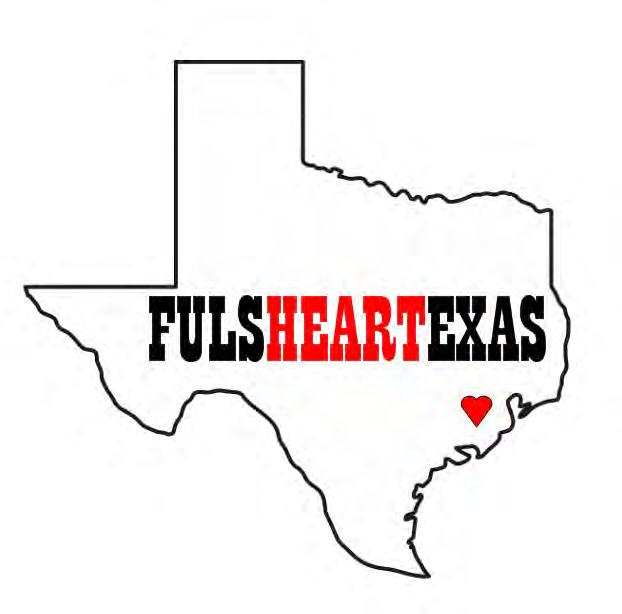
Fulshear, Family Hope and many more are instrumental in fostering strong community bonds. Our commitment to hosting community events and supporting each other will help ensure that the spirit of Fulshear remains vibrant. Let’s show the world that Fulshear is where the heart is…because it is…right in the middle of our name: FulsHEARTexas!
Fulshear’s journey of growth is a clear indicator of our city’s vast potential. As Mayor, I am dedicated to guiding us through these changes with a firm hand, a clear vision, and a prosperous future for all. Together, with active community involvement, we can achieve our goals while preserving the charm that makes Fulshear a special place to call home.
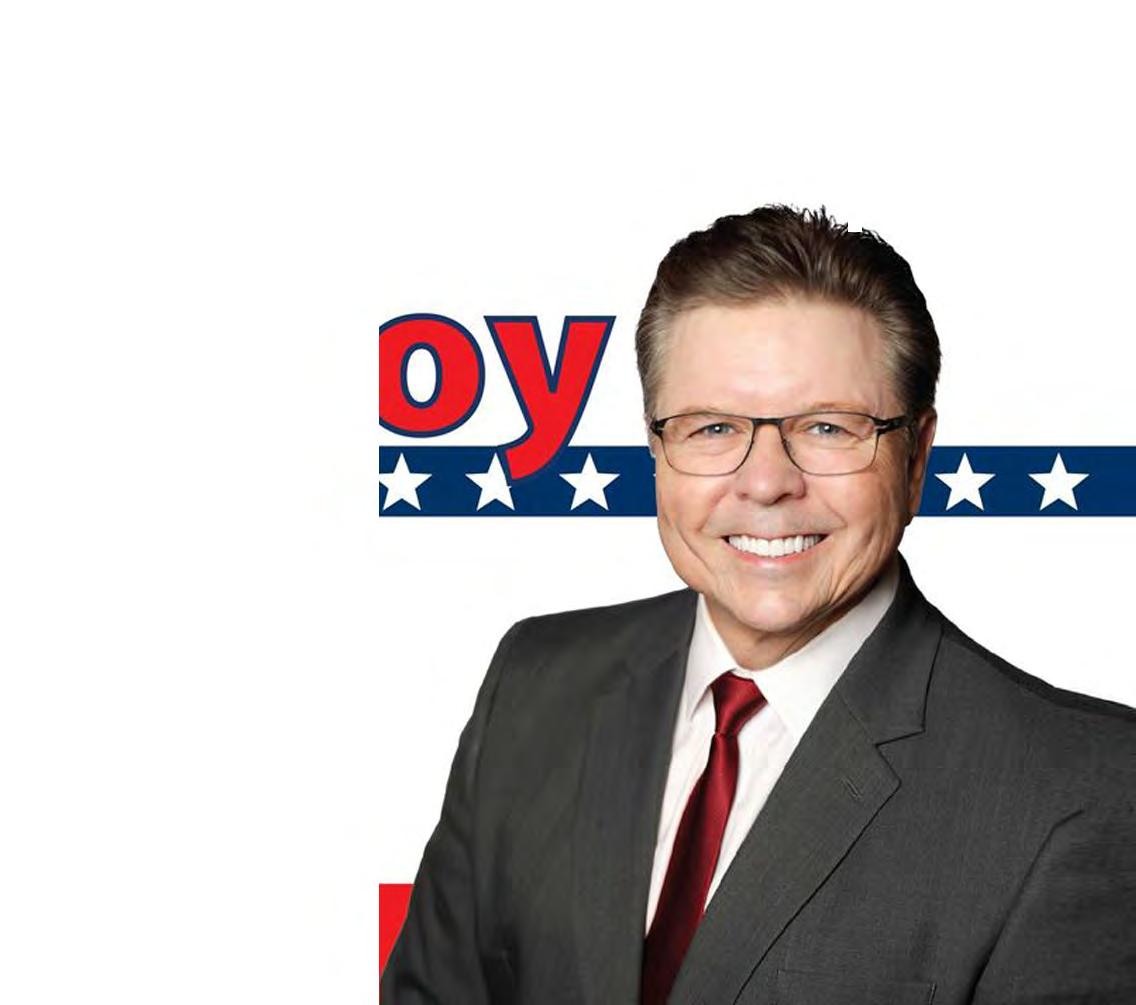
Thank you for entrusting me with the future of our beloved city. Let us move forward together, embracing change and seizing the opportunities that lie ahead. Don McCoy
WWW.VOTEDONMCCOY.COM
WRITTEN BY CJ McDANIEL MANAGING PARTNER, CRENSHAW GOLF
Of all the tools in the golfer’s sack none is as personal to him as his faithful trusty putter.
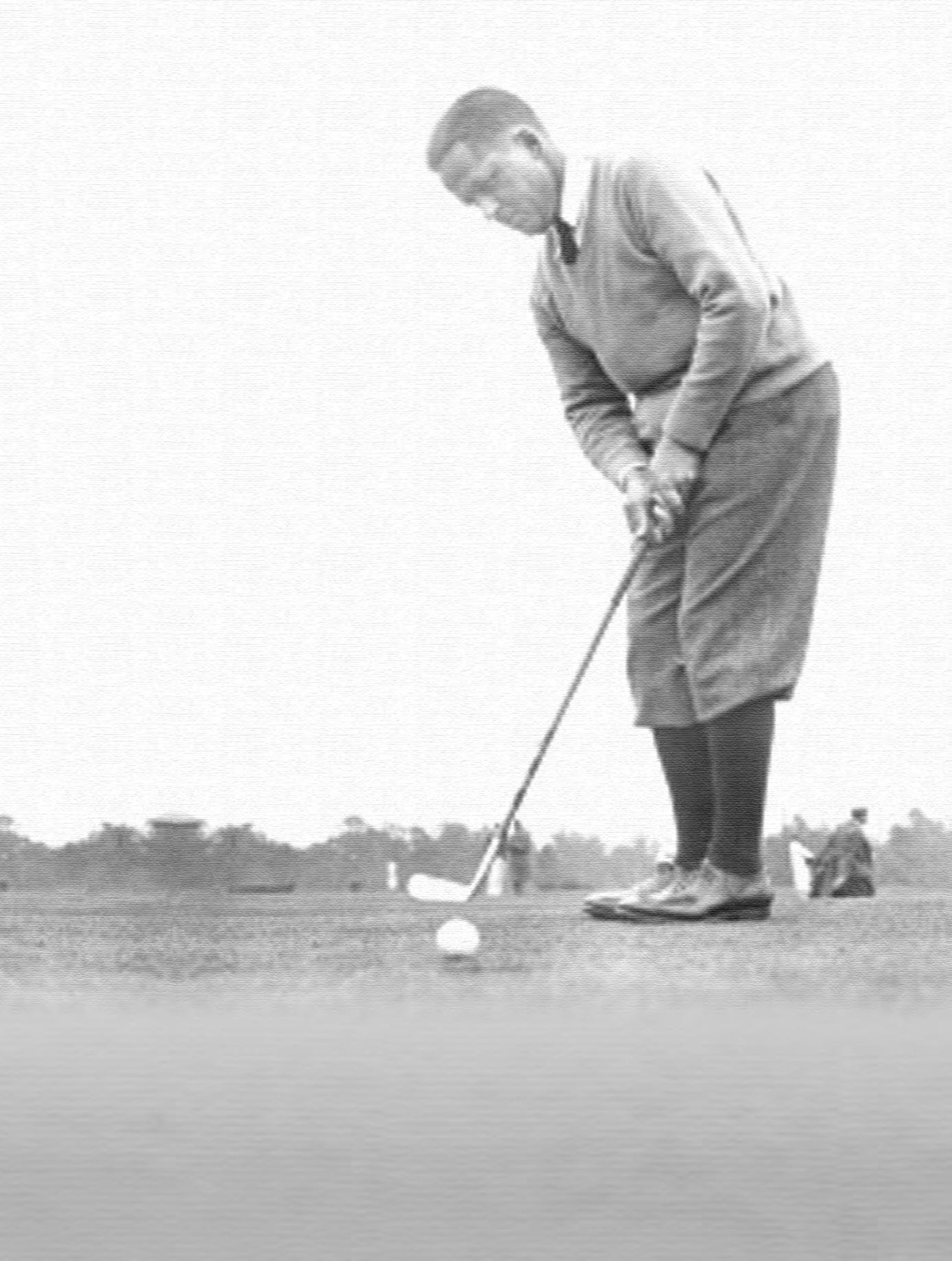
Bobby Jones, when he won the Grand Slam (the British Open and Amateur and the US Open and Amateur) in the same year, did it with the help of a special friend he called Calamity Jane, a hickory shafted stick with three narrow bands of whipping at the base. Those little wisps of thread might have made all the difference to Bobby Jones, but subsequently did little for anyone else when the design for Calamity Jane was mass produced.
Calamity Jane is probably the best known of all putters used by great golfers. And as much as Bobby Jones loved it…and as well as it worked for him, it was rusty and sort of beat up, and no doubt had several owners before it ever got to him he once said. Charles Price, one of golf’s most revered writers once said, “It is the worst putter I have ever held in my hands. If a pro left it in a barrel of clubs in his shop at a dollar apiece, nobody would buy it.” Bobby Jones using it was akin to Vladimir Horowitz performing on a dusty, out-of-tune piano in an Elks Club basement.
“IF YOU CAN FIND THE PERFECT CLUB, YOU CAN MAKE THE PERFECT SHOT.”
I’m told that of the more than 12,000 clubs in Arnold Palmer’s collection, more than 2,500 of them are putters. Arnold once said in an interview, “if you can find the perfect club, you can make the perfect shot.” When asked if he had found the perfect putter, his response was a quick “not yet!” And, Mr. Palmer is now 85 years old.
The infamous Bobby Locke is regarded as maybe the best putter of all time. At age nine, he was given a putter by an old professional, T. D. Lighthouse. It was a hickory-shafted steel
blade putter that he used until 1960 (32 years) and he finally replaced it with an identical club.
Some golfers are known to buy a new putter every month and with it continue to knock the ball harmlessly by the hole, usually never even scaring the cup. American golfers purchase putters like jelly beans. According to DataTech, sales of putters in 2012 was $152,000,000. No, I did not add too many zeros, I meant million! Thinking about this in terms of cash…I was told that 10,000 one hundred dollars bills can fit into a briefcase and weigh about 20 pounds. Let’s see, that would be 152 briefcases; not even Southwest Airlines will let me on with that many bags for free. The average price of a putter in 2014 was $145. I have a friend who bought 13 used putters last year.
So what about Ben Crenshaw, the best putter in the modern era. He has putted with the same putter for a career. He started using “Little Ben” when he was 15 years old and won 21 times with it on the PGA Tour including the 1984 Masters. That’s a pretty special relationship with such an inanimate object. Over that time it has been stolen, lost and even kicked a few times. But, has always found its way back to Gentle Ben. The model is actually a Wilson 8802. Charlie Crenshaw, Ben’s dad said of the original 8802, “It was just a putter in Harvey Penick’s shop. Ben felt it and waggled it around for a while. ‘Dad, I’d like to have it,’ he said, so I bought it for him. That club’s been the best provider in the family.” The putter cost Crenshaw’s dad $20.
trend that’s continued to this day: heel-toe weighting in putters (and perimeter weighting in all other clubs). Solheim’s PING putters spread the weight towards the heel and toe to minimize distance loss on off-center hits, effectively enlarging the sweet spot. Almost every putter today uses heel-toe weighting.
So, here we are in the age of social media, high technology, exotic metals, new kind of polymers and every shape you might imagine on a putter. There have been so many designs over the years that the ruling bodies of golf, the United States
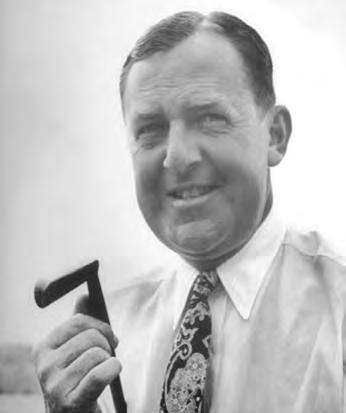
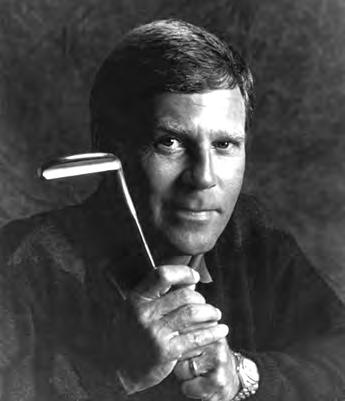
Technology in putter design never entered the picture until an unknown named Karsten Solheim came along in the 1960s. He was an engineer at General Electric and somewhat a golf nut. His engineering background and his passion for golf combined in his Phoenix garage where he began working on his putting game not by practicing his stroke, but by creating a new putter. Though he made several playable prototypes, only one made it out of his garage in the end: the original PING putter, so named by his wife because of the sound the putter made when it struck a golf ball. He received a patent on the original PING way back in 1959.
Solheim’s Anser putter - a revision of the original PING - was used by Julius Boros to win the Phoenix Open in 1967, and sparked a
Golf Association and the Royal and Ancient Golf Society have established guidelines for putter design. I definitely won’t bore you with the details, but there is an entire section in the Rules of Golf dealing with all the elements of the putter.
And me? Well, I started playing with a used set that came with a putter that had a brass head that looked kinda like a putter head. The shaft was some kind of fiberglass or resin, but definitely not hickory or metal. It had a leather grip that had to be 35 years old and had one wrap of dirty white medical tape around the top. And you know what….I putted great with that putter. I used it the entire time I was learning the game (which at 70, I am still doing). But along the way, I ended up with one of those famous old 8802s like Little Ben…and I used it from 1970 until 2005 when I finally decided that maybe this technology stuff would help me make more putts. Guess what? The only thing that will help me make more putts is to make the hole bigger. Lee Trevino told me once, “listen, partner, it’s not the arrow, it’s the archer.”
I know exactly what he meant. Equipment has helped many of us, but the talent is the key. But, that is not what makes golf so great. Having played the game since I was 21 and having had the fortune of being involved in many different facets of golf, I can say without any hesitation that it truly is the game of a lifetime, whether you are a good putter or not and whether you have an old rusty putter or a bright new Scotty Cameron. What other sport can you play well into your 80’s with people your own age or even younger and have pure enjoyment of the game in common. There is just something about the fresh air and the smell of fresh cut grass that makes a golf course special.
I was told that the easiest shot in golf is the fourth putt…the good news is I don’t ever remember that happening….maybe it did and for my own good, I blocked it out. But, I do know that our goal in our company is to help people to enjoy the game more. Ben Hogan told me once, “As you walk down the fairway of life, you must smell the roses, for you only get to play one round.”
And remember, “Golf is a game invented by the same people who think music comes out of bagpipes.”
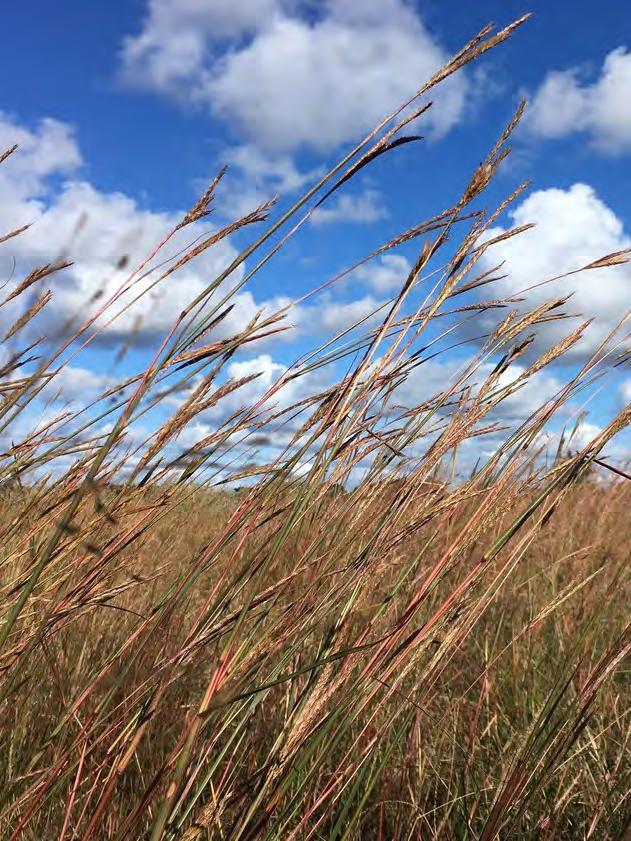

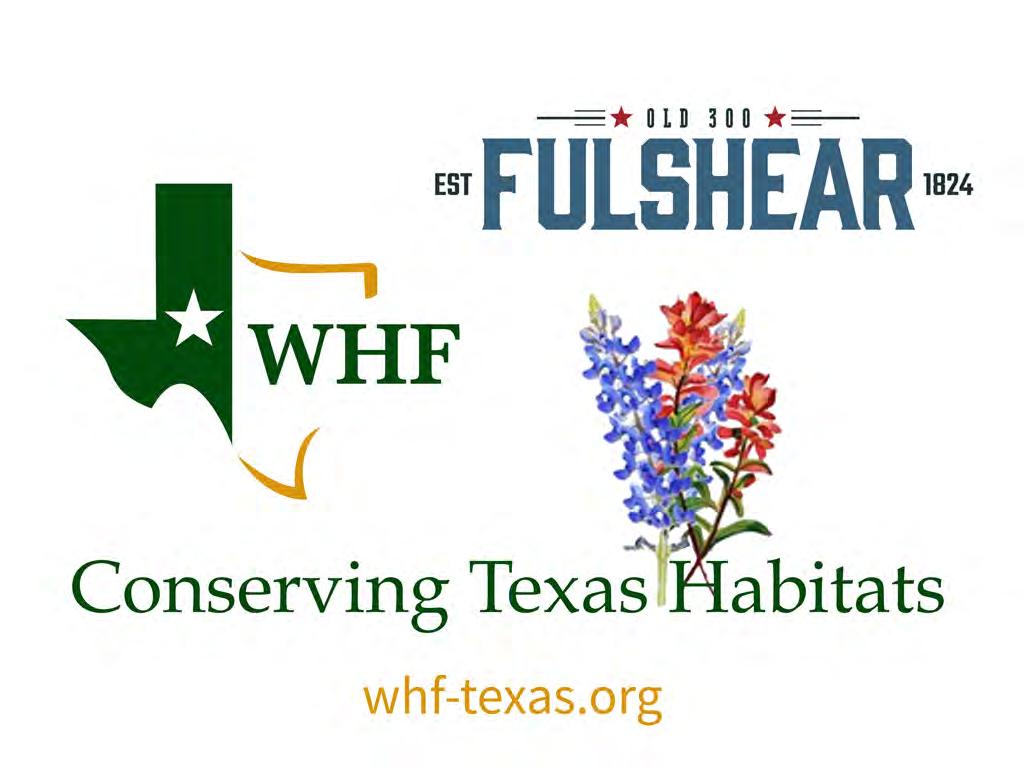
WHF has provided direct assistance to more than 300 farm and ranch owners.
WHF has worked in over 50 counties in Texas.
WHF has provided and implemented over 115,000 acres of conservation plans.
• Management Plan Development 116,240 Acres
• Prescribed Burns Implemented 2,224 Acres
• Herbicide Applications 15,116 Acres
• Cover Crops Planted 7,049 Acres
• Native Grasses and Forbs Planted 5,178 Acres
• Enrolled in Financial Programs 15,476 Acres
• Grazing Plans Implemented 62,312 Acres

1. EDUCATION AND OUTREACH: Direct technical guidance to landowners through planned outreach at conservation and environmental events, field days, workshops, group engagements, and on-site consultations.
2. CONSERVATION PLANS: We engage land managers in the planning of conservation practices with the goal of providing measurable improvement of all natural resources present in each project.
3. IMPLEMENTATION: We are directly involved in the planning and implementation of hundreds of acres of improved management as a result of planned grazing, prescribed burning, rangeland plantings, stream management and other critical environmental elements.
4. COLLABORATIVE ALLIANCES: We engage with like-minded organizations to achieve common goals. This symbiotic relationship is accomplished by co-hosting education and outreach events with allied organizations to inform the public of our land conservation practices and programs.
OUR MISSION: to provide on-the-ground restoration, management, and generational sustainability of prairie habitat for the conservation of soil, water, air and wildlife.
OUR VISION: to accomplish this through resilient prairies and healthy watersheds that will provide benefits to our land and water resources as well as the communities that depend on them.
SHORT TERM GOALS
1. To generate a reserve fund of $500,000 to insure one year’s operating expenses.
2. To establish six new grants from local individuals and corporations or other foundations.
3. To further educate the public on the value of preserved native prairie land and its conservation benefits in terms of carbon sequestration and water retention.
LONG TERM GOALS
1. To create an endowment of $3,000,000 to ensure the future goals can be attained.
2. To secure six new corporate or individual/foundation relationships that will partner with WHF on the continuing conservation programs of WHF.
3. To grow our direct conservation programs from 110,000 acres to 1,000,000 acres over the next five years.
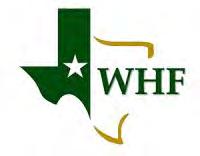
WHF-TEXAS.ORG
PO BOX 75 CAT SPRING, TX 78933
(210) 422-1600
WHF-INFO@WHF-TEXAS.ORG
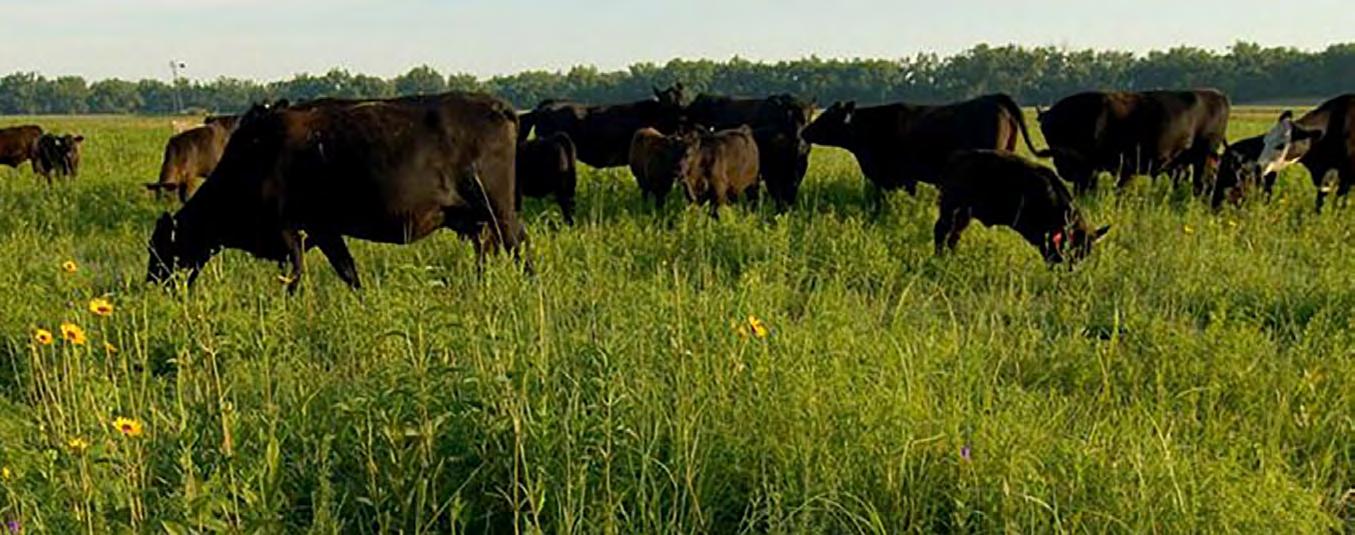
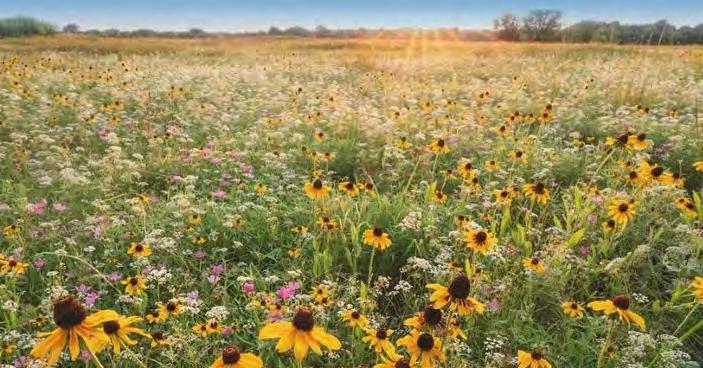
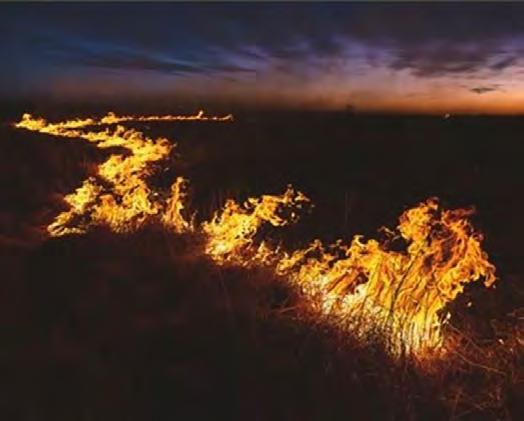
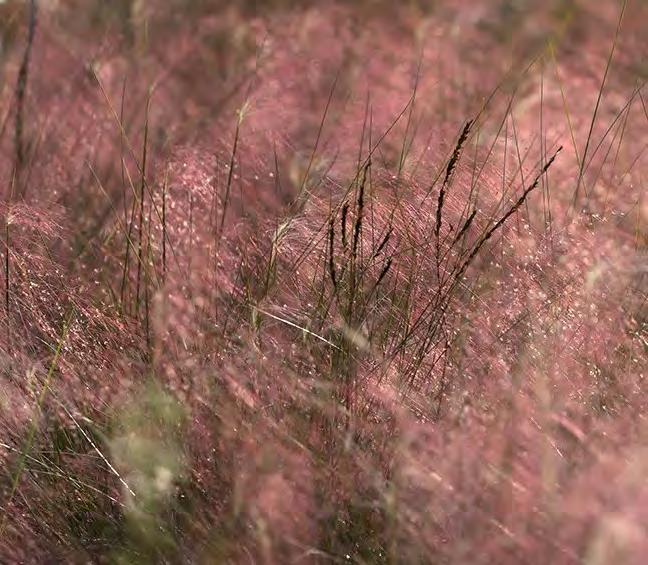
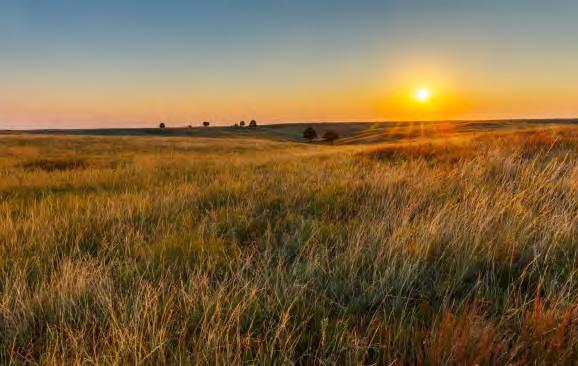


Family owned businesses are the backbone of our American economy. According to Business Week, about 40% of U.S. family owned businesses become second generation businesses. Surprisingly, only 13% are passed down successfully to a third generation.
Steinhauser’s, a modern-day general store for those who live and love the country lifestyle, has earned the right to include themselves in this rather small percentage. What’s the secret to their success? Good ‘ol hard work driven by deep rooted passion.
H. H. Steinhauser was the very best business man. He put his whole heart and soul into his seed store in Flatonia, Texas. Mr. Steinhauser was not out to make millions, he just wanted to be the best in his business. Customers were friends and his store was the hot spot in town. His son Lloyd grew up watching his dad educate customers on proper techniques and identifying the proper merchandise to raise healthy horses and livestock, as well as maintaining thriving lawns and gardens. Lloyd learned the “ins-and-outs” of the business at an early age.
In 1965 the Sealy Oil Mill went up for sale. H.H. Steinhauser purchased the mill, not with the intention of running it, but in helping his son start his own business. Originally a cotton seed processing business, H.H. expanded it to a retail feed store in 1969. In 1971 Lloyd was ready to take the reins and purchased the business from his father.
Lloyd was proud to run Steinhauser’s. His entire childhood prepared him well for the road ahead. The journey was not always an easy one, but he and his wife Virginia’s strong work ethic and business skills pulled them through. Together, the couple passed these positive attributes on to their four children.
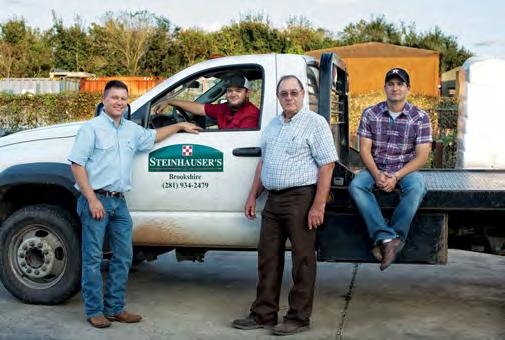
David and Mike Steinhauser have chosen to follow their father Lloyd and join the family business. “From a very young age I knew that this is what I wanted to do,” says David Steinhauser. “I never really considered anything else.”
The love and pride the Steinhauser family has for their business shows to any and all who walk through their doors. How else can one open nine successful locations in such a short period of time?
David Steinhauser cherishes the time he spent growing up in the store. His dad was his idol. “I can remember getting up each morning as a kid, excited to join my parents at the store for the day,” shares David. At the beginning it was all in fun. David and his siblings had no problem keeping themselves entertained while their parents were busy with customers. They enjoyed playing
in the grain – crawling, tunneling and burying themselves in it. For them, Steinhauser’s was an endless playground.
As they got older, the children found themselves acquiring more and more jobs around the store. After school it was straight to the store to pick up a few hours. As David recalls, this was the routine all the way through high school. The day after graduation, David found himself back at Steinhauser’s, only this time he was a fulltime employee. “This is truly all I’ve known,” David notes. “It is not a glamorous job by any means, and you don’t get into the feed business to get rich, but it is what I really enjoy.”

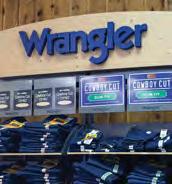
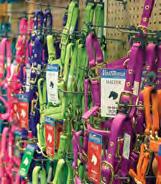
H.H. Steinhauser insisted on carrying nothing but the finest feeds in the industry. Not only that, he also provided first class service to all of his customers. Lloyd, David and Mike Steinhauser have continued the family tradition of service and quality at all nine of their locations. In fact, if you do not see what you are looking for in store, they will do their best to find it and order it. They even have you covered for all of your bulk feed and delivery needs!
“We know that we are not the only people doing what we are doing – there are other places people could go and buy our products,” says David Steinhauser. “People often choose where to shop based on quality of service over anything else, and we want to be the one customers choose.”
Steinhauser’s knowledgeable employees are able to answer questions and point you in the right direction. They provide so much more than just a product, they share experience and tried and true practices.
The success of the Steinhauser brand is attributed to strong family ties. While Lloyd, Mike and David run different locations, they operate as a team when overseeing the company as a whole.
“My grandfather was one of the hardest working people I have ever known,” remembers David. “He truly came from nothing and in turn created a life for himself and future generations.” H.H. Steinhauser never expected instant gratification. He knew that success comes from hard work, passion and sacrifice. David says proudly, “Mike and I learned what it takes to run a successful business from our father and grandfather.”
With their dedication and attention to service, Steinhauser’s will certainly continue the legacy and see a fourth generation! d
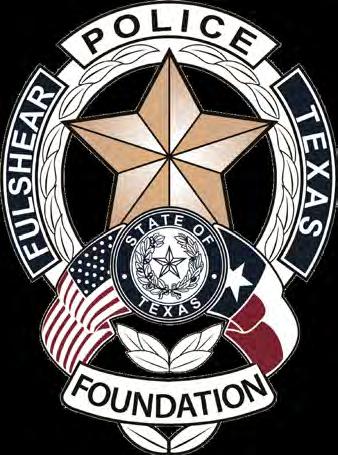

It was not too many years ago when Fulshear was just a small community with fewer than 1,000 residents. And the Fulshear Police Department was smaller as well. As Cross Creek Ranch and other new developments came to Fulshear, the increased residential community’s needs grew with them. It was about this time when the City hired its current Chief, Kenny Seymour to oversee the tremendous growth that was on the horizon.
With Fulshear’s rapid growth, Chief Seymour brought on other key police personnel, Captain Mike McCoy, Captain Lindsay Miller and other key officers.
TODAY THE POLICE DEPARTMENT HAS GROWN TO 37 FULL-TIME OFFICERS SERVING THE 25,000 PLUS RESIDENTS OF FULSHEAR.
These officers have a vast amount of knowledge and experience in areas such as Crime Prevention, Community Oriented Policing, Use of Force, Patrol Tactics, Crisis Management & Response, Narcotics Enforcement & Eradication and Incident Comand Systems.
The department is committed to maintaining the training and education of its officers. This assures that the men and women who serve the residents are equipped with the latest knowledge about laws and crime fighting techniques. The Department strives to be a model for public safety in semi-rural cities.
Crime Prevention and being proactive rather than reactive is the operating philosophy of the Department. As a result, Fulshear is fortunate to be one of the lowest crime incident cities in the state. “Quality of Life Crimes” are low due, in part, to the support of the citizens of Fulshear. The philosophy of the Department is that of a partnership with its residents.
The Fulshear Police Department has truly embraced the modern era of law enforcement, utilizing cuttingedge technology alongside a strong commitment to community engagement. Their proactive approach to policing, which integrates advanced tools like drones, body cameras, dash cameras, and license plate readers, showcases their dedication to enhancing public safety through innovation.
In today’s dynamic social landscape, where the relationship between law enforcement and the community is crucial, the Fulshear Police Department’s approach serves as a model for other agencies. By prioritizing both technological advancements and community outreach, they demonstrate a holistic understanding of modern policing, where public safety is achieved not just through enforcement, but through collaboration and mutual respect.
The Fulshear Police Department is a state accredited agency through the Texas Police Chiefs Association Law Enforcement Accreditation Program. Originally accredited in 2016, followed by a successful reaccreditation in 2020, and again in 2024, the department demonstrates its unwavering commitment to excellence
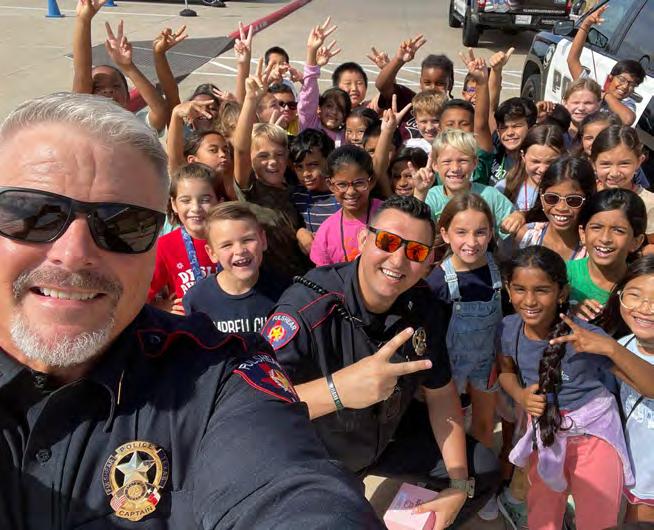
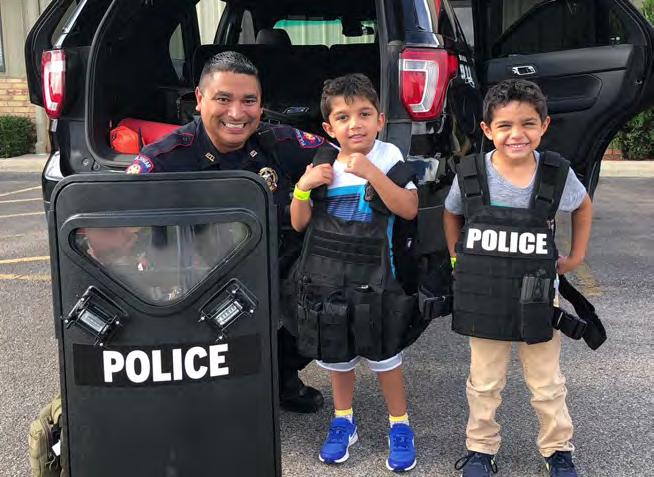
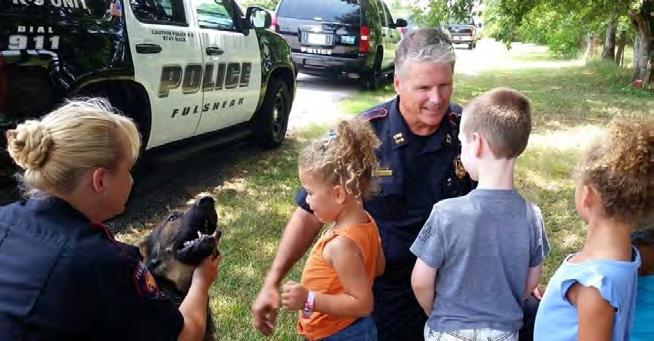
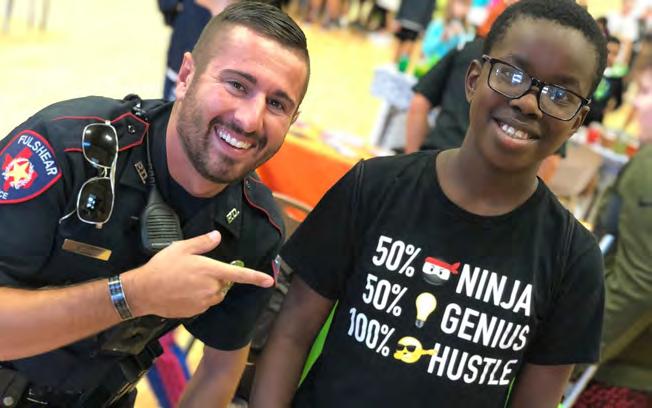
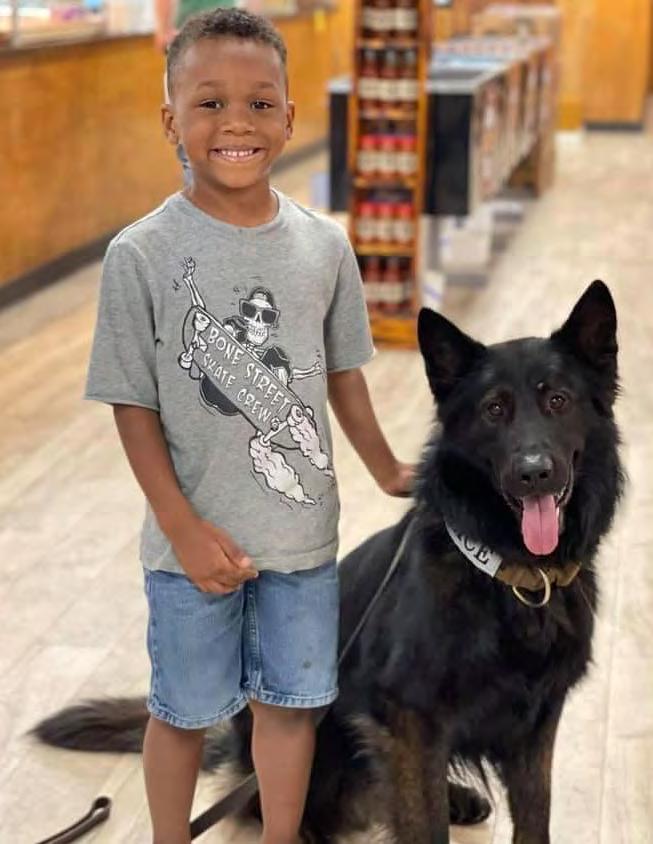

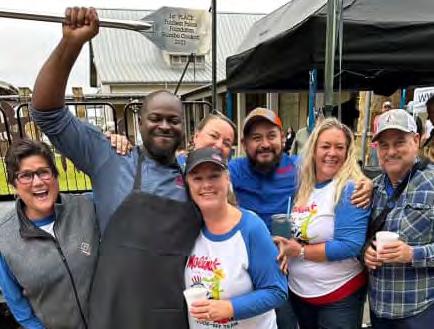
in law enforcement. Out of nearly 2,800 law enforcement agencies in Texas, only 210 have attained accredited status thus far.
During this period of tremendous growth, a couple of local citizens recognized that there was something special about the Fulshear Police Department and they met with Chief Seymour and Captain McCoy to form the Fulshear Police Foundation. Clay Stewart, a retired police officer led the charge in the creation of the Foundation in 2016.
PROVIDING
EQUIPMENT, TRAINING, AND THE TECHNOLOGY TO MAINTAIN THE EXCELLENCE, PROFESSIONALISM, AND SAFETY OF THE FULSHEAR POLICE DEPARTMENT.
This mission has been a perfect match for the philosophy of the Department as outlined in this story.
One of the primary ways the foundation achieves its mission is by providing funding for special needs within the department. Through various grants and fundraising efforts, the foundation has been able to support the police department with essential equipment and training that might now have been available through regular city budgeting processes.
Some of the grants provided by the foundation include emergency trauma/tourniquet kits, ballistic shields, a tactical trailer, LCD flares, fitness equipment, active shooter training gear, ballistic shields for officer’s protection as well as a tactical and a mobile command center. These resources are crucial for ensuring that the Fulshear Police Department can effectively respond to emergencies and protect the community.
The foundation’s commitment to supporting the police department goes beyond just providing equipment and training. The Foundation also works to foster a strong relationship between the community and law enforcement, promoting trust and cooperation. By involving the community in supporting the police department, the foundation helps to create a safer and more cohesive community.
The Foundation is a 501(c)(3) tax exempt organization. As such 100% of all proceeds to the Foundation go to the funding activities of the Foundation on behalf of the Police Department. Residents can become involved in the Foundation in any number of ways from becoming an Annual or Lifetime Member. Annual memberships are only $50 per year, or a Lifetime Membership is a one time $1,500 contribution.
By organizing various events and initiatives throughout the year, the Foundation creates valuable opportunities for residents to interact with law enforcement in a positive and constructive manner. These efforts not only strengthen relationships between the police and
the community but also foster a sense of trust and cooperation. To generate additional funds for fulfilling the grant requests by the Police Department, the Foundation has two fund-raising programs annually.
The Gumbo Cookoff, held for the past few years at the Cross Creek Ranch Welcome Center is a community wide event attracting thousands of residents to spend the day listening to zydeco music, sampling some of the areas best gumbo cook’s recipes and enjoying many activities like both live and silent auctions and various programs for both adults and kids. This year’s event is scheduled for Saturday, November 9 at the CCR Welcome Center.
Additionally, the Foundation has a Truck and Gun Raffle each year. For the past two years, the Foundation, with the assistance of Legacy Ford of Rosenberg has given away a new Ford F-150 pickup. In addition to the chance to win the truck every raffle ticket has 36 individual chances to win a great rifle, shotgun or handgun with three drawings each month throughout the year. This Raffle has been instrumental in providing funding to meet the ongoing special grant requests from the Police Department.
Overall, the Fulshear Police Foundation plays a vital role in ensuring that the Fulshear Police Department has the resources and support they need to maintain excellence, professionalism, and safety. Through their efforts, the foundation is making a real difference in the community and helping to keep Fulshear a safe and thriving place to live.
Through the Foundation’s generous donations, the Department continues to be able to supplement training and equipment, ensuring that the department maintains its high level of effectiveness and professionalism. This support allows the Fulshear Police Department to stay at the forefront of law enforcement practices, constantly improving their capabilities to serve and protect the community. The collaboration between the Department and the Foundation underscores the importance of public-private partnerships in enhancing public safety and further solidifies the department’s commitment to excellence in policing.
Should you have interest in learning more about the Fulshear Police Foundation, you can use the QR code pictured here, or go directly to the website at fulshearpolicefoundation.org. If you want to know more about how you might be able to be more involved yourself, just send an email to info@fulshearpolicefoundation.org



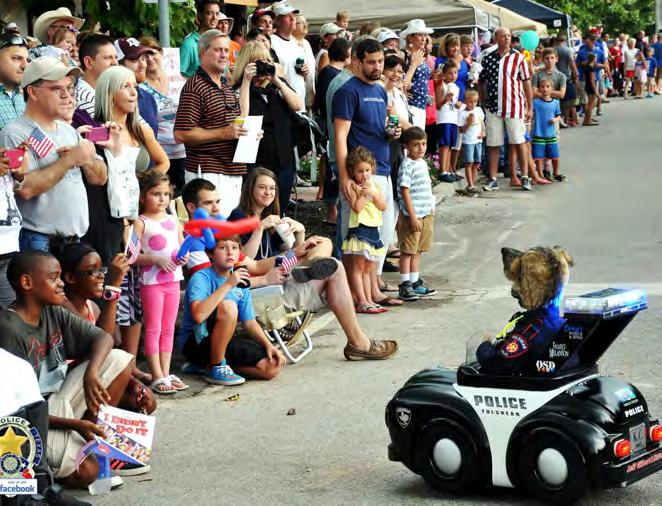
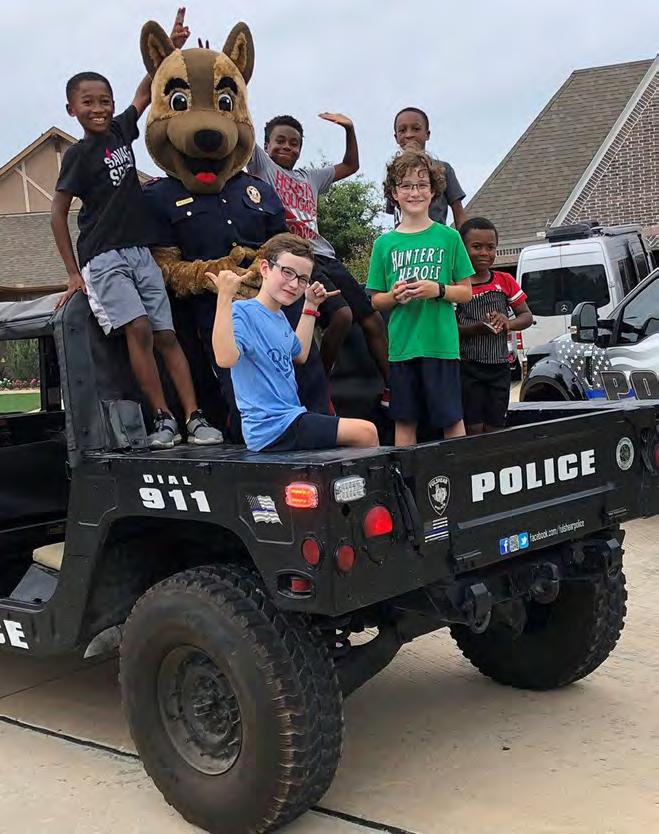


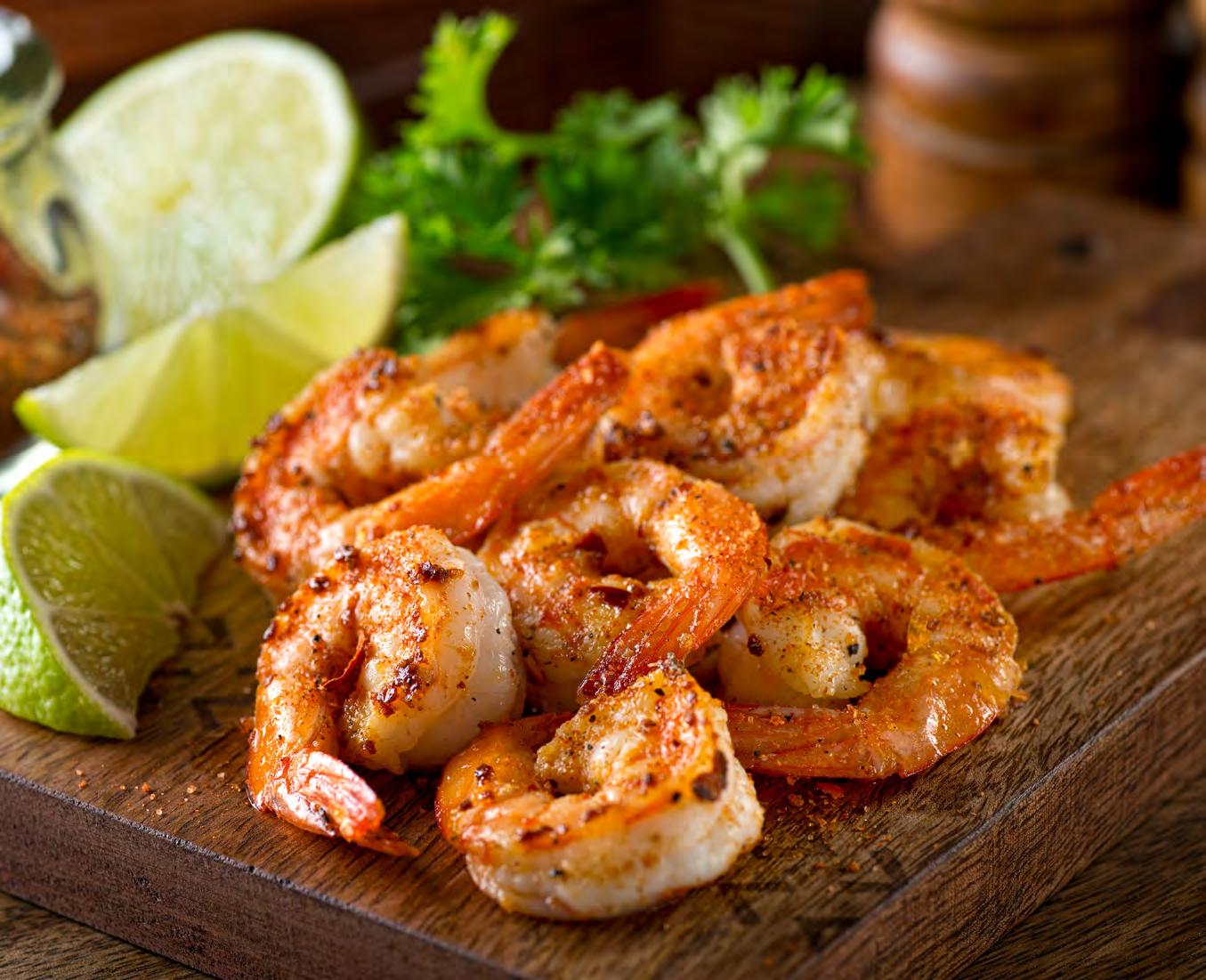

WRITTEN BY CJ McDANIEL
When the first European explorers crossed the middle of the North American continent they found awesome expanses of grasslands. There were no words to really describe the scenery. The French, who typically were known for a dismissive phrase, described it as a meadow. Englishmen with a better grasp of what we know as English seemed to be inspired and called it a “prairie.” Sometime later one of the early settlers wrote in 1841, that “for miles the prairie gently sloped, hardly presenting a bush to relieve the eye. In the distance, the green skirting of woods, which fringed either border of a large stream, softened down the view. Occasionally a deer would jump suddenly from his noonday rest, and scamper off...”
At this same time, native Americans were living off the land. They hunted the vast herds of bison, pronghorn antelope, deer and elk that roamed the prairies. They wasted little of what they took using the hides for their clothing and shelter and supplemented their diets with native plants found on the prairie. There were some tribes who even built homes using the abundant prairie grasses.
Before 1850 the great mid-continental grasslands stretched from southern Wisconsin to western Montana, from central Texas to Canada. Grasslands have existed in one form or another for millions of years. There is even fossil evidence indicating that most plants of the modern prairie were present during the Pleistocene era, about a million years ago.
More species of animals can be found in Texas than any other. With our relatively unique geographic position, we have a great diversity of not just animals, but also plants. Described as being at the crossroads of the eastern deciduous forest, the coastal plain, the grasslands, and the Sonoran desert.
There are over 5,000 plant species found within Texas, and over 500 species of grasses.
It did not take long for Texas and the prairie as it was to begin to change. Man’s belief in his dominion over the earth now began to change the character of the land. These first residents of the Texas Blackland Prairie were not farmers; the thick sod and heavy, doughy black clay soils were almost impossible to cultivate with the wooden board plow in use at the time. So those who wanted to take up farming when the Spanish first opened Texas to colonization in the early 1800’s settled in the southeastern part of the state near the Gulf Coast, where the soils were more amenable to cultivation with these wooden implements.
Early land grants in the Blacklands were mostly taken by cattlemen, where the tall grasses were “high enough to hide cattle and long enough to tie in a knot around a horse’s back.” These tall grasses made excellent forage. Cattle grazing differed from that of the buffalo herds. Domestic livestock was the first major disruption of the prairie grasslands. Bison, which the Native Americans called buffalo, grazed the land intensively. But they roamed giving the grasses time to recover. With early cattlemen there was concentrated grazing in smaller areas over longer periods of time. The natural species
competition and succession of the native grasses was disturbed, favoring weedy annuals that were the shorter, more grazing-tolerant species of grass and species unpalatable to cattle.
By 1900 most of the Blackland Prairie was under cultivation and was recognized as one of the foremost cotton producing regions of the world. Ellis County in Texas was at the center of this extraordinary accomplishment, and many grand old Victorian homes in the cities of Waxahachie and Ennis still exist today, as reminders of the fortunes that were made in those times.
Cultivation was also, however, a catastrophic disruption of the prairie ecosystem. It was a common farmers’ joke to tell the story of an old Indian who, having seen a plowed field for the first time, said to the farmer, “Wrong side up.” The story was taken to be an illustration of the Indian’s ignorance, but in fact when the native grasses are turned under and the soil aerated, the organic matter decomposes faster. This creates a flush of nutrients available to cultivated crops, but when the crops are harvested the nutrients are removed with the harvest, and the soil continues to be depleted year after year. Today’s dependence on chemical fertilizers is evidence that perhaps there was more wisdom in that old Indian’s statement than was recognized at the time.
In the early days of cultivation of the Blackland Prairie, mules were the source of power. Farms maintained a hay meadow where the native grasses were cut for hay or used for pasture. At one time these prairies covered more than 32 million acres in Texas alone. However, with the advent of tractors most of these meadows and pastures have been plowed under.
During this period, natural fires kept woody species to a minimum as well as keeping the ground clear of dead vegetation enabling the tall grasses to thrive and providing additional opportunity for the growth of additional grass species and forbs to be established. But local farmers and cattlemen were petrified of the fires and eliminated them almost completely….and as a result, the rapid invasion of woody plants ensued. Most prairie homes had only dirt yards due to this fear of fire.

by Bryce Olsen
Before the European settlers arrived, the moist eastern prairies of Texas were dominated by the tall grasses such as big bluestem, Indian grass, little bluestem, eastern gamagrass and switch grass. And in the western regions, the shorter grasses such as buffalograss, blue grama and common curly mesquite were dominant due to the drier nature of that area. And in between, mid-grasses such as sideoats grama, little bluestem, silver bluestem and Texas cupgrass were abundant. Running through these belts of grasslands were the Post Oak Belt to the East, and the East and West Cross Timbers to the west of the Blackland Prairie. Throughout the Blacklands, as well, could be found rivers, streams, and bottomland hardwoods.
Today, more than 90% of the area of the main belt of the Blackland Prairie of Texas has been lost.
Much of this land has been planted in exotic pasture species such as African Bermuda grass and lovegrass, Eurasian “King Ranch bluestem,” and Mediterranean Johnson grass.
These native grasslands, including the many forbs and wildflowers provided a perfect habitat for a myriad of animal and birdlife. These upland areas were unique, offering turkey, quail, dove, pheasant, chachalaca and numerous other species. In addition, there were many migratory birds that traveled across Texas like pintail and mallard duck, geese coot and sand hill crane, many to get to the gulf for warmer climes during the winter months.
By the 1950s extensive brush control and eradication was in full operation in Texas. By the late 1960s wildlife managers became concerned about the effect of brush control on habitat and wildlife. These prairie preserves not only provided great habitat for birds, but for other native species including deer. The history of south Texas from early Spanish exploration, through settlement and colonization, into the present shows us that managing the habitat and its resources is the most important and critical aspect of maintaining quality wildlife populations.
Do you remember the good ole days? Where have all the quail gone? Remember when you could flush 30 coveys in a day with a good dog? Now it seems the prairies are being covered by concrete. Do you remember when you could hear bobwhites whistling in the spring? Two men back in the early 2000’s asked these same questions. And from that small quandary was born an organization dedicated to restoring native prairies to protect and restore native habitat for not just the quail, but for all native species.
In 2000, Jim Willis and John Webb purchased a 225-acre ranch in Colorado County, Texas. The property was primarily coastal prairie that was severely overgrazed and lacking in wildlife. They developed a wildlife habitat restoration plan, obtained an open space tax valuation, and with the help of USDA Natural Resources Conservation Service, Texas Parks and Wildlife
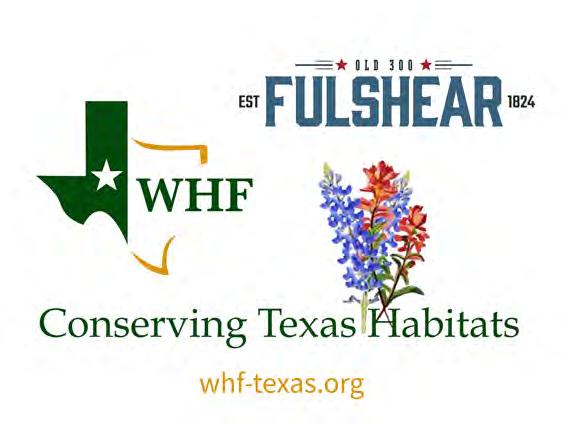
of assistance and guidance to other landowners in the local area. WHF began working in 2 counties on 200 acres of ranchland. In 2005, WW Ranch was recognized by the Texas Parks and Wildlife Department as the Lone Star Steward Award recipient for the Gulf Coast Prairies and Marshes Ecoregion.
In 2006, desiring to expand the native prairie footprint in the area, WHF applied for and was the first Texas recipient to be awarded a Conservation Innovation Grant from the U.S. Department of Agriculture’s National Resources Conservation Service. The grant provided funding to increase quail habitat along a 7-mile-long corridor starting at the Attwater Prairie Chicken National Wildlife Refuge in Eagle Lake and ending at WW Ranch in Cat Spring. Portions of the 150-foot-wide corridor were “set apart” with fencing that ran parallel to existing boundary fences and crossed 5 ranches. Using various restoration practices such as prescribed burning, herbicide applications and no-till planting, the land lying within the boundaries of the corridor was returned to a historical native grass and forb plant community. The corridor was completed in 2010.
In 2013, TPWD’s Oaks and Prairies Joint Venture began annual bird counts in a focal area that included the WHF Quail Corridor. They found 31 species of birds and a population increase of 80% more birds living in the corridor area than in the surrounding landscape. In 2014, 30 Attwater Prairie Chickens were seen in the corridor off of the refuge. The success of this program demonstrates that agriculture and wildlife habitat can co-exist. To quote Aldo Leopold in his book, A Sand County Almanac, “Can we really not have ‘both progress and plants?”
2016 saw the addition of a Program Director, Garry Stephens, who joined WHF after 30 years’ service with the USDA-Natural Resources Conservation Service.
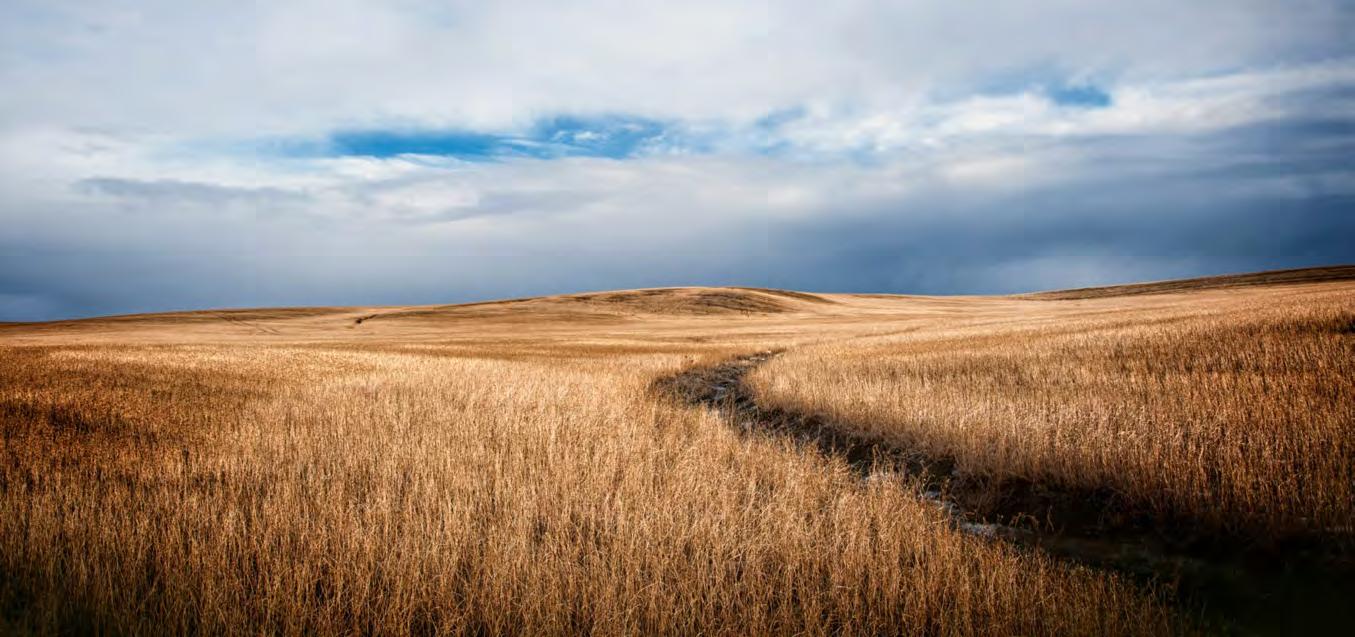


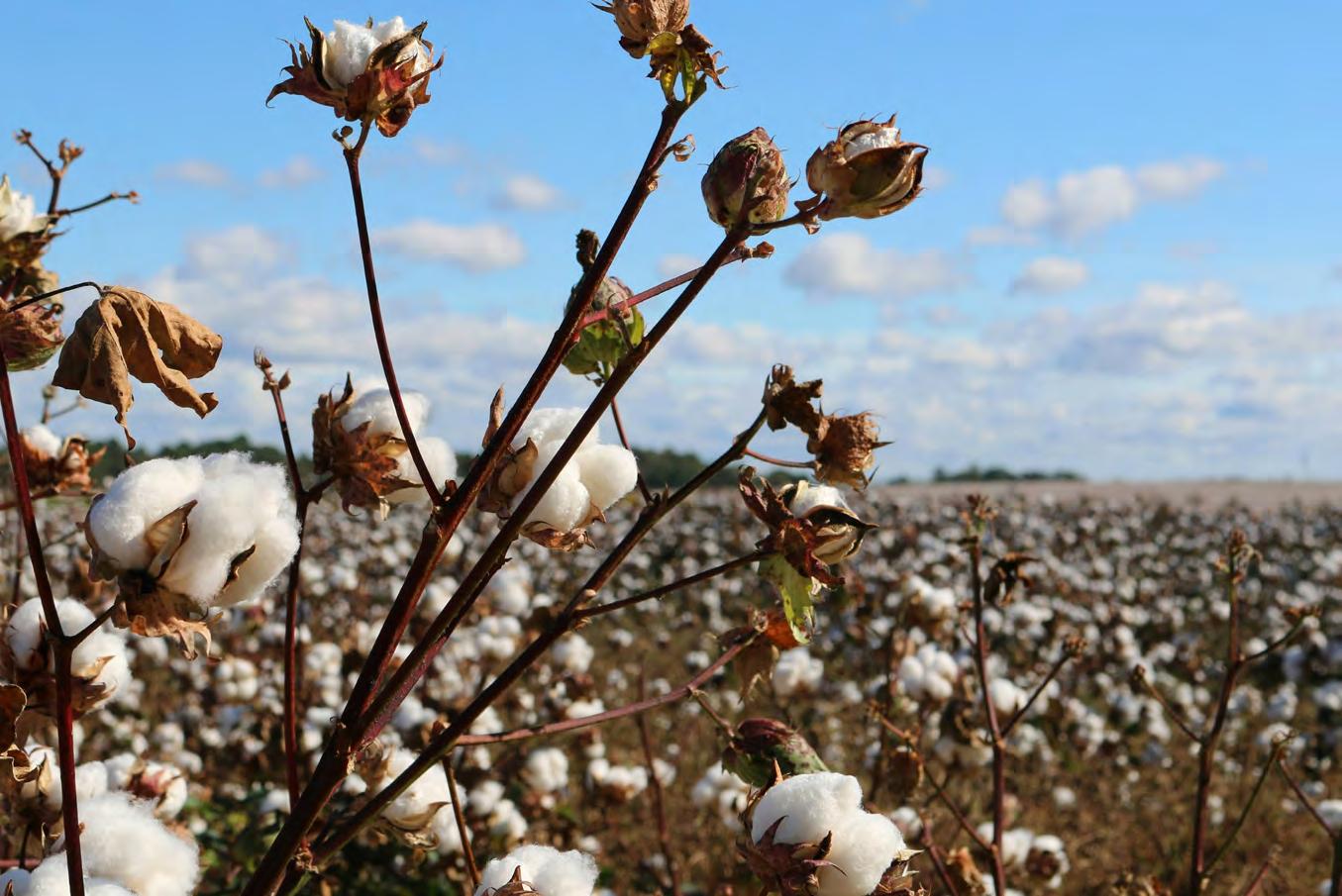
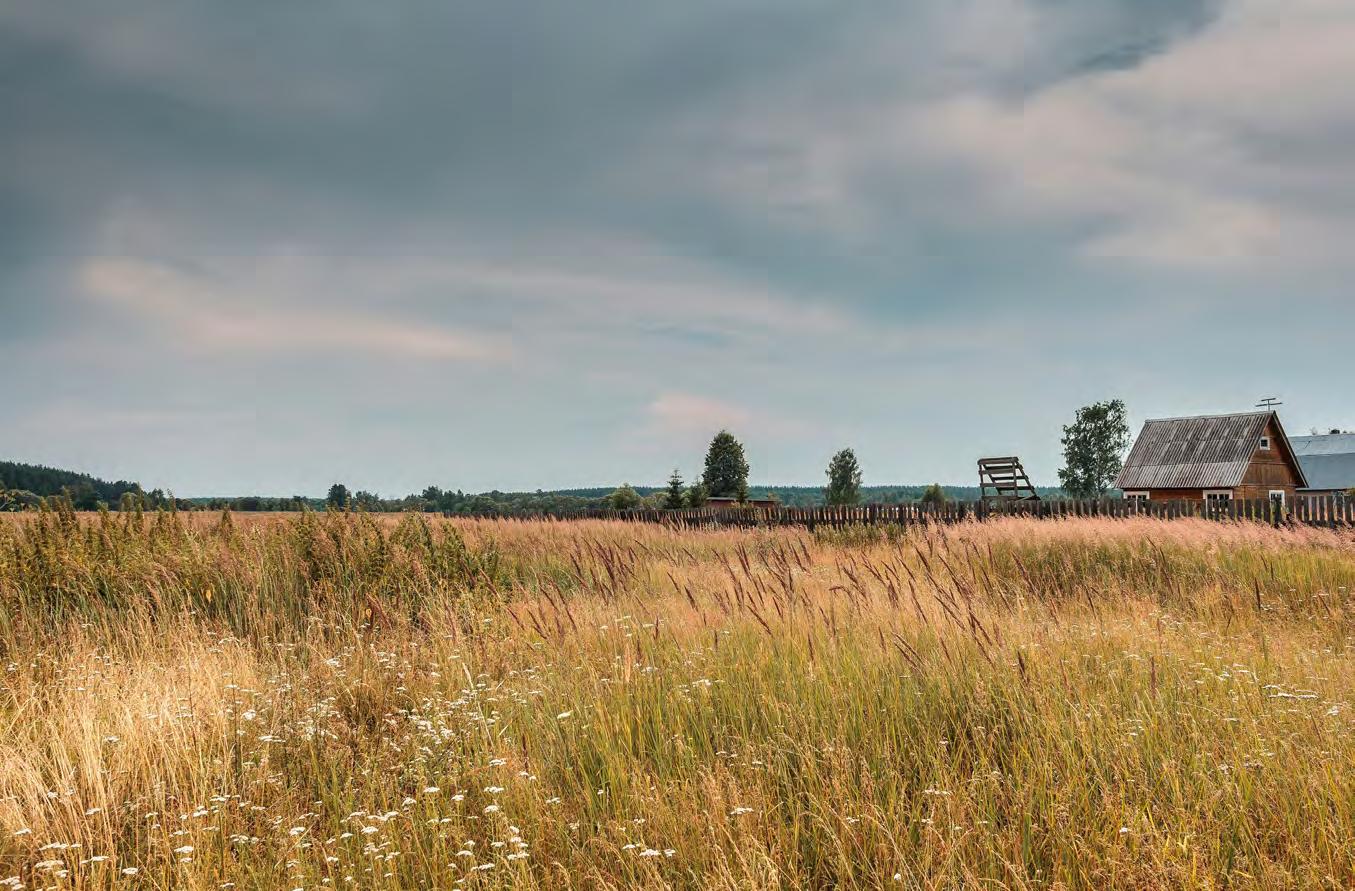
After years of diligently putting habitat on the ground, WHF has increased its area of impact to more than 50 Texas Counties and is seeing positive results with improved habitat management on over 115,000 acres of farm and ranchland.
Urban projects have included the Katy High School Tiger Prairie, the Memorial Park Landbridge Project, Hermann Park, M.D. Anderson campuses, the Fulshear FM 1093 Median wildflower project and the Texas Heritage Parkway. After nearly 20 years, now with a strong board of trustees and driven by the desire to restore Texas habitats, the organization has rebranded to become WHF Texas and has been successful in helping ranchers and farmers throughout the state to better understand how protecting native grasses can not only give them better grazing results on their land, but improve soil conditions, provide new habitat for native species and even assist in carbon sequestration.
WHF has a staff of seven experienced field personnel who have many years of hands-on experience in the development of habitat management plans. Touching over 115,000 acres of Texas farm and ranchland, these professionals have been making tremendous progress with individual landowners in creating highly friable soils...rich, crumbly texture that is ideal for root systems to grow deep and widespread. Friable soil also allows for better water absorption, decreasing run-off. Secondly, whether these landowners are seeking to improve aesthetics and welcome pollinators or improve livestock grazing, our professionals select seed mixes that ensure success for the purpose.
Through planting native grasses, WHF staff help landowners in slowing water run-off and by increasing water absorption in their land. By reducing run-off, there is a reduction in the amount of silt being dumped into the Gulf’s bays and estuaries, which in turn protects the plants and animals that live there. Native grasses sequester carbon. The more grasses that are in place, the more carbon is sequestered. It is a common misconception that trees can do this most effectively. While trees are certainly effective, native grasses are more efficient. A tree stores most of the carbon in its leaves and biomass while native grasses store their carbon underground. Any wildfire that might occur causing trees to go up in flames, the burned carbon they formerly stored is released back to the atmosphere. When fire burns grasslands, however, the carbon fixed underground tends to stay in the roots and soil, making them more adaptive to climate change. Grasses actually feed carbon to the microorganisms living in the soil, thus benefiting the plant growth. Rangelands can potentially sequester up to 300 million metric tons of carbon dioxide in their soil. That is enough to carbon offset for 6 million people per year.
WHF practices have been proven to restore native plant and animal species back to historical conditions. These methods allow nature to take control and bring back desirable species that landowners love to see and that further benefit the ecosystem on their property.
WHF uses a myriad of methods to restore this precious prairieland. Part of the process initially includes the removal of invasive species using mechanical means…a dozer, a tractor and sometimes even an axe. By removing unwanted trees, native grasses grow in their place. Removing unwanted trees also means reducing the amount of water demanded from the ground.
Plows are used in conservation efforts in order to create fire lanes and food plots. Fire lanes are lanes with no burnable material, keeping fire either in or out of a pasture. This protects the pasture and reduces losses in the event of a wildfire. During a prescribed burn, a fire lane helps contain the fire. These fire lanes can also be used as trails for hiking or roads for access to various parts of the land. Food plots are developed in order to welcome wildlife onto the property. Food plots are plowed, then planted with grasses and legumes preferred by common wildlife native to the area.
While WHF does not actually handle prescribed burns, experienced staff prepare plans and assist experts such as TPWD in the management of prescribed burns, As mentioned above fire lanes are used to prevent the spread of fires. A checkerboard method is used to burn approximately ¼ to 1/3 of the habitat per year which keeps some cover available for wildlife. The lanes in the checkerboard create more “edges.” Ground-nesting wildlife is able to stay undercover for shelter and can easily access the open area in the lanes to feed.
Livestock are extremely effective in improving soil quality. The cycle begins when the animals bite and lift plants from the ground, loosening the soil. Once the food has been digested and leaves their bodies, the nutrients from the digested food are trodden into the soil as the livestock move about the pasture. WHF found when running livestock on pastures, it’s also important to closely manage rotating herds in order to prevent overgrazing. WHF has designed hundreds of grazing plans for ranchers to enhance native prairieland.
WHF has strong ties with many conservation organizations in our area including The Nature Conservancy, Memorial Park Foundation, Coastal Prairie Conservancy and numerous others. Projects include rural ranchland as well as urban projects including pocket prairies where they are least expected like Houston’s Medical Center.
Whether a native plant for small community wildflower project, or a restoration of a larger expanse of 25,000acre ranchland, WHF is dedicated to conservation of native habitat through restoration, management, and generational sustainability of prairie habitat for the conservation of soil, water, air, and wildlife.
Special Thanks to Native American Seed Company.
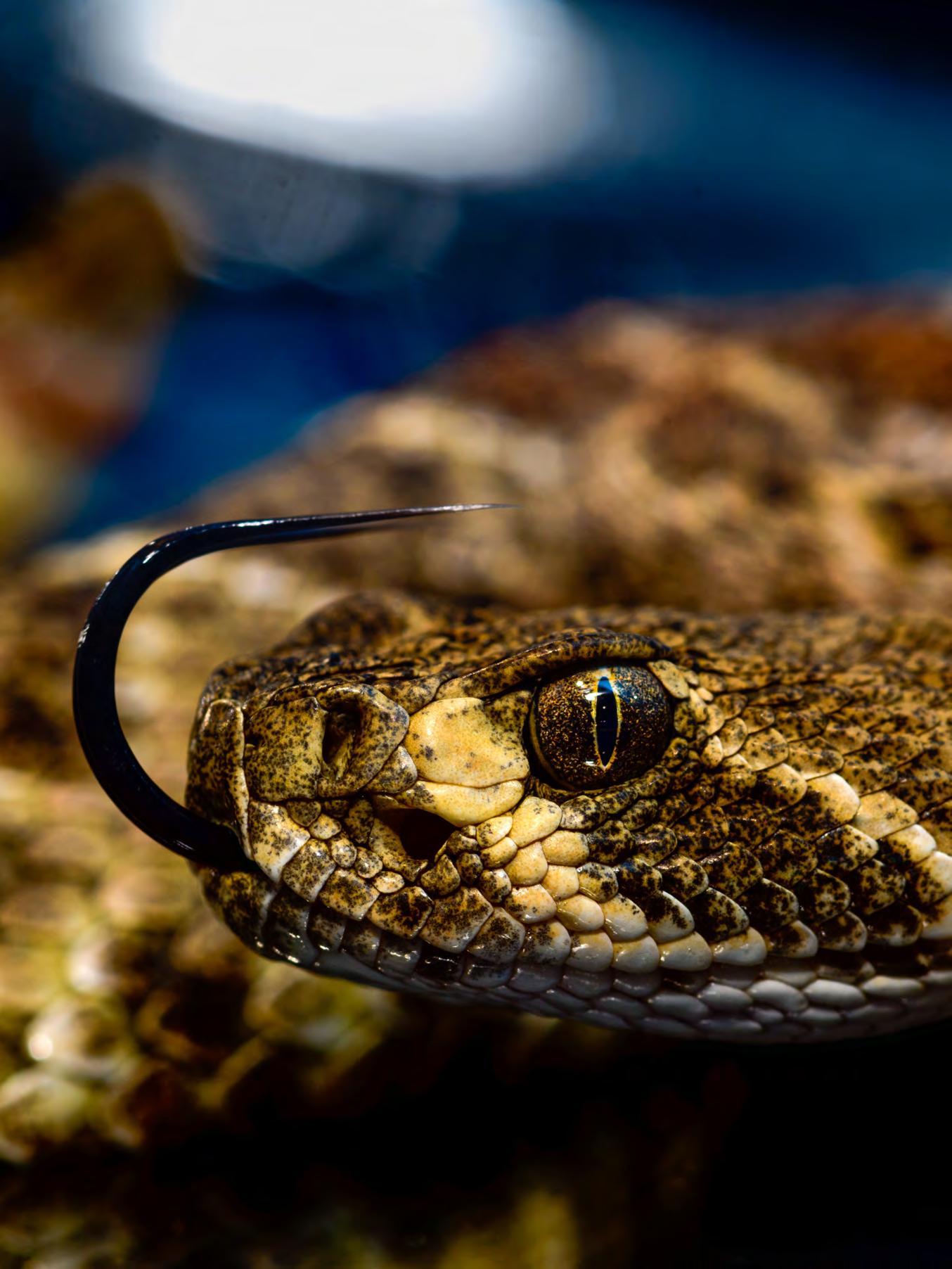
WRITTEN BY CJ McDANIEL

Just say the word and for a lot of people, shivers go up and down their spine. And… I’m one of them. I just have never been a fan of snakes since I was a kid and found one in my sleeping bag. Snakes have been objects of fascination, or fear and suspicion since ancient times. Sadly, for some people, their first reaction to a snake is to pick up the nearest shovel or hoe and quickly dispatch the intruder. Snakes, however, play a key role in the balance of nature.
As a Texas Master Naturalist, I have often been asked: What kind of snake is it? Is this snake poisonous? What good are snakes anyway? And, by the way, snakes are not poisonous, but some are venomous. While I personally am not a snake lover, I do recognize that many snakes that God put here perform certain functions to help the environment. Some are predators and feed on a variety of creatures. Small snakes feed on many harmful bugs and insects. Larger ones eat mice, rats and other small mammals that can destroy the ecosystem or damage personal property. Snakes tend to control rodent population in particular, so without them, we might be completely overrun by nuisance rodents.
Granted, some Texans may be reluctant to brag about this one, but the Lone Star State is, undeniably, a cornucopia of snake diversity. Although the exact number of species is hard to determine, we boast a stunning 76 species of snakes. If you include both species and subspecies in that number, it gives you a grand total of 115, or more - the highest number in all of the United States.
The vast majority of Texas’ snakes are nonvenomous and completely harmless. Only 15% of the total number are venomous and should be treated with caution and respect.
The venomous varieties can be grouped into four basic categories: coral snakes, copperheads, cottonmouths (also known as water moccasins), and rattlesnakes.

Here are some facts to understand and help you as you live in our natural settings within Cross Creek Ranch.

• Snakes are found throughout Texas. Of the 254 counties in Texas not one of them is snake free.
• Snakes are active from March through the beginning of November.
• You may see them now if you live in a newer area where you have not seen them before as construction of homes, pools, roads, etc. creates a tremendous amount of ground vibration. Snakes do not have inner or outer ears; they rely on taste and sight and are amazingly sensitive to vibrations. Therefore, they move away from their normal hiding places that are now shaky to the still surroundings of our yards and playgrounds. Severe droughts and rains also displace snakes into our yards.
• To be safe, look around! Never step or put your hand where you cannot see.
• Keep grass and vegetation cut short. Trim shrubs and bushes so you can see the ground under them. Remove debris piles immediately (branches, leaves boards, logs). Cut low limbs (Keep three feet above the ground). After cutting down a tree, remove the stump— do not leave it to rot and provide hiding and nesting places for the Texas Coral Snake. Should you have a wood burning fireplace, do not store fireplace logs on your back porch or backyard.


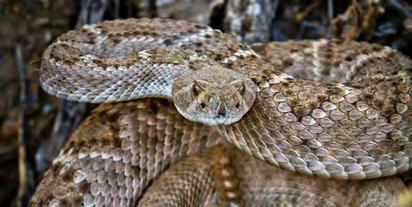
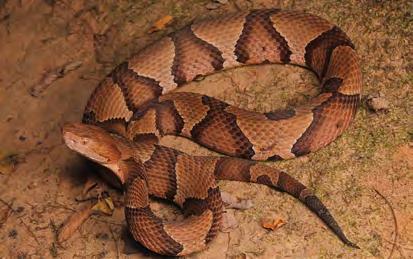
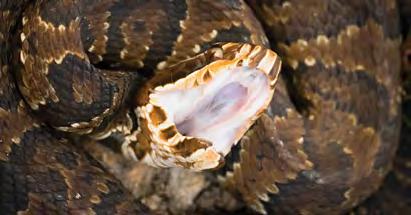

Now to address the key issue of this story. There are four venomous, or poisonous, snakes that call Texas home. You will want to be able to identify them. Let’s start with the easiest one. The Coral Snake . Red next to yellow, nasty fellow or is it red next to black, nice Jack. Easy to get mixed up. So, our advice is if you see any snake with bands of red, yellow and black, do not try anything with it. Just let it go away. It is a smaller snake, typically very slender. This is the most dangerous of all the venomous snakes in Texas as it secretes a neurotoxin when it bites…and it bites. It does not strike like the rattlesnake. It has numerous little small teeth that all are razor sharp and they puncture the skin and secrete their venom. There is no anti-toxin for the Coral Snake today. The snake’s neurotoxic venom causes rapid paralysis and respiratory failure in its prey; however, according to the National Institutes of Health, it can take many hours for symptoms to appear in humans. Additionally, there is often little or no pain or swelling in humans from a coral snake bite. So, get to the hospital as quickly as possible. Period.
The other three snakes are pit vipers. The Diamondback Rattlesnake is responsible for inflicting two-thirds of the venomous bites in the State of Texas. There are nine different varieties of rattlesnakes. The western diamondback is the most common and widespread followed by the Timber or Canebreak rattler. Copperheads are found in this part of Texas. Copperheads have chestnut or reddish-brown crossbands on a lighter colored body. These snakes are found in rocky areas and wooded bottomlands, although can be found along streambeds. There are three subspecies, but all have the similar shape and size. The last venomous snake is the Cottonmouth , or Water Moccasin . This snake does have a bright white mouth which is clearly evident when it opens its mouth wide for its prey to see. Cottonmouths can be dark brown, olive-brown, olive green or almost solid black. They are marked with wide, dark bands, which are more distinct in some individuals than in others. Juvenile snakes are more brilliantly marked. Although not 100% reliable, we have used the triangular head identification with 99.9% accuracy for many years. If the head of the snake is rounded, it typically is not venomous. However, if the head is triangular with the mouth of the snake sharper, rather than round, it might be venomous…and make extra effort to leave these guys alone.
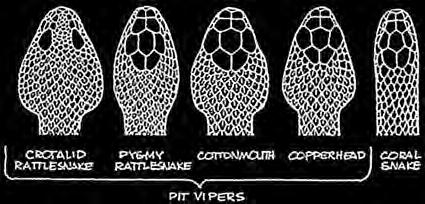
Copperheads, cottonmouths, and rattlesnakes are called “pit vipers” because they have a special “pit” organ between their eyes and nostrils that uses heat sensors to hunt prey. The best method to identify venomous snakes is by looking at their eyes…not lovingly, just to see the eyeball. And, you don’t have to get real close to do so. All venomous snakes in Texas have vertical slits in the eye (actually called vertically elliptical pupils). So a triangular head and up-down slits in the eyes….a definite no-no!
Snakes do not prey on humans and they will not chase you, in fact they usually retreat or escape if given the opportunity. The danger comes when they are either surprised or cornered.
Following are photographs of the four snakes that could endanger you, your family or your pets. However, we recommend getting a field guide, so you can be more educated and safe. There are several good ones available today. The University of Texas Press has a very good publication for less than $15, Texas Snakes: A Field Guide


Assume envenomation has occurred, especially if initial symptoms are present. Initial symptoms of pit viper bites include fang puncture marks; in addition, they almost always include immediate burning pain at the bite site, immediate and usually progressive local swelling within five minutes, as well as local discoloration of the skin. Initial symptoms of coral snake bites include tremors, slurred speech, blurred or double vision, drowsiness or euphoria and a marked increase in salivation within four hours; however, life-threatening effects from coral snake envenomation may not be evident for 24 hours or longer.
Try to identify the species of venomous snake that inflicted the bite, if possible, taking care to avoid another person being bitten. Identification is not necessary, but may be helpful.
Keep the victim as calm as possible. This helps reduce the spread of venom and the onset of shock.
Keep yourself and any other members of the group calm as well. This will help reassure the victim and ensure that the appropriate first-aid measures are followed, as well as preventing anyone else from becoming injured.
Wash the bite area with a disinfectant if available.
Remove jewelry such as rings and watches, as well as tight-fitting clothes, before any onset of swelling.
Reduce or prevent movement of a bitten extremity, using a splint if possible; this helps decrease the spread of venom. For the same reason, position the extremity below the level of the heart.
1 2 3 4 5 6 7
Old School….Do NOT make incisions over the bite marks. This can result in significant damage to already traumatized tissue, and can damage intact structures such as nerves and blood vessels, enhance bleeding caused by anticoagulant components of venom and increase the rapid spread of venom throughout the body if the circulatory system is compromised.
Do not use a tourniquet or other constricting ban except in extreme cases of envenomation, and then only if properly trained in the technique.
Do not use cryotherapy (including cold compresses, ice, dry ice, chemical ice packs, spray refrigerants, and freezing) for the same reasons that the tourniquets should be avoided, and also because it can increase the area necrosis.
Do not use electroshock therapy, a method popularized following publication of a letter from a missionary in South America reporting its effectiveness in treating bites from snakes of uncertain identity.
Do not drink alcohol, as it dilates blood vessels and increases absorption from the circulatory system, and thus helps spread venom faster.
Do not use aspirin or related medications to relieve pain, because they increase bleeding. A pain reliever not containing aspirin, however, may be used.
Do not use the pressure/immobilization technique, which consists of firmly wrapping the entire limb with an elastic bandage and then splinting, especially for pit viper bites.
One final thought…rumor is that rat poison will keep snakes away. Please, do not use rat poison to try to prevent snakes in your yard. It could endanger your own pets and certainly can do harm to other wildlife that might be a positive impact in the environment. 1 2 3 4 5 6 7 8
Get the victim to a medical facility as soon as possible. Recently the supplies of anti-venom for pit viper bites has expired and is not being replaced. So, quick response time to the nearest medical facility is critical.
WRITTEN BY MAYOR AARON GROFF
Let me start by expressing my gratitude – it has been an incredible six years. Serving as Mayor has been one of my life’s most significant privileges and blessings. A massive shoutout is due to my family; none of us fully comprehended what lay ahead when I decided to run for office six years ago. While I anticipated enjoying the experience, I have genuinely loved serving as the Mayor of Fulshear. Don’t get me wrong; it hasn’t been without its challenges, but there have been numerous successes over the last six years.
Most everyone knows Fulshear has held the title of fastestgrowing city for quite some time.
In 2008, there were just over 750 residents. In 2012, when I moved here, there were 1,250. When I was elected in 2018, there were 14,000; today, we have over 36,000 residents. The population growth represents a substantial volume of residential development in a short timeframe. Despite our rapid growth, we proudly rank as one of the safest cities, not only within Fort Bend County, not just in the state of Texas, but in the entire United States. It’s not just residential development; as you know, 1463 has witnessed the emergence of numerous new businesses. In recent years, there has been a growing interest in new commercial development along 1093, Heritage Pkwy, 359, and even downtown. Managing fast growth poses challenges, but the Council and I have put in extensive effort to ensure quality residential development. A significant achievement in promoting responsible development was the implementation of the CDO or Coordinated Development Ordinance. The CDO consolidates all our zoning and ordinances into a unified document, providing developers with a clear understanding of our expectations for responsible development.
In the initial months of taking office, we also adopted a water and wastewater master plan that laid the groundwork for multiple Capital Improvement Projects currently underway or recently finished. This encompasses the expansion of both the downtown wastewater package plant and the Cross Creek
Ranch wastewater treatment plant, expanding groundwater storage capacity by 1 million gallons at downtown water plant 1, and upsizing two trunk lines from the downtown plant to 16 inches. Additionally, the construction of a new water plant in Pecan Ridge capable of producing 4 million gallons per day (MGD) with a 1 million gallon (MG) elevated storage tank, 1.5 MG ground storage tank, and a 5.75 MGD pump station will expand the capacity of the Downtown Water System. Alongside crucial water projects, we greenlit the expansion of both wastewater treatment plants and the improvement of multiple lift stations. Lastly, we are completing Air Stripper Installation at multiple water plants to remove hydrogen sulfide, the culprit behind water odor water, and adding a polyphosphate feed system across all water plants to eliminate off-colored water.
In 2023, the city received its first-ever Bond rating to issue debt for the completion of several aforementioned water and wastewater projects. Fulshear was awarded an AA+, a rarity for a city that had never previously issued any debt. The favorable rating stemmed from robust fiscal management and optimistic projections associated with both residential and commercial development throughout the city. Additionally, the bonds can be issued for future utility use and the collection of Impact Fees, which were adopted in 2018. These Impact Fees play a crucial role by compelling new development to bear the majority of the cost for new water and wastewater infrastructure.
Mobility projects, including the expansion of 1093 and the build-out of The Heritage Parkway, have eased traffic congestion and resulted in new commercial projects within our city and ETJ (Extended Territorial Jurisdiction). Additionally, the Downtown Livable Center Study has resulted in new city branding and streetscapes for the downtown corridor. The design phase for the Harris Street expansion is currently underway to create a walkable promenade between Wallis and Main Street, envisioning a vibrant downtown experience featuring boutique shops and restaurants. Right-of-way acquisition is in progress for the Wallis Street expansion and the eventual development of dual pairs for HWY 359. Alongside the downtown street projects, drainage
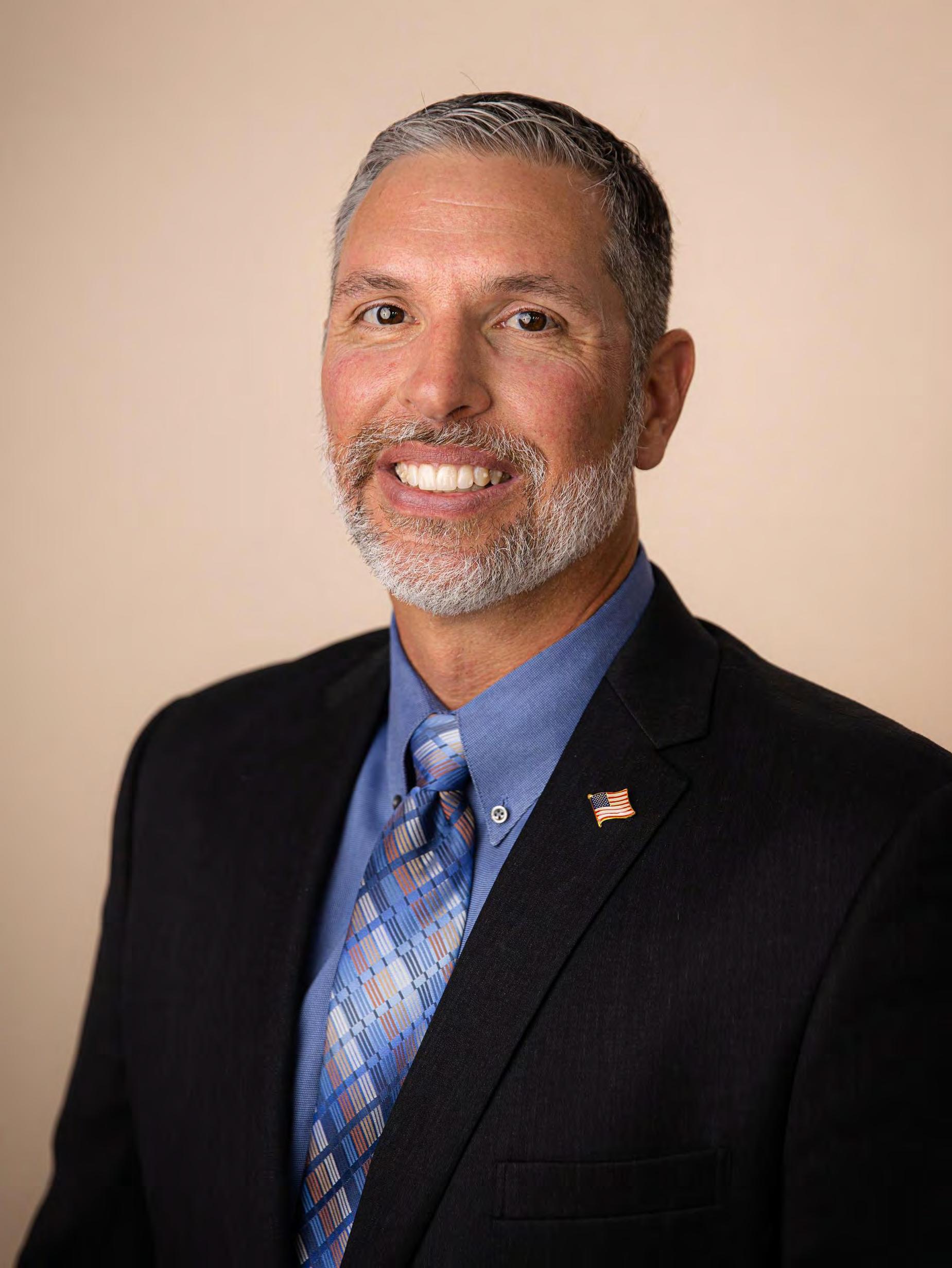

projects for the east side are being incorporated into road construction, offering a comprehensive regional solution for our downtown residents and businesses. Finally, in 2018, I was informed about the city’s need to secure the right-of-way for the Huggins expansion, as approved in a 2013 County road bond project. This initiative extends Huggins from Charger Way to downtown, creating a crucial east/west corridor. I take pride in saying that negotiations for the final tract have been successfully concluded, and construction is set to commence very soon.
When I initially made the decision to enter the mayoral race, my foremost priority was to renegotiate a problematic agreement with our in-city MUDs. Without rework, this agreement would have constrained the city for decades to come. The original agreement established a full rebate of the tax rate for anything over 10 cents back to the MUDs for their valuation. In other words, the city could never have a tax rate greater than 10 cents without giving the majority back to the MUDs. Thus, in 2018, we promptly resumed negotiations immediately following the conclusion of the election. These negotiations had persisted for over three years, and the city and MUDs remained significantly divergent in their positions. By the close of 2018, I had engaged with all the attorneys and the MUD Directors, successfully securing a significantly improved deal through amicable negotiations. The MUD Directors recognized the existing deal was unfavorable, but finding terms agreeable to all was crucial. A breakthrough occurred when I met with representatives of each MUD without the involvement of attorneys and agreed to a tiered
structure for the rebate. Presently, that rebate exclusively applies to the valuation of the MUDs and is only 0.0625% up to a 21.999 cent tax rate. At 22 cents, it goes to 0.07 and increases by 0.01 every 2 cents thereafter. This stands as a significant win for the city as the rebate becomes progressively less burdensome each year, allowing us to maintain the lowest tax rate among all cities in the region. Our success extended beyond the tax rate, as we additionally accessed a “lock box” holding 3.5 million dollars, which had contributed to a higher-than-needed water rate at the time. Consequently, in 2019, we were able to slash the water and wastewater rate and absorb the majority of our solid waste fees within the city budget. Recognizing the temporary nature of the rate reduction, we recently adopted water rates more akin to the 2018 rate to support essential infrastructure projects. The funds from the “lock box” are utilized for repairs and enhancements to the water and wastewater system in Cross Creek Ranch, savings that are ultimately passed onto the residents of Fulshear.
During my time as Mayor, we negotiated multiple Developer Agreements with both residential and commercial developments. The outcomes of these agreements translated into significant victories for the city. Examples include the establishment of single-family rentals in areas where multifamily would have been permissible by right, the implementation of wider sidewalks to accommodate bicycles along major collectors, the creation of interconnected trails leading to neighboring communities, the allocation of land for water plants and wastewater sites, facilitating commercial
development on challenging tracts, and even a developer undertaking the construction of a soccer complex, among other achievements.
In the middle of my second term, the city council embarked on a monumental task to secure a city facility that would meet the needs of Fulshear residents for the next 15 years. The initial need for a centralized city facility stemmed from a combination of structural inadequacies in existing facilities, the rapid growth of the Fulshear community, and the evolving demands for more comprehensive and accessible public services. In November 2020, the council authorized staff to pursue five different tracts of land in the Downtown District for a future city hall. Unfortunately, shortly after that authorization, the existing city hall had to be condemned because of structural concerns. The safety concerns and potential risks to employees and the public intensified the need for new facilities. While pursuing a new city hall, we faced several obstacles to constructing it downtown due to the city not owning any land in that area. Nevertheless, while searching for temporary space, an incredible opportunity arose that ultimately resolved our facility challenges and saved our residents millions of dollars. The Marcell Town Center on 1093 had recently been completed, leaving multiple buildings unoccupied due to the COVID-19 pandemic. The city successfully acquired these buildings and finished the construction of a new municipal complex, which now accommodates the city hall and the police department, without the need for issuing bonds or raising the tax rate. In addition to substantial financial savings, purchasing two buildings as empty shells allowed us to cut at least three years from the construction timeline. By November 2022 the buildout had been completed and the new complex accommodated all our staff. The centrally located municipal complex enables residents to conduct all city business in one place, ensuring convenience for staff and residents for years to come with streamlined operations, improved service delivery, and a closer community connection.
I’m genuinely grateful for the council members I have had the honor of serving alongside over the past six years, and we can take pride in our collective accomplishments. I’m thankful they’ve given me influence and trusted me to negotiate various deals. While we haven’t always seen eye to eye on all topics, as I told them when initially elected, “Disagreement and varying opinions only make the city better if we conduct ourselves with decorum and respect, and after the decision is made, we have each other’s back.” These six years have been successful because we chose collaboration and continued to move forward, keeping in mind that the decisions made today will significantly impact the years to come.
Fulshear stands as the premier address in Fort Bend County. It is a great place to live, work, and play, and I am immensely thankful to our residents for entrusting me with leadership during this crucial period. We celebrate 200 years as a city this year, and the last six have seen the most change. I invite you to explore our city and, better yet, consider making it your home and bringing your business here. I assure you, it’s a decision you will not regret!
We chose collaboration and continued to move forward, keeping in mind that the decisions made today will significantly impact the years to come.

WRITTEN BY DOUG PIKE
The rod tip bounced and the line came tight, angling to the left along the reed-rimmed shoreline. Rickey and I watched Liz Coulter lower the rod, reeling to keep pace, and, then, finally, stricking hard to the open side of the johnboat.
A two-pound largemouth bass promptly jumped, showing an open mouth, flared gills and the flapping plastic worm pinned in the corner of the jaw. The hooked bass fell back, pulled hard, then jumped again. Rickey Morris nudged the stern-mounted electric trolling motor, maneuvering to deeper water. “Good job,” he said. “You did that exactly right.”
“It’s about time,” Liz laughed. “I didn’t do so well on the first two strikes. Or ‘taps,’ or whatever you call them.”
We were fishing a small lake near Morris’ home south of Houston. The bass plodded close and I reached with thumb and curled index for the classic “lip grab.” I held the chunky green and gold fish aloft.

We
“Congratulations; your first bass!”
snapped several photos then released the fish. It flashed away, diving into the clear green.
Coulter is an avid saltwater angler, but that recent foray was her first for largemouth bass. She was wielding a 6 1/2-foot two-handed rod and a freespool casting reel, and handled the casting tackle with growing confidence as Morris eased the 12-foot aluminum boat along the shoreline.
The lure of choice was a crawfish-type soft plastic rigged snagless “Texas style” on a 4/0 worm hook below a 1/4-ounce bullet-type slip sinker. The same setup, with various modifications, has been used
a jillion times in the lakes and ponds of southeast Texas, and it remains a killer for summer bass.
It also is an excellent choice for the newcomer. First, with the hook point turned back into the soft plastic lure body, the offering is virtually snagless amid “hard” cover such as logs, stickups. and reeds.
The weighted “worm” is relatively easy to cast; the compact lead bullet sinker provides a positive payload for tentative lobs. Conversely, other effective bass lures demand a higher skill level for smooth deliveries. Air resistant payloads such as tandembladed spinnerbaits and balsa thin-minnow floating/diving plugs are among the worst.
For example, during the same session, I attempted to wham a thin-minnow plug into the gusting southeast wind and, well, the backlash easily was among the top 10 in my 50-year fishing career. Maybe the top five. The spool was absolutely buried amid exploded monofilament. One look and I started snipping with line clippers. It was brutal, especially with semi-pro credentials riding on the effort.
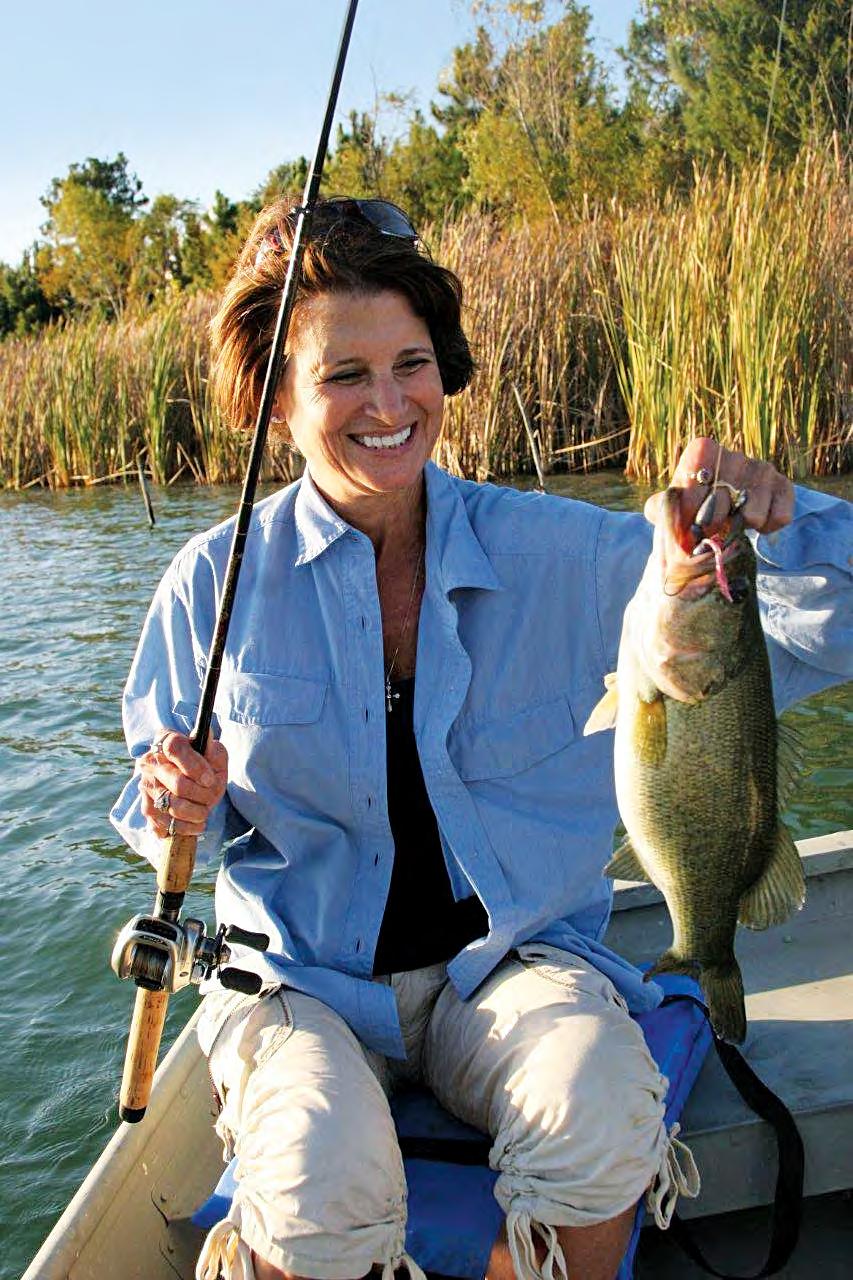
Also an advantage, the pace is slow with a bottom-bumping weighted plastic. You don’t wear yourself out with chunk-and-wind. And, on the sluggish days of summer, allowing the bait to dawdle in a “fishy” spot gives lurking bass plenty of opportunity to seize the moment.
Finally, bass absolutely love soft-plastic baits. The strikes usually are confident and fish tend to hang onto (even attempt to swallow) the lure. The hit typically transmits as a “tap” or “bump” then the line comes tight as the fish moves off with the chewy plastic in its mouth. This deliberate tempo gives the angler time to react.
The single drawback at the beginner level for fishing bottom-bumping Texas-rigged plastics is the violent hook-set required to set the barb. Remember, the hook point is pressed back into the soft body of the lure to keep it from snagging as it bounces and flutters over the bottom contours. Also, the line in deeper water encounters more water resistance as the angler raises the rod on the strike.
Liz missed the first two fish simply by not hitting back hard enough. The bass were there but she failed to reach them with a soft reaction. No question, bass are more difficult to hook on Texas-rigged worms than on fast-moving plugs with exposed trebles. On the latter, the solid contact is automatic.
But the tuned angler willing to pay attention can make the adjustments. During our twohour late-afternoon session, Coulter caught six bass to three pounds. Her skill level increased markedly as she understood the drill.
I caught four bass. Of course, I was in the center seat and forfeiting most of the “ice cream” water. Well, that sounds good. Rickey caught two but he was driving the boat and, way back in the stern, fishing seriously used water. Needless to say, in a desperate game of catch-up, I was giving him few uncontested shoreline shots.
Come to think of it, even with solid contact on the hook-set, I jumped off a “solid 5.” So did, well, never mind about her.
But, regardless of experience and on large water or small, the angler using a snagless soft plastic has taken a major step forward in catching summer bass

WRITTEN BY DOUG PIKE
Some friends and I, many years ago, recognized three important things about Texas’ “little problem” back then with wild hogs: They did lots of damage, that small issue was only going to get larger, and at 35-75 pounds or so, wild pigs are really, really tasty.
So we set out, along with a handful of others whose pastures were being ravaged and deer populations bullied by feral swine, to eradicate wild hogs in Texas.
We kept at it for years, too, accepting every invitation from every rancher and hunting buddy we knew. We shot pigs all over the state, mostly by day and sometimes at night. Our numbers didn’t match the tens of thousands of hogs whacked by state-hired sharpshooters, but we did our best.
And we didn’t make a dent. It seemed on many ranches, in fact, that shooting one pig only resulted
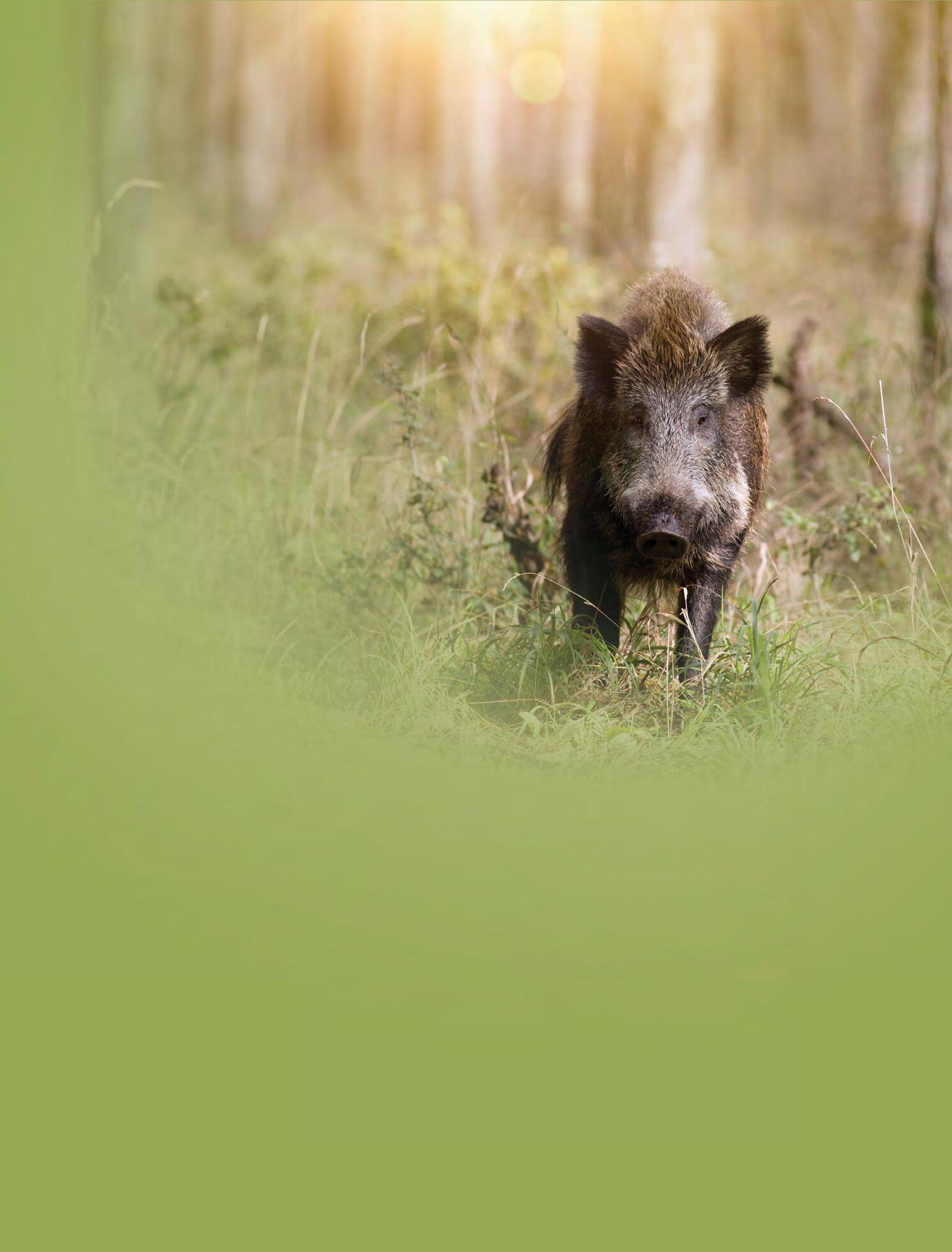
in the appearance of three or four. There’s more than marksmanship required to knock back a population of animals in which every female can produce 10 or more offspring per year.
For reference, just in this state, a Texas A&M University study pegged the number of wild hogs killed statewide, in 2010, at more than three quarters of a million animals. Despite that heaping pile of bacon, however, I have yet to hear of any region statewide where you just can’t hardly find a pig anymore.
Since the first hog escaped off a sailing ship moored along the Gulf Coast after crossing from Europe, it’s quite likely that some reasonably smart men thought the beasts could be eradicated. Those guys a century and change decades ago, and along with them went their dreams of killing Texas’ last wild pig.
Since then, 10 times as many smart people figured we at least could control wild hog populations. Most of them have passed, too, and anyone who still thinks as much is wrong.
Not to be undone by a bunch of pigs, we Texans – and the good people from the 35 or so states where the animals have established populations – decided to turn them into money.
Trappers take hogs away from places where they’re unwelcome – which is almost everywhere – and deliver them, still snorting and gnashing their teeth – to ranches on which sometimes significant fees are charge to hunt them.
Texas hogs are being exported also to high-end meat markets across western Europe. Apparently, somewhere between here and there, the meat from feral hogs becomes a delicacy. My guess, though, is that if you just crossed halfway to Europe with a pig carcass and brought it back here, it would still taste about the same and still be worth as little.
The state of Texas places few restrictions on how, when or where we can yank another wild hog from the population. You can shoot them day or night, and there is no restriction on how many you can stack in a session.
If you want to hunt them by day, by traditional methods, go ahead. Only know that within two or three sessions, after a couple of pigs are removed from the same herd, the rest of that herd will seem to vanish. The only way you’ll know they’re still on the property is by the damage they’ll continue to do when you’re not looking.
Night hunting is an exciting way to go after hogs, and not the least dangerous way if you do it on the ground. A good friend, Scott Null, isn’t scared of much. He uses
a night-vision scope and walks quietly around his place down near the Gulf Coast. Usually, he hears the pigs long before he sees them or they see him.
Occasionally, however, one surprises the other. The “fun” part, as Null describes it, is in not knowing which team will do the surprising and which will be surprised. So far, the guy with the rifle has always won, but the pigs on his place don’t show much interest in quitting the game or leaving the field.
My closest call with a pig came on a bowhunt nearly 20 years ago. I tired if standing in a makeshift tree stand and, bow in hand, hopped the six or so feet to the ground. As my knees flexed to absorb the landing, my body buckled, and the nocks of arrows in my quiver tapped muddy ground.
I leaned against the tree and, with a little stick, began to flick the dirt from those nocks.
One arrow short of completing the task, I heard a grunt. Close. When I looked up from the chore, my eyes met those of an exceptionally large boar. It was 10, maybe 12 feet directly in front of me and seemed nearly as startled as I by the encounter.
Neither of us was exactly in full defensive or offensive position. There came an awkward pause between us, a few really weird seconds through which neither of us took or gave ground.
I stood slowly, silently. The pig stood its ground. I stared at the hog, and the hog stared at me.
And finally, we exchanged a telepathic agreement to walk this one off. I turned north, and the pig turned south. It probably went on to sire a thousand more of its kind. I have one son. The war between Texans and Texas hogs, it seems, may never be fair.
Photos: ©iStock.com/jevtic, ©iStock.com/predrag1
53
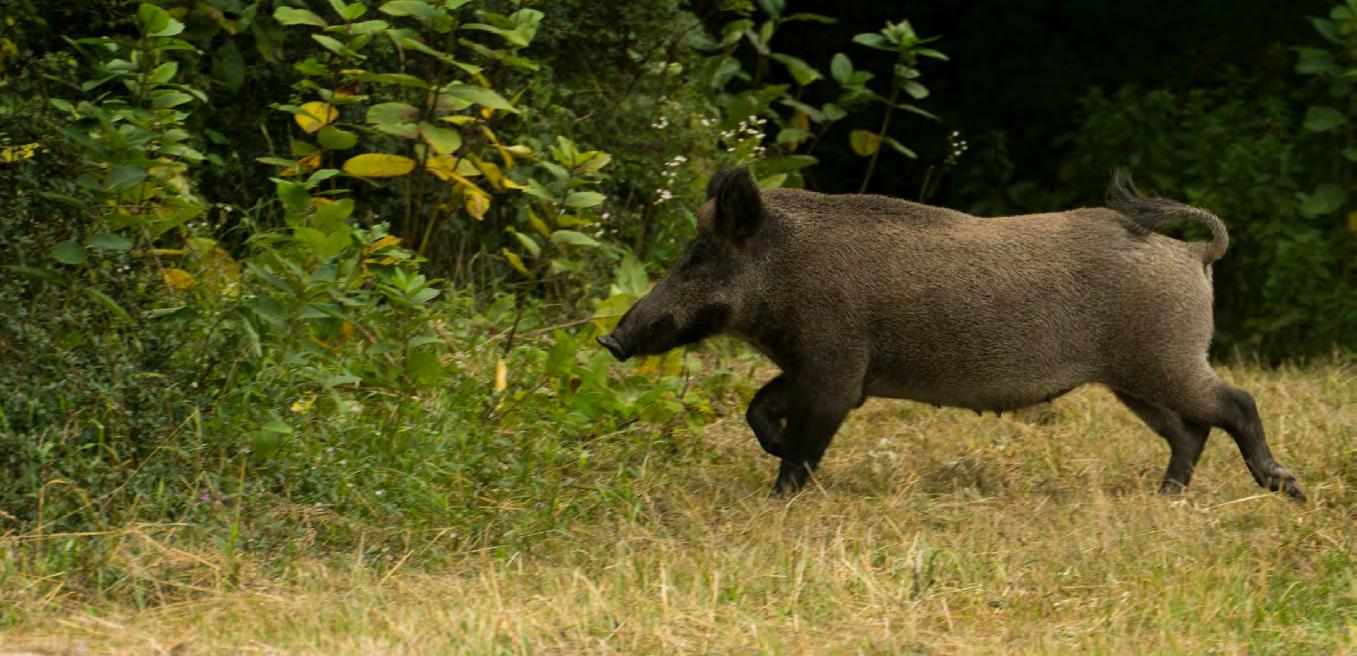
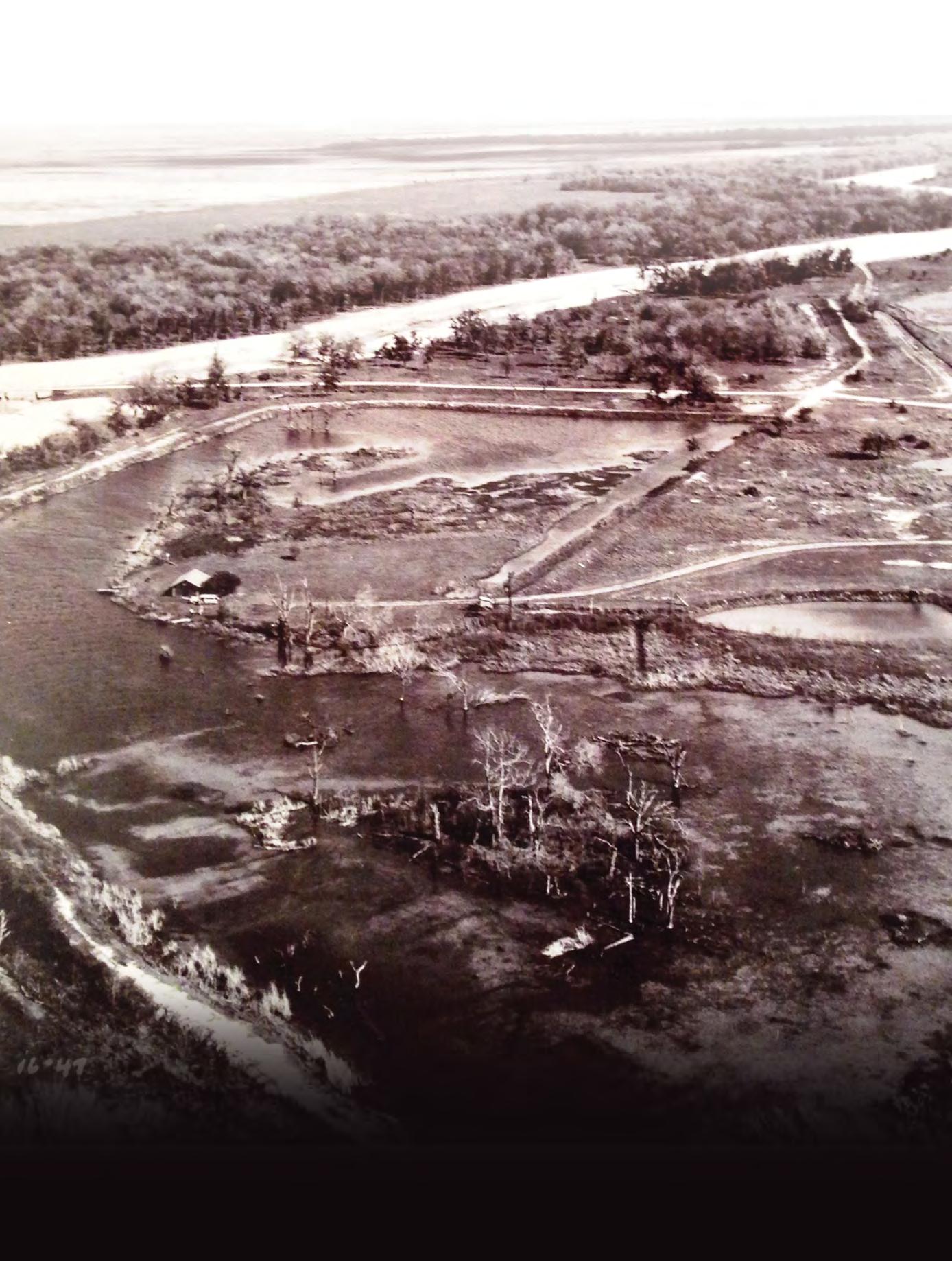
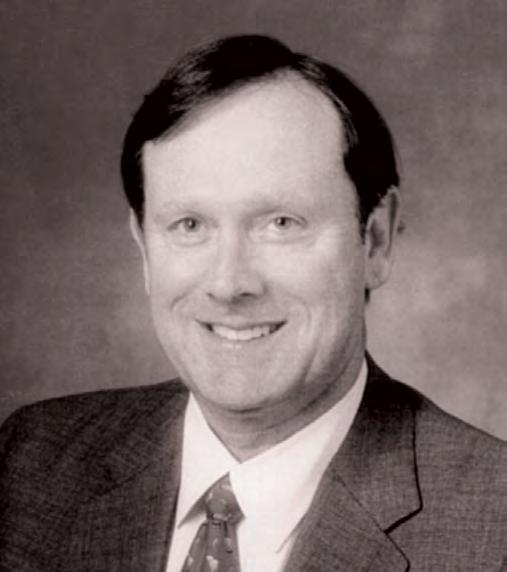
grew up at Cinco Ranch. His family and the Abercrombie family bought it in the ‘40s. It was originally purchased by the Blakely family, who had it parceled to them by Stephen F. Austin, himself, in a land deal done before Texas joined the Union. Cinco Ranch, now managed
by Newland Communities, is the number one top-selling community in Texas, and the number three top-selling community in the entire United States.
Ted Nelson from Newland Communities gave a talk in April 2014 addressing the dramatic growth Southeast Texas is undergoing because of Eagle Ford and other energy developments and how that growth is affecting the real estate market. Mr. Nelson said that “between the medical and energy sectors, Houston now has the greatest accumulation of intellectual capital the world has ever seen.”
“Cinco Ranch, Telfair, The Woodlands and a number of ‘new’ communities skirting the edges of Houston and along the Grand Parkway are becoming selfcontained cities unto themselves and a major source for the housing and retail needs of the booming influx of workers,” he stated.
Cinco Ranch is a mature community, having been developed in its current capacity for close to thirty years.
it all begin?
It started with the father of the father of Texas, Moses Austin. The Spanish government gave the blessing for Moses Austin to settle hundreds of families into the area. His son Stephen F. Austin, the father of Texas, finished this settlement while Texas was still under Mexican government. One of those settlers was Randolph Foster who was deeded 4,000 acres in Fort Bend and Waller counties, which at the time were occupied predominantly by Indians and buffalo.
Foster’s daughter married Thomas Blakely, cattleman and future sheriff of Fort Bend County. His son, Bassett Blakely, followed in his father’s and grandfather’s footsteps and became a cowboy and cattleman. Bassett Blakely owned 15,000 acres of land, 14,000 head of Brahman cattle, and his grandfather’s land. The cowhands of his Blakeley Ranch annually drove 10,000 head of cattle to the railheads in Kansas.
Our interview with Mr. Bill Wheless elicited more history of Cinco Ranch post World War II up to its sale to Newland Homes.
Have you ever studied the history of Cinco Ranch, in books or online?
Mr. Wheless: Yes.
There is information on you, your family, and the Blakelys owning the property in 1937.
Mr. Wheless: Yes, I’ve seen some of that. My grandfather, William M. Wheless Senior, was head of the Land Department for the Gulf Oil Company. He did a lot of transactions representing Gulf with Mr. James Abercrombie who was an extremely successful independent oil man.
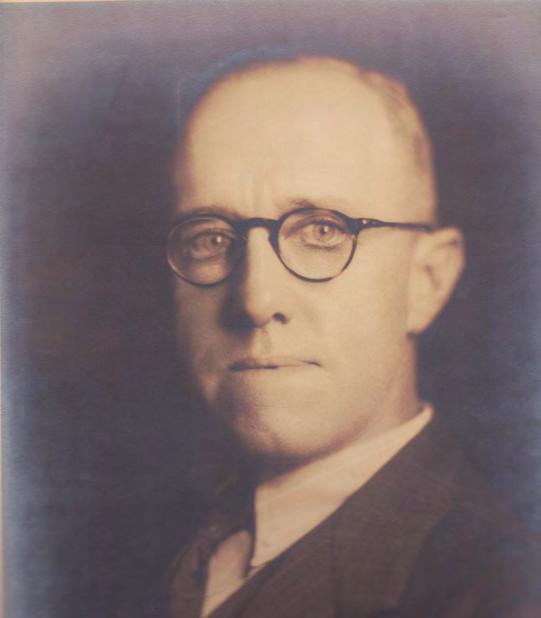
Mr. Abercrombie asked my grandfather to quit his job, which at the time was a very good job, to be his partner. Mr. Abercrombie proposed putting up the financing, and he wanted my grandfather to acquire property for their venture.
My grandfather took that step and became partners with Mr. Abercrombie. That was in the 1940s, right around World War II.
Mr. Abercrombie was on a trip, a grand tour of Europe. My grandfather was here. The head of Texas Commerce, now JP Morgan Chase Bank, came to my grandfather and said, “We foreclosed on a large ranch and we want you to buy it. We want to get it off our books.”
My grandfather
was reluctant to do
that because it was such a huge deal, 10,000 acres. “I don’t want to do that because it’s too big a deal,” he said “I have to consult with my partner before taking on such a huge obligation.”
At that time Jesse Jones was the head of the bank. He was also the head of the Reconstruction Finance Committee in Washington for FDR. Mr. Jones told my grandfather, “No, I talked to Jim before he left. He said you can buy anything you want. Here are the papers, and I want you to sign them right now!”
With much trepidation, my grandfather signed the papers without communicating with Mr. Abercrombie, there being no faxes or emails at that time. He then owned 10,000 acres between Westheimer and Katy and Highway 6, formerly the Blakely Ranch.
The more he thought about it, the more uncomfortable he was with what he had done, so he found partners to bring in on the deal before Mr. Abercrombie returned
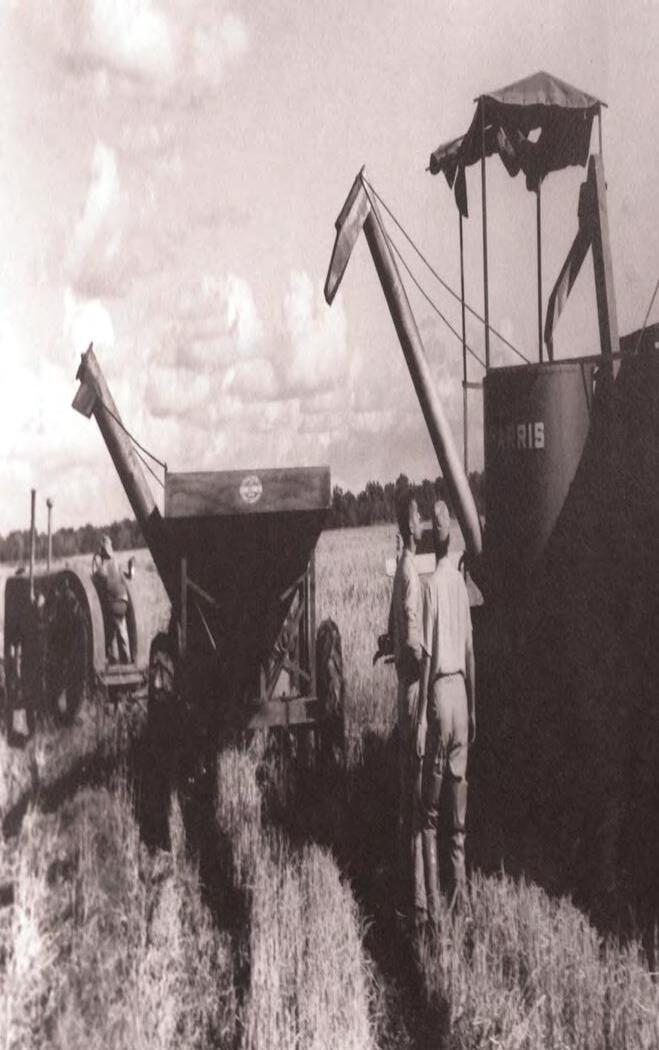
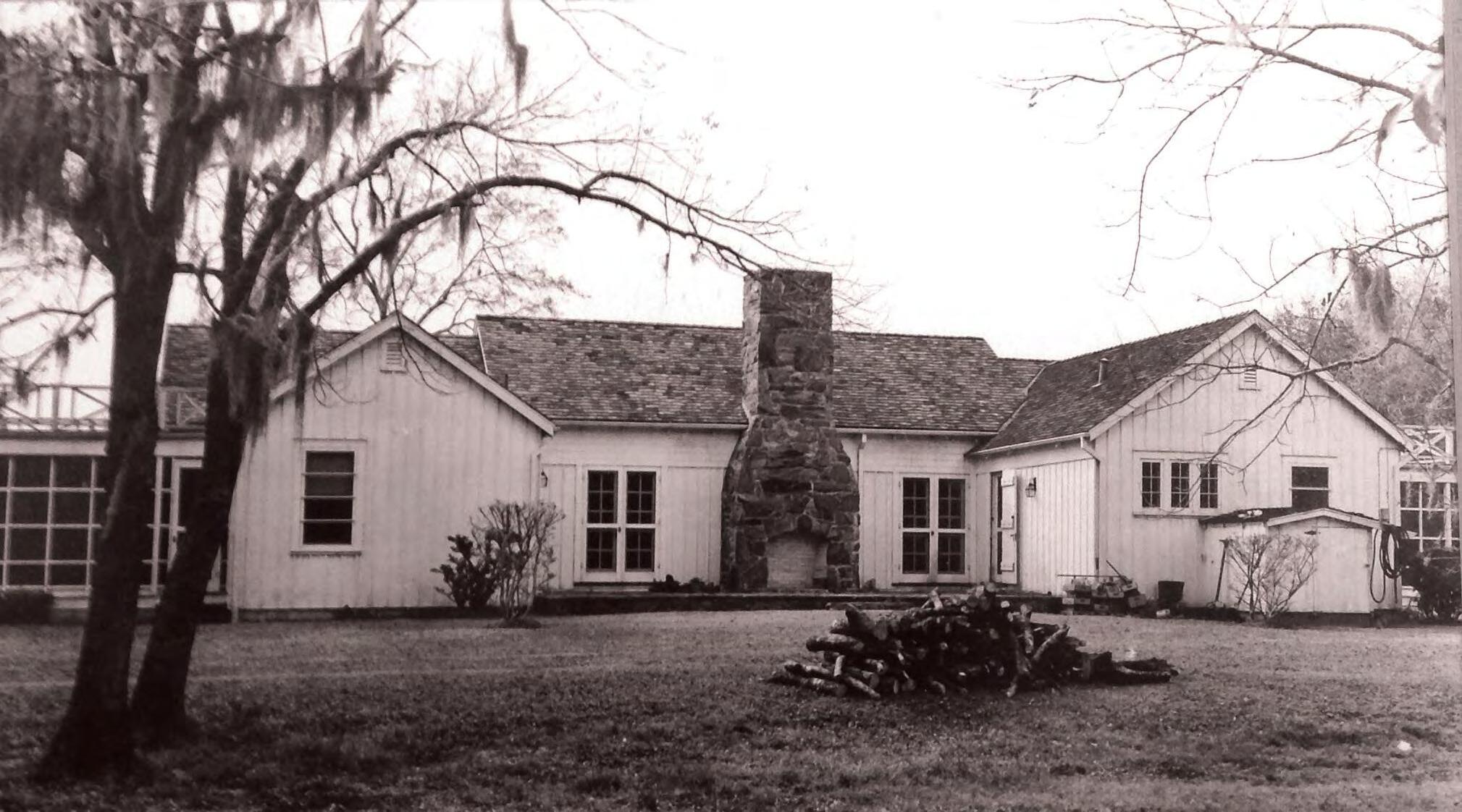
from his vacation in Europe. One was his good friend, the president of Gulf Oil Company, Mr. W. B. Pyron. The others were Mr. H. G. Nelms, a successful oil man and Mr. Lenoir Josey, another good friend of my grandfather. Now there were five partners, hence the name Cinco Ranch.
When Mr. Abercrombie got back from his trip, my grandfather met him at the dock in Galveston and said, “I don’t want you to be mad, but I want to tell you what happened . . . Jesse Jones made me buy this ranch . . . But, don’t worry . . . We got three more partners and now there are five of us.” Mr. Abercrombie looked at the deal for a second and said, “I am furious. This is the best deal I’ve ever seen in my life. They purchased it for ten dollars an acre. You go buy those other partners out immediately and give them double their money.”
Mr. Abercrombie and my grandfather owned the ranch 50/50 for over forty years. My father operated it, and they grew rice and raised cattle.
When I finished graduate school, my grandfather was in failing health. He decided to sell half the ranch to Robert Mosbacher. I have fond memories of working with him on that sale.
So now Mosbacher and Abercrombie were partners?
Mr. Wheless: Yes. Mr. Abercrombie’s daughter Josephine owned one half and Robert Mosbacher and a group of his friends owned the other half. That was in the ‘70s.
Then in 1984 Abercrombie and Mosbacher decided to sell.
The first part of the ranch that sold was to Vincent Kickerillo. That was eight or nine hundred acres, now called Kelliwood.
That was closer to I-10.
Mr. Wheless: Yes, closer to I-10 off Fry Road.
In 1984 the purchasing group consisted of US Homes, the largest home builder in America, American General, one of the largest insurance companies in the nation, and the Mischer Corporation, one of the largest land developers in Houston. Each one played a role. One was the developer, one was the financier, and one was going to build the houses.
That sale was $84M. When you add in the Kickerillo transaction, it was a raw land sale in excess of $100,000,000.

In total?
Mr. Wheless: Total. Which was and still is, to the best of my knowledge, the largest raw land sale in the history of Houston.
Once they had it, Mischer, US Homes, and American General, developed it through several business cycles, and American General wound up with it. Their subsidiary was called Newland, who had an affiliation with a company called Newland Homes, and Newland’s is to this day the developer of Cinco. They added several more tracts to the west toward Fulshear as they ran out of land in Cinco.
It was two years ago, I think, that Cinco was rated the top-selling Master-Planned Community in the United States. I believe it even surpassed the Woodlands.
That is quite remarkable. What do you think made it so successful?
Mr. Wheless: Staying power, the ability to go through two really bad cycles because there were some bleak times. It wasn’t all straight up. They had such a huge land cost, and in addition they had a huge infrastructure cost. They had to channel Buffalo Bayou through Cinco. The headwaters of Buffalo Bayou start just on the northwest corner of Cinco near Katy. As you know, the Bayou goes through the middle of Houston and all the way to the Ship Channel.
When did they start developing?
Mr. Wheless: Kickerillo started in the early ‘80s. Cinco started in the late ‘80s. If you remember, Houston’s economy was horrible in the late ‘80s.
What was the price of an acre back when you sold it?
Mr. Wheless: Divide 5,200 acres into 84 million. It was an all-cash transaction.
Mr. Wheless: Now we have Bridgeland and the Woodlands. Both are really big deals. Camp Strake will be a very big deal.
Yes, it will be a big deal.
Mr. Wheless: When you develop large tracts, it takes a long time to absorb all the land.
What was the best time and the worst time?
Mr. Wheless: The best time for me personally was growing up as a kid out there and having access to all that property, hunting and fishing. My brothers and sisters and I have great memories. It was a Tom Sawyer type of existence. We hated to part with it, but my grandfather was in ill health, and he wanted to get his estate in order before he passed away.
Anyway, it was hard emotionally to part with the ranch. I was privileged to be in a position to help him sell our property as well as to be involved with the subsequent sale in 1984.
I remember reading, years ago, that your grandfather was considered to be one of the largest land owners in Texas.
Mr. Wheless: He and Mr. Abercrombie were the second largest land owners in Harris County when he died. They also owned the Atascocita Country Club, as well as most of the land on the western shores of Lake Houston. He certainly was a role model for me.
REDNews would like to thank Mr. Wheless for his travel back in time through one of the nation’s great burgeoning communities. The history of land and the big power brokers of Texas are fundamentally the history of Texans, from Stephen F. Austin to William M Wheless - big people, big deals. As George W. Bush said, “Some folks look at me and see a certain swagger, which in Texas is called ‘walking.’”
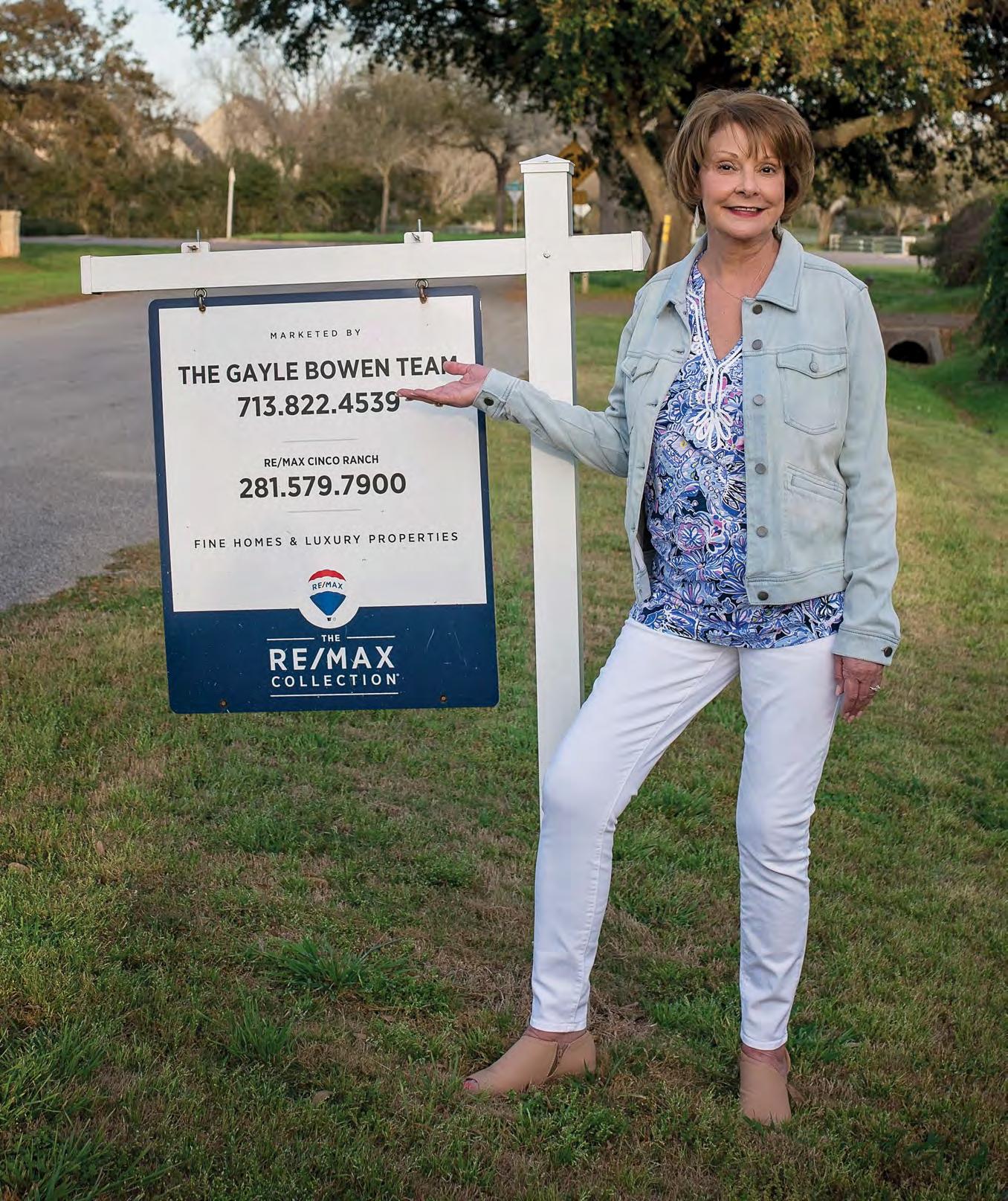

by

WRITTEN BY APRIL CANIK
RE/MAX Realtor® Gayle Bowen remembers when the population in Fulshear, TX crossed the 600 mark. Now that 6.2k folks call Fulshear ‘home,’ she feels a sense of pride knowing that The Gayle Bowen Team has played a role in that impressive growth and success.
“With new schools and grocery stores, expanded highways, oversized lots and excellent upscale culinary additions,” says Gayle, “Fulshear pretty much sells itself.” Families also flock to Fulshear for the small town charm that few other communities can match.
Those amenities add up to a dream come true for buyers, sellers -- and realtors alike. A third generation Houstonian, Gayle joined RE/MAX in 1988 and consistently enjoys recognition in the RE/MAX Hall of Fame as a Top Producer. Recently, the team landed on the 2023 Texas Top 500 list. “The Gayle Bowen Team has been finding and selling homes for so many decades that our longtime clients are sending the next generation our way,” she adds.
Speaking of next generation, Gayle’s daughter Stephanie Bowen Sykes is now one of the powerhouse team members propelling them to the top. “Since her dad and I were both in real estate,” shares Gayle, “Stephanie seemed to be destined to do this for a living. She went to our open houses, listings and meetings in her baby carrier, and spent countless hours in my real estate office over the years. She jokes with people by saying that she grew up either at a closing table or inside an attic with her father!” Stephanie initially opted for a teaching degree from Texas State, and followed that path for the first eight years of her adult career. After becoming a mother, she was reintroduced into real estate after becoming co-owner of a construction company with her husband, and the rest is history. In fact, this adds value via an additional layer of service to The Gayle Bowen Team.
When Stephanie isn’t busy helping her clients all around town, she spends much of her time scoping out and purchasing properties to renovate and build with their company, White Oak Homes. She shares, “I love being a part of the whole building process!
From picking out the lot, perfecting the plans, making design decisions, all the way to the finished product— it truly is my dream job!”
The Gayle Bowen Team can work with anyone, anywhere, but have specialized in four of the most popular regions: Katy, Fulshear, Memorial, and the Heights. “This doesn’t mean that we don’t spend our days driving to Conroe, Sugar Land, Friendswood, Magnolia, and other great suburbs around Houston— because we truly do it all!” states Stephanie.
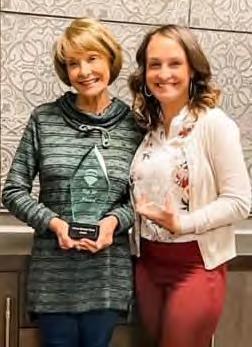
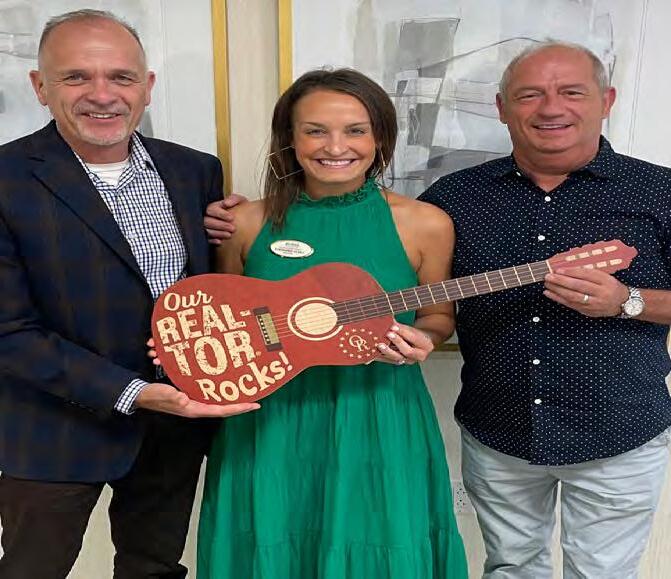
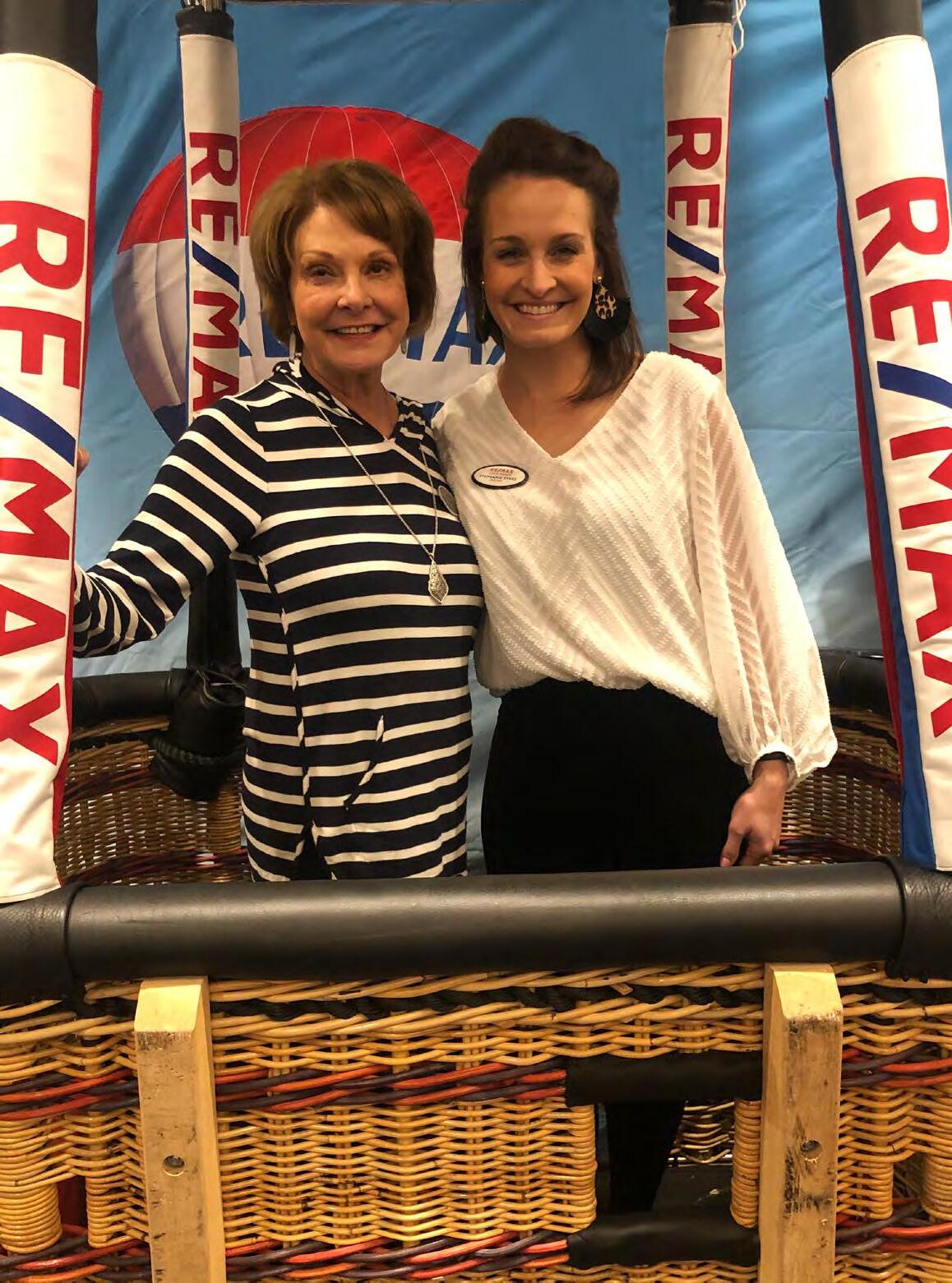
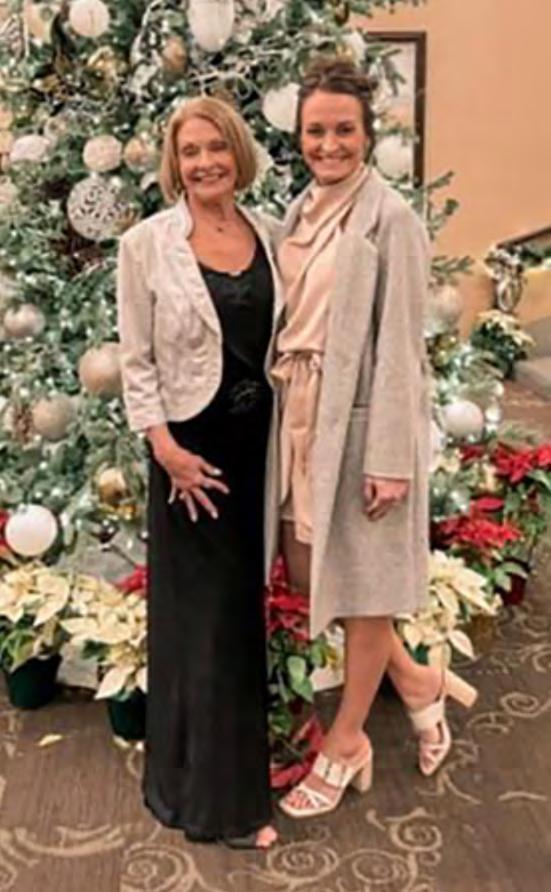
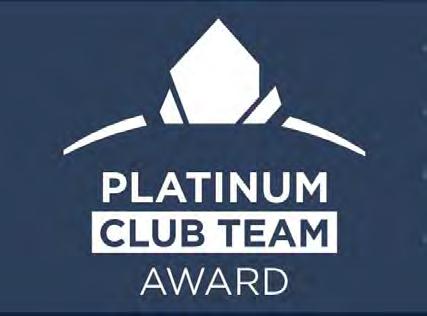

• Go the extra mile
Special requests are an important part of the job, whether that be finding a home with a room and bathing area for the family dog. Maybe you’re looking for extra acreage for equestrian use— whatever you’re searching for, the team can make it happen.
• Have a great team
In addition to three successful realtors, the team includes Kristin Cady, who has managed the office and generated excellent marketing initiatives for decades.
• Give back
The Gayle Bowen Team has long supported the Coastal Conservation Association, The Graeme McDaniel Foundation, Children’s Miracle Network and serves as a cheerleader for the Fulshear Farmer’s Market, among other amenities in each flagship communities.
• Stay involved
“Our team has a strong presence in local schools, Chambers, parades and other activities as time allows. We also stay in touch with all of our clients over the years, and often help them sell properties we helped them buy decades before,” adds Gayle.
• Be honest
“We value relationships much more than profits,” says Gayle, “I will advise people to wait if I think there is too much volatility in the market, for example. We consider each interaction much more than a financial transaction.”
Lifelong relationships are the cornerstone for The Gayle Bowen Team success. Phyllis Chaney echoes that sentiment, sharing, “I was introduced to Gayle Bowen over two decades ago while purchasing our ranch. She was the buyer’s representative, but made the transaction so pleasant for both parties. Now after all these years, because of her knowledge, professionalism and kindness, we have reached out to her to represent us in the sale of our ranch when we decide to downsize.” Adds Phyllis, “Gayle is a wonderful human being, professional and has the experience to handle any real estate transaction, large or small. I could not imagine having any other Broker represent us in any real estate transaction.”
Being a stickler for details and consistent follow through has been a winning strategy for Gayle and her RE/MAX Superstars. “It is hard to believe I was there from the beginning when the community of Remington Trails first opened and was built out, and then being a part of Fulbrook, which is now fully developed! All three of us are still very involved in these areas, and are excited to take on current and new adventures.”
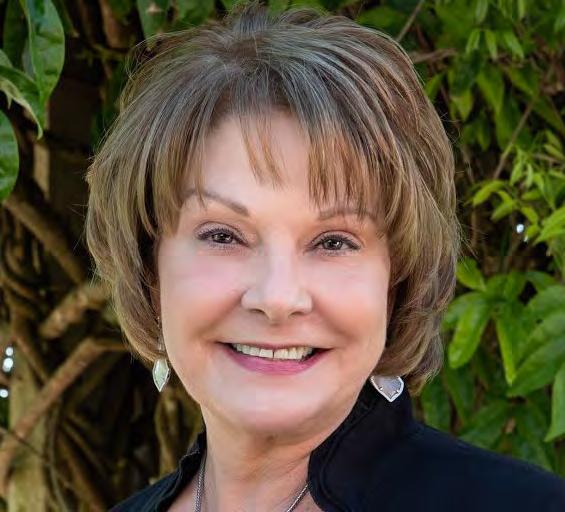
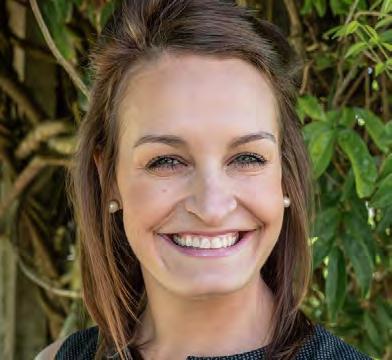
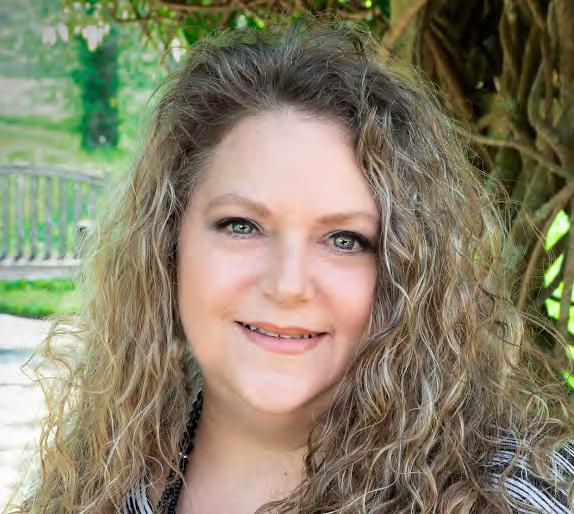


lapels Katy pRoviding the WoRlds only 100% enviRonMentally non-toXic dRy cleaning pRocess



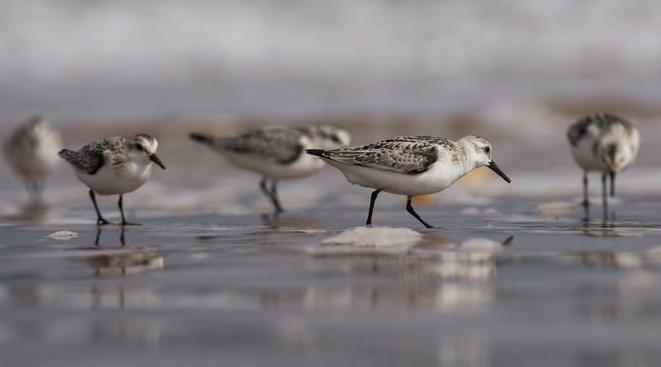
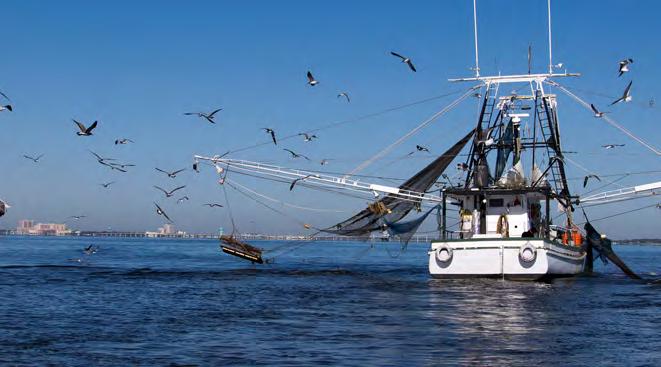
Nestled on the shores of Matagorda Bay, Palacios, Texas, affectionately known as the “City by the Sea,” stands as the shrimping capital of Texas and a premier destination for those seeking an unplugged retreat. Beyond its tranquil beauty, rich heritage, and vibrant community, Palacios is embracing a future filled with promise and excitement, making it not just a hidden gem on the Texas coast but a cherished sanctuary for both residents and visitors alike.
Palacios has long been a haven for nature lovers and outdoor enthusiasts. Its waterfront location is ideal for fishing, sailing, and kayaking, complemented by the picturesque Palacios Pavilion for those captivated by breathtaking sunrises and sunsets. The town’s status on the Great Texas Coastal Birding Trail, celebrated by the annual Matagorda Bird Fest, underscores its commitment to preserving natural beauty and wildlife.
The story of Palacios is told through landmarks like the City by the Sea Museum and the Luther Hotel, a beacon of architectural preservation undergoing a transformation into a modern destination hotel while retaining its historic essence. These sites, alongside Palacios’s pivotal role in the seafood industry and its significance in Native American history, paint a vivid picture of a community deeply rooted in its past.
The spirit of Palacios shines brightest during community events like the Seaside Holiday, where Santa’s seaside arrival captures the imagination, and the annual seafood festival, which, alongside events such as Pedal Palacios and Birdfest, heralds the town’s burgeoning future. These traditions not only strengthen community bonds but also signal Palacios’s readiness to welcome the world.
Looking ahead, Palacios is set to further enhance its appeal with exciting developments. The establishment of the first oyster hatchery in Texas heralds a new era for the local seafood industry, promising economic growth and sustainability. Plans for seaside improvements, including a splash pad, kayak launches, and expanded recreational activities, aim to enrich the quality of life for families and adventure-seekers alike.
Efforts to revitalize the iconic downtown area are underway, with initiatives to transform it into a bustling center of excitement, culture, and commerce. These enhancements are designed not only to attract visitors but also to invigorate the local economy and foster a sense of pride among residents.
Through these concerted efforts, Palacios is emerging as more than just a coastal gem; it’s becoming a vibrant sanctuary where the community’s dreams and aspirations are coming to fruition. It’s a place where the past is cherished, the present is celebrated, and the future is bright with possibilities. Palacios invites all to discover its beauty, engage in its traditions, and contribute to its promising future. Here, amidst the gentle waves and open skies, lies a town that is not just to be visited but to be called home, to be called sanctuary, to be called loved.
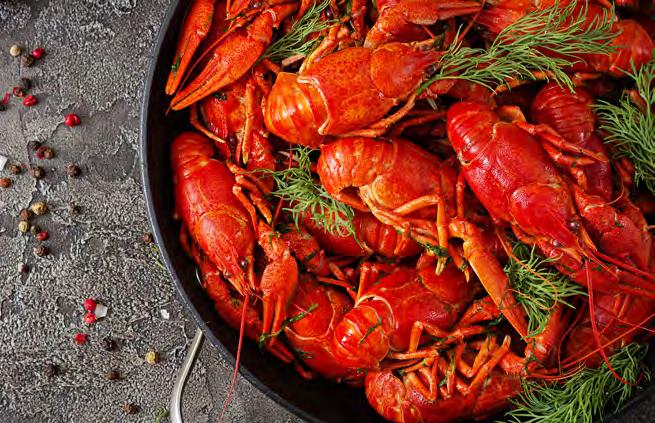
Palacios invites all to discoverits beauty, engage in its traditions, and contribute to its promising future.
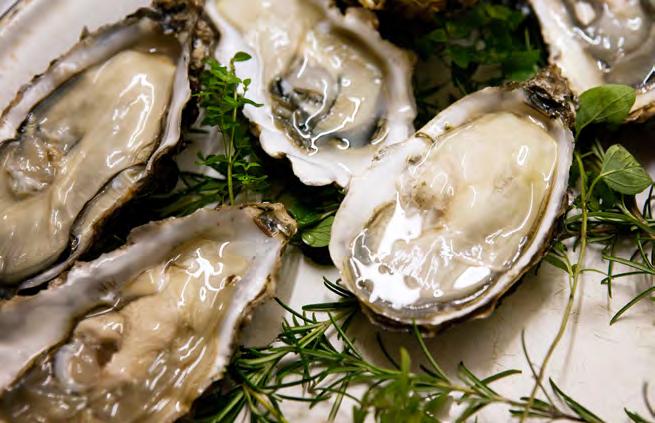
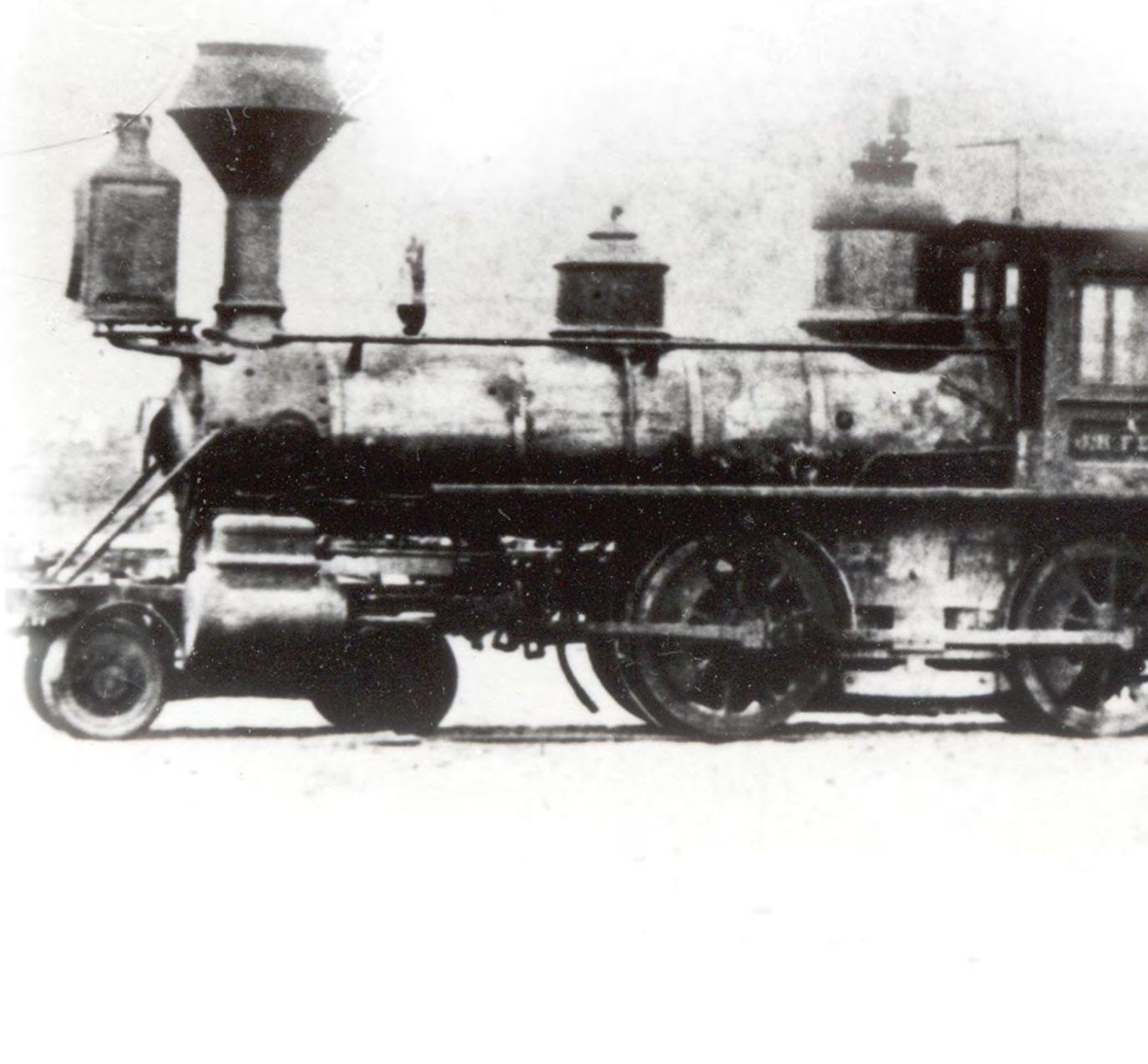
WRITTEN BY DANIEL McJUNKIN
This is a story about the centurylong rise and fall of the village of Pittsville, Texas. It is an illustration of how vision and planning impacts cities and how a lack of vision literally led one town to ruin.
The Texas State Historical Association has recorded a brief history of Fulshear, Texas as well as that of the village of Pittsville, Texas. The two towns were born of local landowners. Through opportunities, choice, and change, only one of the two towns would have a future.
A historical marker along the west side of FM 359 between Fulshear and Brookshire alerts passers-by to the approximate location of the all-but-forgotten village of Pittsville. According to the location of the sign, the community was located approximately 3.2 miles north of the current City of Fulshear along what is now FM 359. Except for the historic marker, little remains of Pittsville, short of fading family memories, archived historical photographs, and opportunities sadly missed.
According to the historical marker dedicated and placed on the site in 2012, the village of Pittsville, Texas was founded in the 1840s. Pittsville was named after
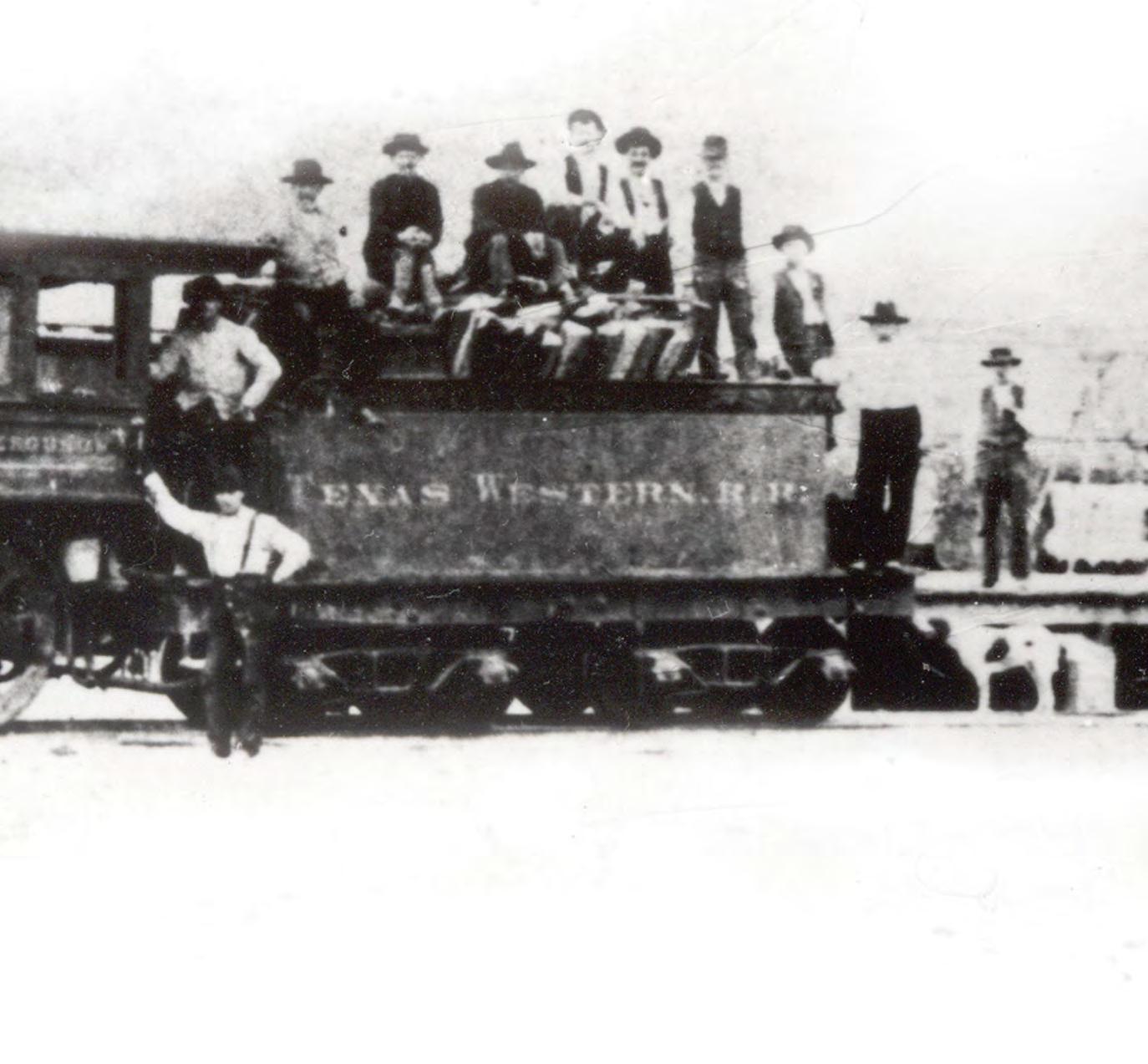
the major store owners in the area, A. R. and Amanda (Wade) Pitts. The Pitts’ were among the area’s early settlers. Their store must have been a veritable anchor to the community as the village enjoyed relatively consistent growth over the next twenty years.
In 1860, the village of Pittsville claimed 240 residents and by 1870, Pittsville appears to have been an up-andcoming town, complete with a post office, a school, a photo studio, and other essential services such as a blacksmith and millinery as well as other businesses. These were certainly the types of businesses and accoutrements one would expect of such a young, but growing community.
As time progressed, Pittsville achieved a true milestone in the life of the small, but growing village. This came in the form of what today’s governmental leaders would call increased mobility.
Originally promoted in 1870, The “Western Narrow Gauge Railway Company” was planned to run from St. Emanuel and Commerce streets in Houston to San Antonio and points far to the west. Its founders offered investors a grandiose vision, which, due to insufficient funding and ongoing financial troubles, would never be fulfilled.
Some in the Pittsville community expressed their excitement regarding the proposal to build a railway line so close to Pittsville. Clinton Drake, in his essay titled “The Pittsville Neighborhood, Fort Bend County, Texas” reports of a letter from Lee Nesbitt in January of 1871 in which the writer states:
“A lively interest is felt here in the success of the Narrow Gauge Railroad; as our whole trade lies in the direction of Houston. The connection would be of great material benefit. It would bring this productive section almost to the suburbs of your flourishing city. Two hours time would take us the thirty miles distance and the effect of it would be to rapidly settle up this neighborhood, make it the chief source of supply for your market of every variety of country produce.”
The relatively close proximity of a railroad that could take their agricultural products to markets in Houston in hours instead of days appears to have meant greater economic opportunities for those in the growing area. Pittsville, it may have seemed, was destined for great things.
The railroad broke ground in 1872. It got off to a slow start as actual construction didn’t actually begin until 1875, at which time it was renamed the “Texas Western Narrow Gauge Railway Company”. Over the next two years, the railway would extend its westerly reach forty-two miles from downtown Houston.
As it pushed westward, the Texas Western passed through the areas to the south of what would later become Katy. The railroad continued along a northwesterly path that would bring it to approximately four miles northeast of Pittsville. From there, the railroad continued through an area to the north of what would become Brookshire. The railway construction paused when the tracks reached the newly-formed railroad town of Pattison, Texas in 1877.
Within two years, hard times befell the poorly capitalized railroad. After suffering a financial failure and a subsequent bankruptcy in 1879, followed by a reorganization in 1881, the railroad was renamed the “Texas Western Railway Company”. Following the reorganization, the line was extended from Pattison, across the Brazos River and is reported to have entered Sealy, Texas by 1882. Within ten years of breaking ground, the railroad had a new name, new owners, and it had grown to what was to be its ultimate length of 52 miles.
It is documented in regional historical archives and often rumored in local lore, that Pittsville missed a golden opportunity to secure its anticipated place in history. In the late 1880’s, the San Antonio & Aransas Pass Railroad (SA&AP Railroad) was expanding its rail system in an effort to serve markets as far south as Corpus Christi, Texas. To do so, the railroad needed a level, cost-effective route. It turned out that Pittsville was the preferred location for the SA&AP Railroad as it happened to be well aligned for the intended expansion area.
The SA&AP Railroad offered Pittsville property owners the first right of refusal on the deal of a lifetime. The SA&AP Railroad asked Pittsville property owners to provide the right of way for the new railroad in exchange for the benefits that a railroad would bring by coming through their property.
Monday-morning quarterbacks might too-quickly question the reasons that a community might have for rejecting the increased mobility that a railroad would represent today. Regardless of knowing the reasons why, we do know that Pittsville refused the SA&AP Railroad’s offer outright.
There are any number of reasons as to why Pittsville rejected the SA&AP Railroad’s overture. It is said that some local ranchers felt the noise would frighten their cattle. It is also said that some of the landowners simply didn’t want to provide the right of way.
Mr. Ken Stavinoha, Railroad Historian with the Rosenberg Railroad Museum, recalls a quote to the effect of “... the leaders of Pittsville ‘saw no future for a town on a railroad’.” He says “This would indicate that Pittsville did not consider itself as being served by a railroad and wanted nothing to do with one.”
At the rejection of their offer, the SA&AP Railroad, remained intent on completing its objective and had no choice but to look elsewhere for willing landowners. As it turned out, they found one just over three miles to the south of Pittsville.
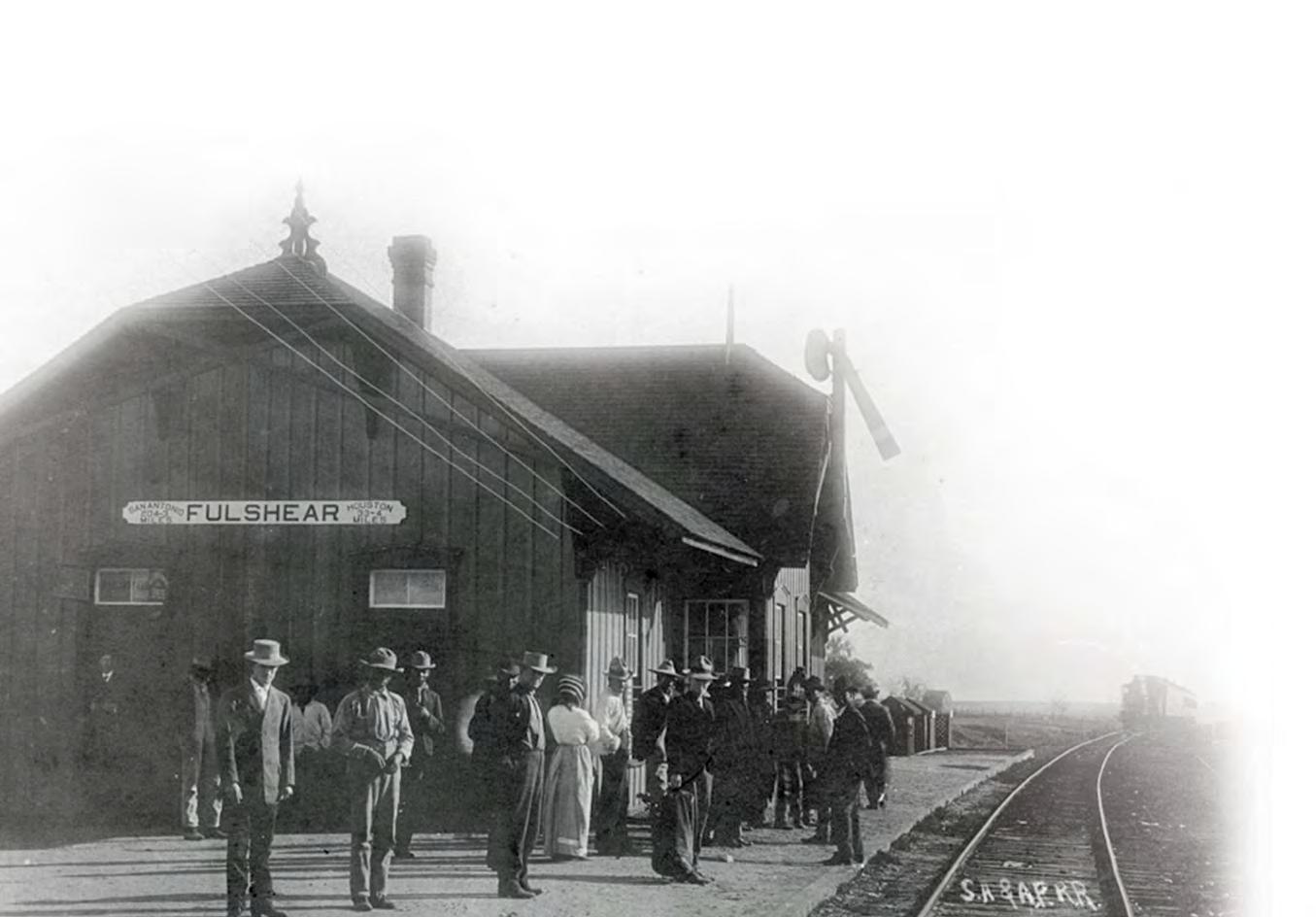
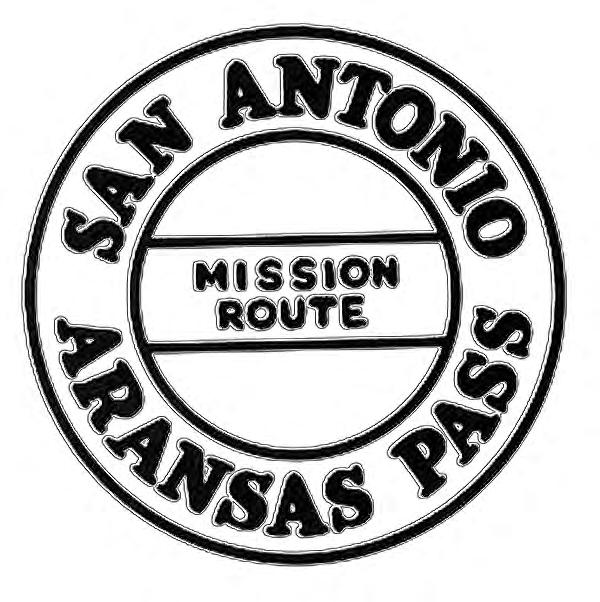
Churchill Fulshear Sr., was an “Old Three-Hundred” settler that had received a land grant from Mexico in 1824. He was the plantation owner and family patriarch that originally settled the area to the south of what would become Pittsville. By the 1880’s, his son, Churchill Jr. had inherited his father’s land, holdings, and fortune. More importantly, by all appearances, he had also acquired and refined his father’s business acumen.
There is no record of the conversations and negotiations that Churchill Jr. must have had in order to facilitate the railroad right-of-way and the transaction that made the railroad passing through his property a reality. Neither is there a record of Churchill Jr.’s plans, visions, or even his mindset related to advancing his own financial agenda. History does, however, record what happened in 1888 after Pittsville rebuffed the SA&AP Railroad’s offer. Churchill Fulshear was ultimately asked to provide the right-of-way for the new railroad.
In 1888, Churchill Fulshear Jr. decided to embrace the SA&AP Railroad by providing the railroad right-of-way through his property. This decision, combined with the economic coup that it would ultimately represent, must have set him apart from other area landowners. Having a railroad on property that he controlled would put his holdings on the doorstep of an ever-expanding marketplace.
The railroad could certainly put him in the position of leading the areas growth. So it was in 1890 that the railroad platted the town of Fulshear. Its footprint is forever memorialized in Fulshear’s downtown streets that are still in place today.
The new SA&AP depot in that was built in Fulshear was slightly more than three miles from Pittsville.
Although the SA&AP Railroad is no more, its impact reverberates even now, 124 years after Fulshear’s founding in 1890, in the Fulshear area’s mobility planning. FM 1093, for example, parallels the original SA&AP Railroad rail right-of-way. The presence of FM 1093 has led the way for many thousands of acres of development in and around Fulshear and to tens of thousands of acres to be developed in the growing cities beyond.
The corridor created by the railroad in 1888 has made a way for the improved mobility that has been provided by the Westpark Toll road. The investment made in this now-indispensable mobility corridor has been singly-responsible for increasing access to business, employment and shopping centers of Houston’s vibrant Galleria and Downtown areas.
The SA&AP Railroad certainly did set the stage for the growth that the City of Fulshear now enjoys and is, in many ways, still making plans to accommodate.
As a visionary, Churchill Jr. showed vision and judgment in his approach to doing business and improving access to
In 1890, the same year that Fulshear was laid out, the SA&AP Railroad went into receivership.
Churchill Fulshear, Jr. died in 1892, just two years after the town bearing his family name was founded.
In 1892, the same year that Churchill Fulshear, JR, died, the SA&AP came out of receivership at which time the Southern Pacific Railroad gained effective control of the SA&AP.
In 1992, one-hundred years after the death of Churchill Fulshear, Houston METRO acquired the SA&AP Railroad right of way, but allowed railroad operations to continue.
In 1996, one-hundred years after the Texas Western Railway ceased operations, the Southern Pacific merged with the Union Pacific Railroad.
Union Pacific continued to operate the rail line until 1999 - one hundred years after the Texas Western Railway was abandoned.
After Union Pacific ceased operations, METRO removed the tracks and sold most of the gravel ballast.
Fort Bend County is currently finalizing plans to acquire the railroad right-ofway from Houston METRO all the way to Eagle Lake.
After Fort Bend County takes ownership of the SA&AP Railroad right of way, Houston METRO will retain the right to someday utilize the corridor for future commuter rail.
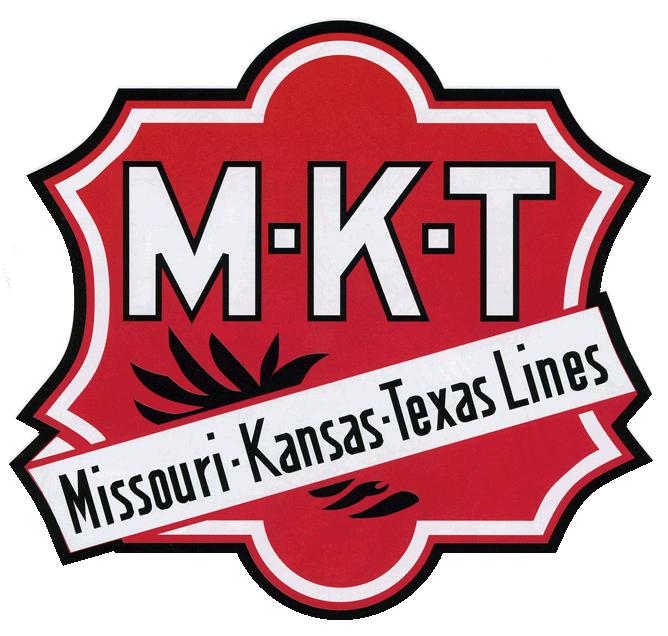
Jr. undoubtedly saw that a new railroad traversing the area would bring vast improvement to how he got products to market and how business was done in the area. He clearly wanted to be a part if it.
Even though the SA&AP Railroad had come through Fulshear in 1890, and clearly claimed its share of the railway cargo and passenger transportation market along its path, some might think that the Texas Western Railway would still be able to compete on some level. After all, farmers and ranchers in the areas in and around Sealy, Pattison, and Brookshire as well as those in Pittsville and Katy still had to get products to and from markets in Houston. Considering that the Texas Western Railway was still the best option to serve these areas due to the proximity of the railway, it is reasonable to believe that there must have been plenty of business for the Texas Western Railway, right?
By 1893, the well-financed Missouri-Kansas & Texas railroad (MK&T) had out-maneuvered the Texas Western Railway Company by entering Houston market area from Waco and into Sealy, Texas. By the time the MK&T railroad steamrolled into the area, their rail line was already providing rail service to San Antonio and passed through many of the towns to the west that the Texas Western Railway Company had previously planned to someday serve.
It must have been a dark day for the Texas Western Railway Company, when the MK&T railroad crossed westward from Sealy and continued laying their tracks. In a move that would sap what remained of the Texas Western railway’s business, the MK&T would establish Brookshire and then Katy as new railroad towns,
complete with their own depots along a much better railroad.
The new MK&T depot in that was built in Brookshire was just over four miles from Pittsville.
As fate would have it, the MK&T’s tracks intersected with the Texas Western’s tracks between Brookshire and Katy, in a location between what are now Woods and Igloo Roads near HWY 90. This symbolic severing of the rails, would end all hope of the Texas Western Railway recovering its former glory.
As often happens when technologies collide, there was no way to overcome the fact that the two intersecting railways were simply not compatible with one another. The Texas Western Railway was, from its inception, a narrow gauge railway. By definition, the distance between its rails utilized a 3’ 0” “narrow gauge” standard.
The MK&T, on the other hand, was created to be a “standard gauge” railroad. Its design utilized a wider track width of 4’ 8-1/2”. Being designed as a standard gauge railroad, the MK&T’s cars were considered more stable and potentially safer. Due to the improved rail standard, the MK&T’s trains had greater capacity and could achieve greater speeds. In short, the MK&T was a better railroad than the soon-to-be-outdated Texas Western Railway.
The differences between the gauges of their tracks meant that the two railway companies could in no way share the tracks. This unavoidable incompatibility certainly sealed The Texas Western Railway Company’s fate as there was no way to share the MK&T’s tracks.
Though it was once considered a useful and costeffective regional railroad, it took just sixteen years for the vision of the Texas Western Narrow Gauge Railway to be eclipsed and confounded by the opportunities and progress presented by the superior railroad technology.
In 1895, five years after the SA&AP Railroad came through the new “Fulshear” area, and just two years after the MK&T rolled into the new “Brookshire” area, the Texas Western Railway was sold. It ceased operations in 1896.
In 1899, twenty-nine years after it was originally promoted, and twenty-two years after it began serving the village of Pittsville, the once proud, state-of-the-art Texas Western Railway was abandoned altogether. By mid-summer of 1900, the tracks had been removed.
For its part, the village of Pittsville struggled to remain viable throughout the coming years. It is reported that after the SA&AP Railroad came through Fulshear that many Pittsville residents and business owners simply shifted their interests and their livelihoods to the newlyminted Fulshear community in order to take advantage
of the improved railroad and the expanding market it brought with it. The eventual exodus sealed the fate of the once-thriving village, relegating Pittsville to be recorded as a footnote to our area’s future and placing it on the path of relative obscurity.
It is reasonable to see how the SA&AP Railroad serving Fulshear, with its increased regional reach, higher speed, and better freight and passenger service, instantly became a better option for farmers and ranchers in the area than was the Texas Western Railway. As well, most would also agree that the MK&T entering the market just three years later, being well financed, spanning three states, and being equally close to Pittsville as was the Texas Western Railway, further sealed the community’s fate.
The issue that truly doomed Pittsville may have simply been the village’s own failure to choose well at a crucial “crossroad” moment. It might have been Pittsville’s own decision to pass up their best opportunity to adapt to the changes brought on by invention, innovation and technology that brought their community to ruin. A different decision would almost certainly have resulted in a different outcome. Had Pittsville embraced the SA&AP Railroad, we might be heralding the growth of Pittsville today instead of Fulshear’s bright future.
It was by the residents’ own choice, not by chance, that Pittsville failed to embrace the change that improvements in technology always bring. As Pittsville’s future ultimately passed it by, it was a lack of vision that brought the once hopeful and confident village to its ultimate decline and downfall.
Pittsville’s last residents are said to have simply migrated away from Pittsville to Fulshear and to Brookshire over the next fifty years. History records that the last residents left Pittsville in the late 1940’s, leaving little to be recovered.
Wisdom teaches that a lesson is best learned only once. By comparing the choices and decisions that Pittsville
and Fulshear each made, we see that the future rewards those who remain willing to pursue it. It is by being willing to support good vision with commensurate investment that a community
is able to keep pace with the opportunities and challenges that invention, innovation, and technology will always bring.
Today, Fulshear is growing, in part, due to the early vision and subsequent decisions of the City’s Founder, Churchill Fulshear, Jr. He deserves credit for the foundation on which Fulshear’s future is being built. Since the time of Churchill Fulshear, Jr., there have been many decisions made that have shaped the current City of Fulshear. Be assured, that in the coming years, there will be many more decisions to be made. Many of those future decisions will have equally significant potential outcomes.
In his ongoing commitment to work with others in order to shape the city’s future, Fulshear Mayor Tommy Kuykendall is continuing the tradition of visionary leadership. Along with the Fulshear City Council and the entire municipal staff at Fulshear City Hall, Tommy and his team are dedicated to capturing, communicating, and fostering the vision that Churchill Fulshear Sr. set into motion when he received his original land grant from Mexico over 190 years ago. Through such dedicated planning, Fulshear’s leaders will surely continue to provide for the growth that is now occurring in Fulshear.
Special Thanks to Jim Vollmar and Ken E. Stavinoha, Directors of the Rosenberg Railroad Museum, for their invaluable assistance and direction that provided important factual elements,that significantly improved the of accuracy and historical context of this article. Thanks also to Lisa Rickert, Program Director for the Rosenberg Railroad Museum, Chris Craven, and Glenn Fair for their assistance and railroad insight.
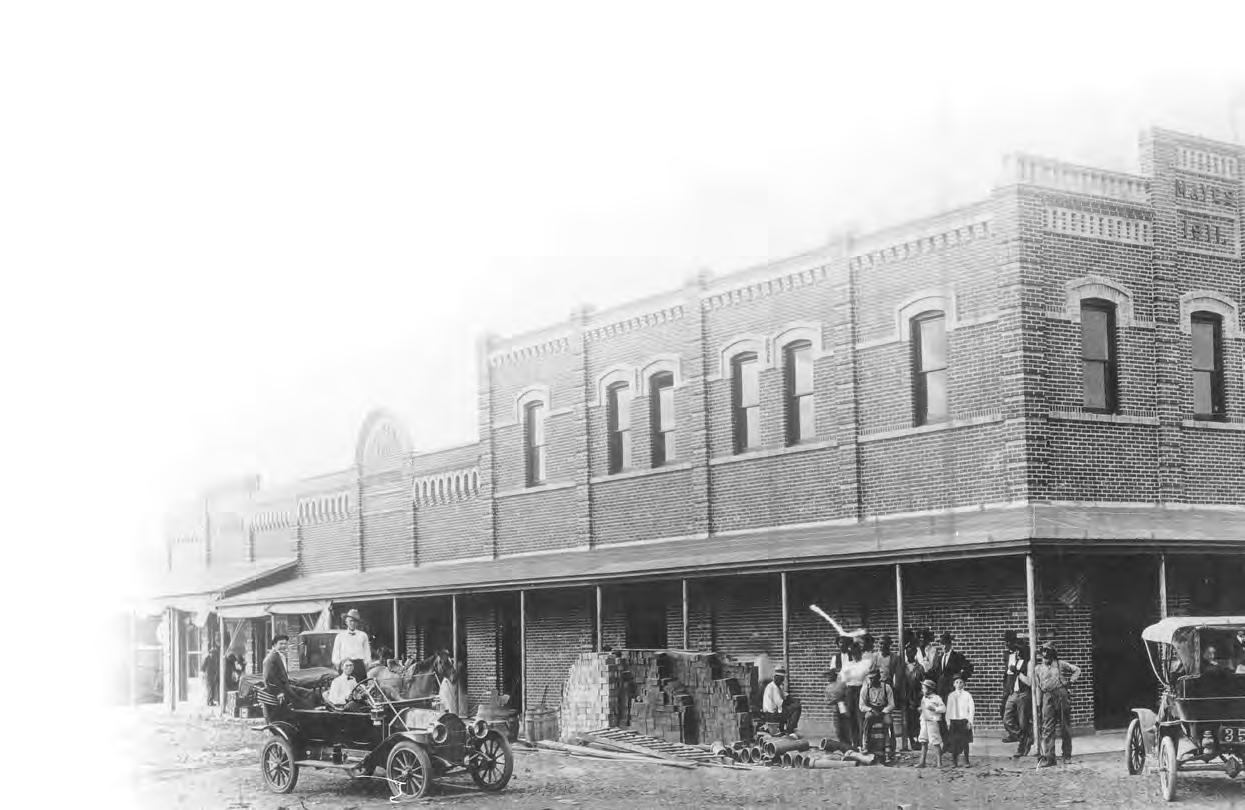

WRITTEN BY JACLYN RITTER
It can be said that the measure of a person is not how much they have achieved in their life, but how their achievement has improved the world they live in. This is the story of two such people, who through their mutual compassion and respect, with a combined appreciation for others, have made life better for many in need. Their friendship and kinship are a shining example in of how we can all make a difference within our community.
Gallery Furniture opened its third location on the Grand Parkway in June of 2015. With 165,000 square feet of floor space, this is their biggest location to date. Jim McIngvale, owner and operator of the stores, has turned this location into way more than just a furniture store, it is a destination. Jim, better known simply as Mack, is well-
known around Houston for so much more than just furniture – he is known as a giver. Mack is a giver of time, knowledge and money.
Yvonne Streit, founder of the Brookwood Community, knows Mack’s generosity first hand. He donated a large part of his new store to Brookwood, providing another location for its residents to sell their handmade goods and further support
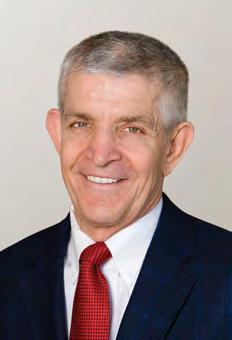
their community. This relationship stemmed from an appreciation and admiration of one another’s dedication to giving back. By teaming up, they are capable of making an even greater difference in the world.
Known for his fast talking commercials, fun giveaways and for his emphasis on great quality, “Made in America” furniture, Mack is not afraid of hard work.
From his humble beginnings in 1981 to building his wellestablished brand and world-class locations today, Mack has truly created something from nothing. Now, at a time in his life where he could easily take a step back to enjoy his accomplishments, Mack is just as present and dedicated to his business and to his customers as he was at the beginning. His committed work ethic is

unmatched as he regularly works fourteen hour days, seven days a week. This local icon’s energy and enthusiasm is infectious and no one knows the furniture business better.
Not only has Mack done an amazing job growing his business, but he has also done wonderful things to improve lives within his community. Mack shares his time, talents and resources as a mentor and motivator
for business students. He regularly steps up as a lifesaver for local needy families who are in need of something – sometimes something as simple as a bed. He is widely known for his work with Texas Children’s Hospital, Texas Medical Center and his work with the very first Mobile Stroke Unit. As many will remember, Mack even reached into Fulshear recently when Gallery Furniture donated all of the furnishings for the new Fulshear Police Department! These causes and generous donations do not even scratch the surface of the kinds of things Mr. McIngvale does on a routine basis.

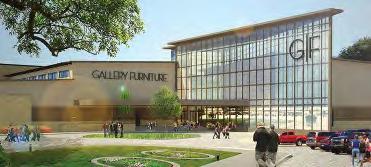
“My dad taught me that it is easier to give than receive,” says Mack. “I want to be known as a giver. I am a firm believer in “capitalism with a cause.” One cause that is very near and dear to Mack is the Brookwood Community.
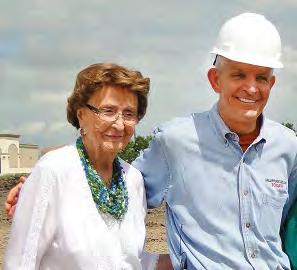
Yvonne experienced every parent’s fear, and through it all created a loving community that not only saved her daughter’s life, but thousands of others like her through the Brookwood Community. “It all started with God, He founded Brookwood and I worked for Him,” says Yvonne Streit, founder and Executive Director Emeritus of the Brookwood Community. Today, the community’s purpose is to provide opportunity through education for adults with special needs.
The Brookwood Community was born out of Yvonne’s personal tragedy. At the age of one, Yvonne’s daughter Vicki came down with the mumps. Due to unavoidable complications caused by the illness, her daughter was left with brain damage. Yvonne’s life instantly turned upside down. Her focus turned to finding a loving and safe environment where Vicki could learn necessary life skills. When she could not find it, Yvonne began working tirelessly to create it.
Yvonne’s solution started small as she began homeschooling Vicki. This soon grew into a learning group that included other local children with special needs. Over time the learning group outgrew Yvonne’s backyard and the group was graciously welcomed by a nearby Baptist church. It was not long before the church also had become too small, as word spread about Mrs. Streit and her efforts to help young people with special needs. It was a joyous day indeed when the Brookwood Community opened its doors in 1985. Today, the Brookwood Community is an internationally known example of how one dedicated person with a vision can make a difference and change lives throughout the world.
Not only does Brookwood provide a loving and welcoming community for its residents, but also the opportunity to work. Whether they work in crafts making handmade unique gifts, or in the greenhouses, nursery, café or gift shop, each resident walks away with a sense of pride, knowing that they are useful and they are contributing to the world.
“Individuals with special needs learn differently,” notes Yvonne. “They are a square peg, and society is trying to fit them in a round hole. So we built them a square hole.” Like all people, they want to have a purpose, and Brookwood gives them that purpose.
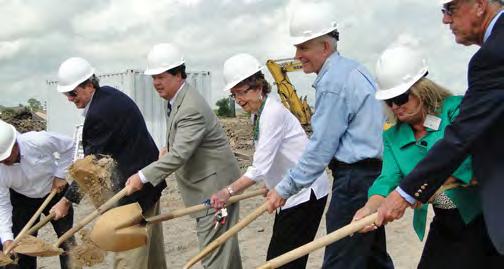
Years ago, Jim McIngvale was invited out to Brookwood to do a walk through and voice any retail ideas that could help them grow their cause. After just a few visits,

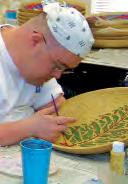
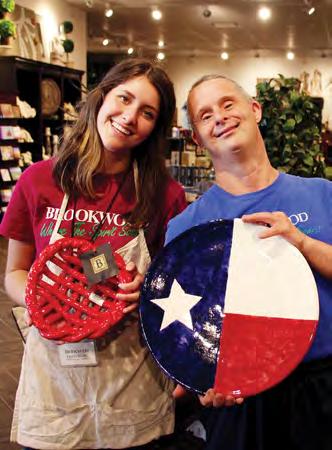

Mack became a huge Brookwood fan. “I am amazed by the energy Yvonne has, and the passion she has for each and every resident,” says Mack.
While they may seem like an unlikely pair, Mrs. Streit and Mr. McIngvale have one big thing in common –their dedication to providing jobs for those who need them. “When you go to Brookwood and see how giving someone a job can improve their self-esteem and view of self-worth, you know that that is what it is all about,” shares Mack. “I believe that work is life’s greatest therapy. It saved my beautiful daughter Elizabeth’s life.” Elizabeth was told due to her severe obsessive compulsive disorder she would never graduate high school. She worked hard to prove every doubter wrong and went on to earn a PHD in social work. “When she became a social worker it gave meaning to her life.” Mack goes on to say, “People need meaning in their lives and meaning comes through work.”
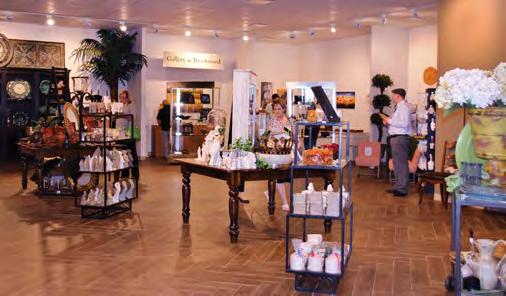
“I believe in Brookwood because they value work like I do,” Mack shares. “Of course I want to make money, but I also want to make a difference.” When it came time to design the new Grand Parkway Gallery Furniture, Mack was quick to sit down with Yvonne and share with her a unique plan to help introduce people to the great products and people that make the Brookwood community so special. Subsequently, Mack generously donated 12,000 square feet of space to the Brookwood Community where residents can create and sell the goods they produce. One hundred percent of the
money earned goes right back to the community. In fact, Gallery Furniture even covers all of their utilities. “Mack does these wonderful things behind the scenes and does not get enough credit for them,” says Yvonne. “He is a true community leader with integrity and forth rightness.”
Yvonne Streit has helped the world see that individuals with special needs have special gifts. They, like anyone else, have the right to feel like a citizen, one who has purpose and gives back. Jim McIngvale is proud to know her. “She is fighting for these people,” he says. “When society tells them they can’t, Yvonne is there telling them they can!”
The Brookwood Community has changed the world and has become the premier facility for adults with special needs. Through his platform, Mack has helped spread the word and share the community’s vision. He still remains one of Brookwood’s biggest fans.

THE BROOKWOOD COMMUNITY
1752 FM 1489 - Brookshire, TX 77423 281-375-2100
www.brookwoodcommunity.org

7227 West Grand Parkway South Richmond, TX 77407 (281) 810-9746
www.galleryfurniture.com

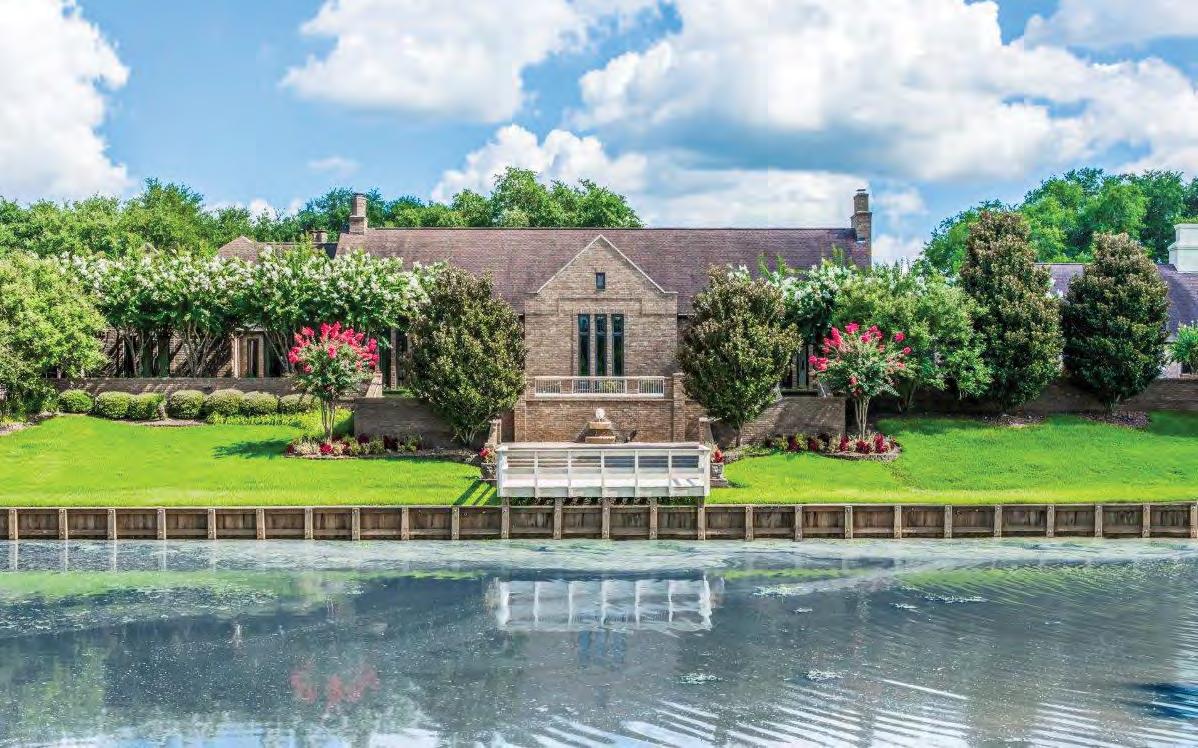


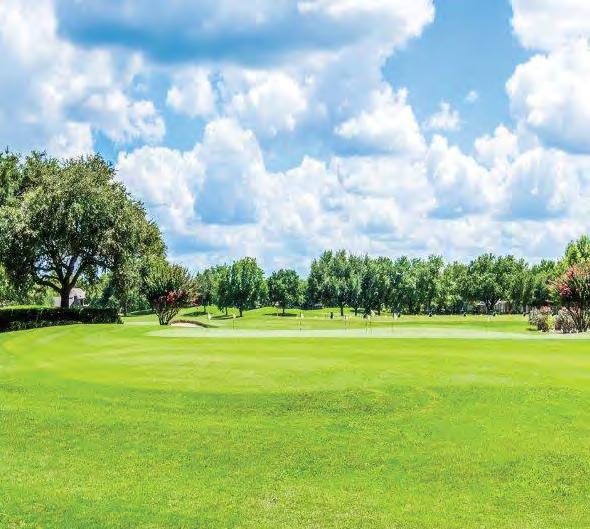

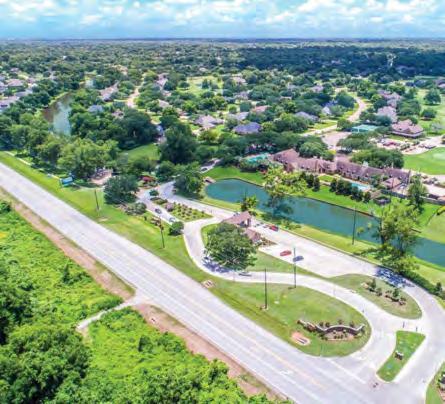
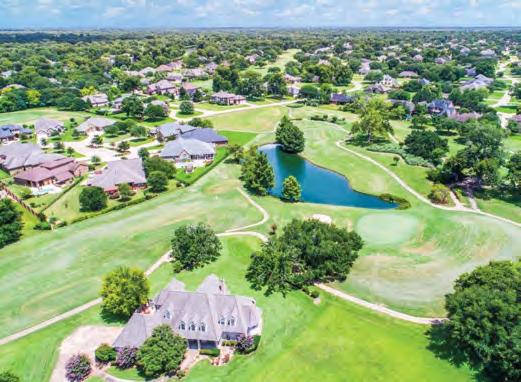
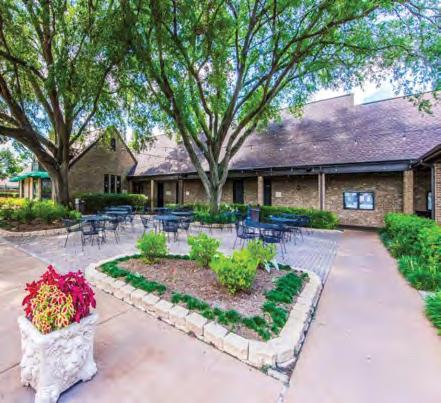





Buzz into our Hive for a memorable, one-of-a-kind shopping experience. Enjoy chic apparel & accessories, unexpected gifts and statement pieces for the home all from different curators, designers and artisans, including four from our very own area!
Gretchen Gilliam (Co-Owner) / Glamour Gypsies / Fulshear Resident
Dulce A. David (Co-Owner) / My Sweet Cannella / Richmond Resident
Heidi Hanson / Heidi Houston / Katy Resident
Melissa Rubio / Bellitude / Katy Resident


ARA’S BARBERSHOP
(346) 667-9545
11525 S FRY RD STE 105 • FULSHEAR WWW.ARASBARBERSHOP.COM
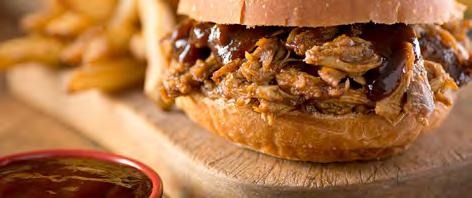
DOZIER’S BBQ
(281) 346-1411
8222 FARM TO MARKET 359 • FULSHEAR DOZIERSBBQ.COM

ESSENCE HOUSE CAFE (281) 533-0255
8506 FARM TO MARKET 359 • FULSHEAR ESSENCEHOUSECAFE.COM

CHRISTIAN BROTHERS AUTOMOTIVE (832) 648-1443
6150 FM 1463 • KATY CBAC.COM

EM’S PHO (281) 346-8250
6420 FM 1463 #800 • KATY EMSPHO.KWICKMENU.COM

FULSHEAR ACE HARDWARE (281) 533-8571
8411 FM 359 • FULSHEAR WWW.ACEHARDWARE.COM

HAPPY TRACKS TRAVEL
(832) 507-2030 FULSHEAR, TX

HUMBLE GROUNDS COFFEEHOUSE (346) 387-6199
11525 S FRY RD #110 • FULSHEAR HUMBLEGROUNDSCOFFEE.COM

(832) 437-5317
11525 S FRY RD SUITE 101 • FULSHEAR EATATLOCALTABLE.COM

6300 FM 1463 SUITE 500 • FULSHEAR MOLINASCANTINA.COM LOCAL TABLE
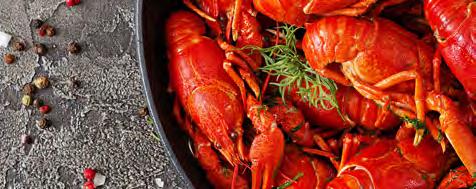
(346) 688-5600
6230 FM 1463 SUITE 550 • FULSHEAR ORLEANSSEAFOODKITCHEN.COM

WWW.HAPPYTRACKSTRAVEL.COM SANDEFUR CPA
(281) 533-0911 30502 2ND STREET • FULSHEAR WWW.SANDEFURCPA.COM

8525 FARM TO MARKET 359 • FULSHEAR WWW.VICTORSMEXICANRESTAURANT.COM ORLEANS SEAFOOD KITCHEN
8502 FARM TO MARKET 359 • FULSHEAR PIER36SEAFOOD.COM MOLINA’S CANTINA (832) 789-6450
36 SEAFOOD & OYSTER BAR (281) 346-8379

MEXICAN GRILLE (281) 533-0040
